Some posts on this site contain affiliate links. If you book or buy something through these links, I earn a small commission (at no extra cost to you). Take a look at my privacy policy for more information.
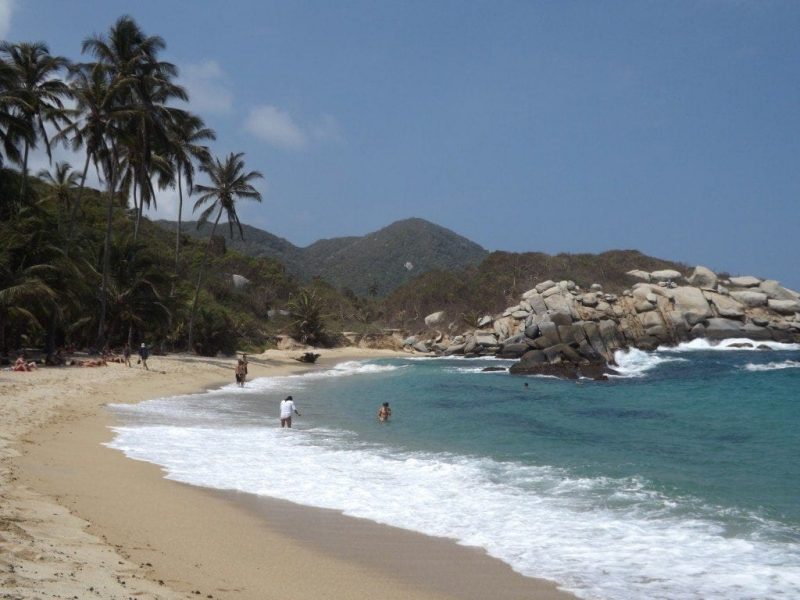
Wayyyyyyy back in 2014, I spent five months backpacking through South America with my then-boyfriend. The trip started in Colombia, where we spent about five weeks before sailing into Peru along the Amazon River.
Throughout the trip, I wrote blog posts and shared them almost in real-time as we went. Those posts are now nearly a decade old, so are probably too out of date to be of any use to other travellers.
They’re also embarrassingly bad: I like to think I’ve improved a lot as a writer in the last decade! This was before I knew anything about blogging or became a full time blogger, before I knew what I wanted this blog to be. I was just bashing out nerdy little diary-style blog entries on the fly, sometimes trying (without much success) to be all creative and poetic like a high-brow travel journalist, at other times just sounding like an excited child.
Realistically, these blog posts don’t have a place on my site any more. But that South America trip was a huge chapter in my life – as well as in the history of this blog. These blog posts are part of the journey that brought me to where I am today. So instead of deleting them all, I’ve gathered them all up, in order, onto one page.
Honestly – I’m only keeping these blog posts here for me, because they have so much sentimental value! I’m only writing this intro in case anyone stumbles upon this page and wonders why they’re suddenly immersed in a bunch of childish diaries (many of which start with what I had for breakfast and go downhill from there). Don’t judge me, I was young and excited!!
So without any more self-deprecating rambling, here are my Colombia diaries in all their pure, naive glory…
- First Day in Bogota
- Best of Bogotá
- Zipaquira Salt Cathedral
- Paragliding in Bucaramanga
- Camping, Hiking and Snorkelling at Tayrona National Park
- Information about Visiting Tayrona
- Magic in Minca – Cascadas Marinkas
- Minca, Part Two: The Seven Hour Hike
- Minca, Part Three – More Waterfalls and Taking the Plunge
- Carnaval in Barranquilla
- First Day in Cartagena
- Playa Blanca, Cartagena
- Volcan de Lodo El Totumo in Cartagena
- Arriving in Salento
- Hiking the Valle de Cocora in Salento
- Horserides and Waterfalls in Salento
- Sailing the Amazon River – Colombia to Peru by Boat
- Sailing the Amazon River: Day One
- Day Two: Colombia to Peru by Boat
First Day in Bogota
First published: 15/02/2014
WE’RE IN COLOMBIA! Finally, after a year of planning and saving, we made it to South America!
We landed on Wednesday evening and spent the first couple of days in Bogota lazily recovering from jet lag and generally relaxing ready for the start of our five-month-long adventure in South America.
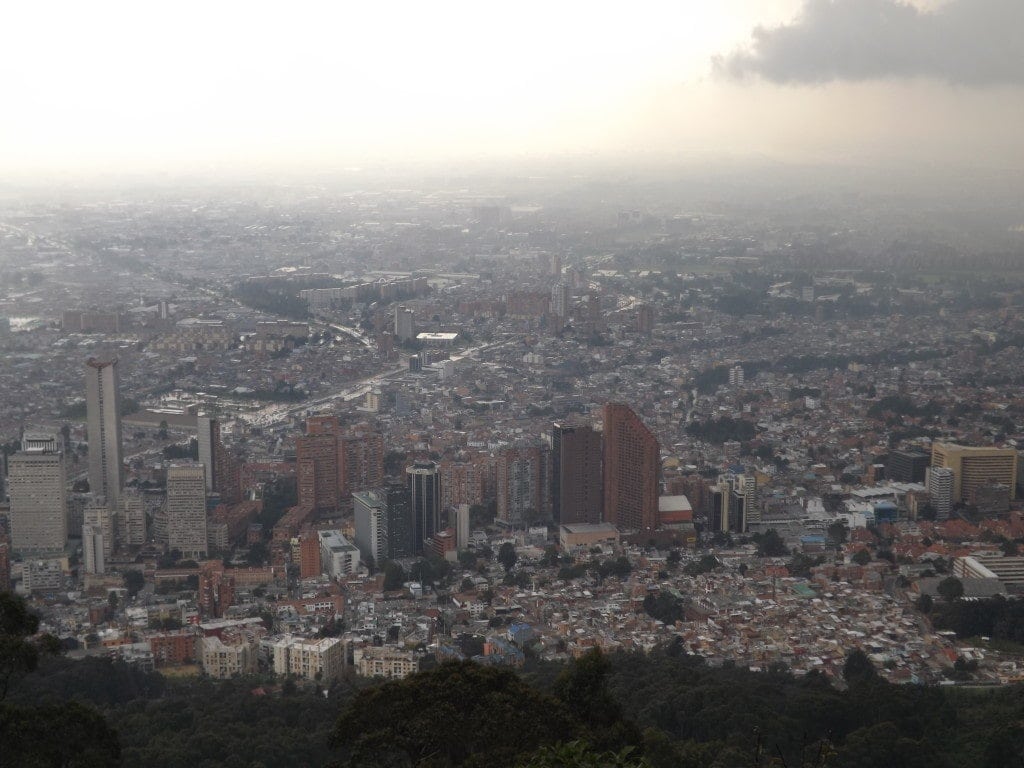
Thursday was our first full day in the city, so after a long lie in and a breakfast that our malaria medication hardly let us keep down, we took a very long walk around our hotel’s neighbourhood, which is fairly quiet, filled with red brick apartment buildings and lots of green parks.
Once we’d managed to get ourselves fairly lost, passing one of the shabby slums on the outskirts of the city and accidentally walking half-way up the wrong mountain, we eventually hopped in a taxi to the base of Cerro Montserrate.
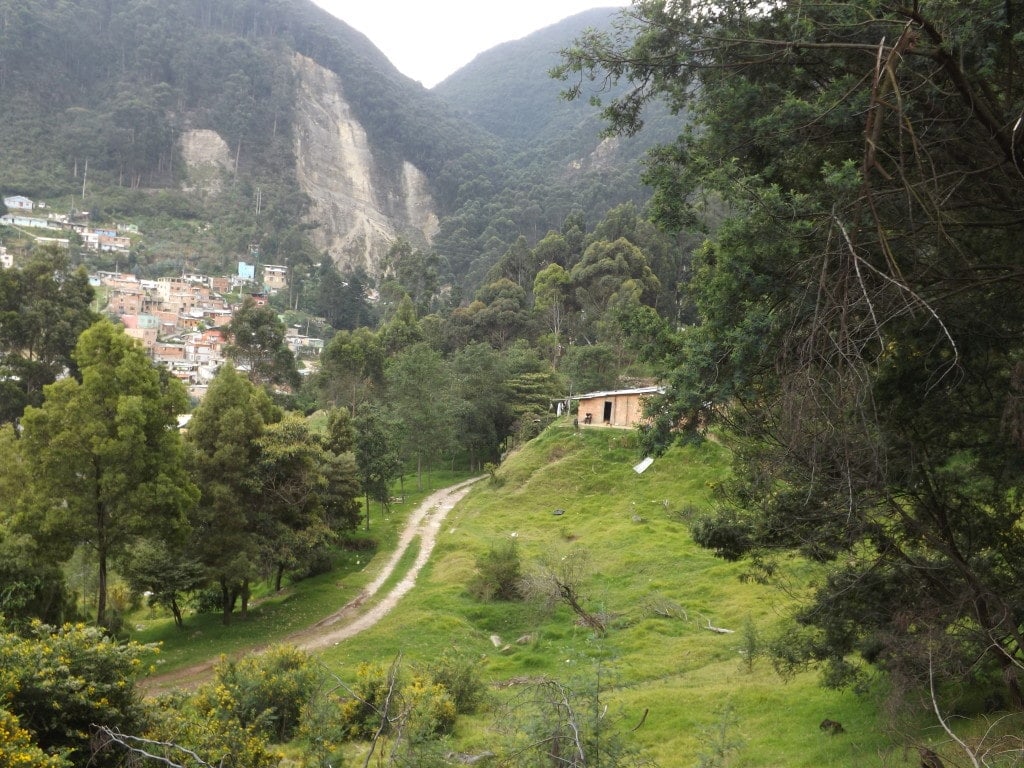
After an incredibly steep and slightly heart-pounding cable car ride to the top of the mountain 3,200 meters above sea level, we were blown away by the incredible views across the city, which is far bigger than I ever imagined.
As you can see, the day was pretty cloudy with a thunderstorm rolling in over the city below us, but the views were still spectacular.
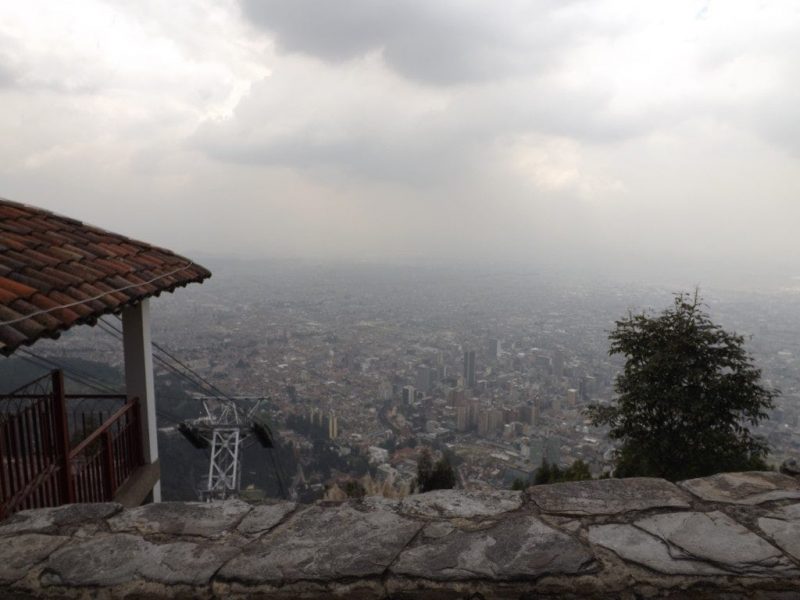
We explored the church and the gardens, accidentally stumbling into the middle of a sermon inside the church, and had lunch in the beautiful Santaclara restaurant, an old colonial-style building with crumbling white paint perched right on the edge of the mountain.
The views from the windows were fantastic, and while we ate we were serenaded by two musicians playing a mixture of guitar and flute – sometimes at the same time!
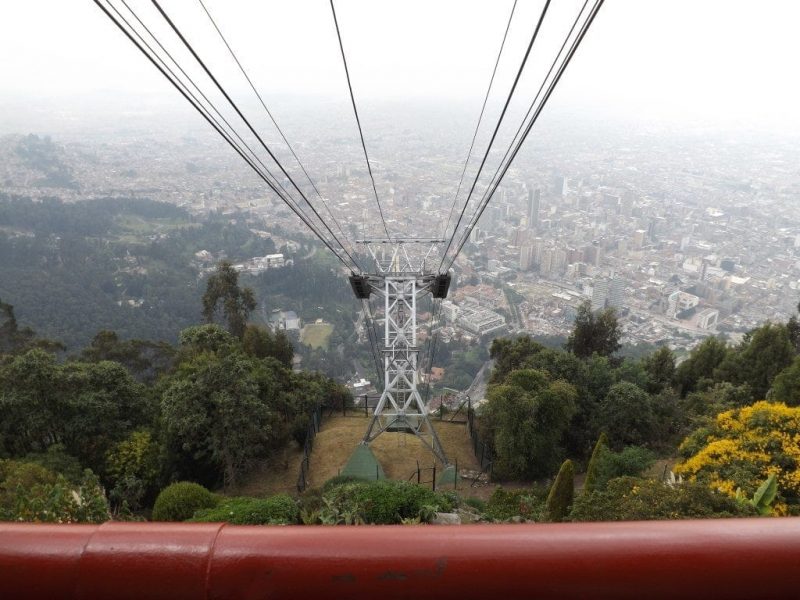
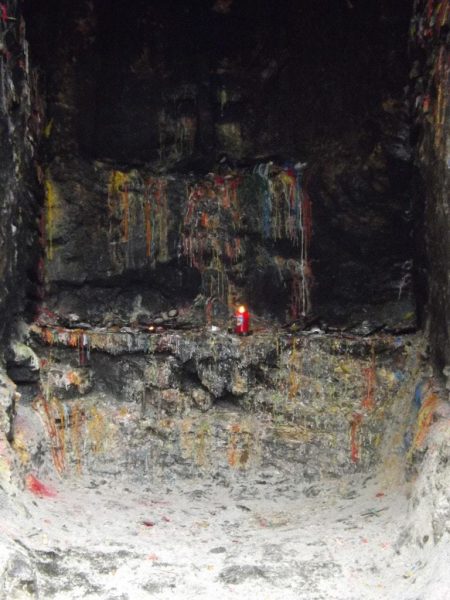
After lunch, we walked down the mountain – a surprisingly tiring and difficult feat on very steep stone steps which seemed to go on forever. Apparently, on Sundays the locals of the nearby La Candelaria district walk up the mountain to attend mass – one guy we spoke to said the walk takes about an hour. Since I spent all of Friday with seriously aching leg muscles after our descent, I seriously doubt I could make the walk up – everyone we passed looked about to drop.
It was a fabulous first day that introduced us to the stunning backdrop surrounding Colombia’s impressive capital city. Many more adventures to come; I can’t wait!
Best of Bogotá
First Published: 21/02/2014
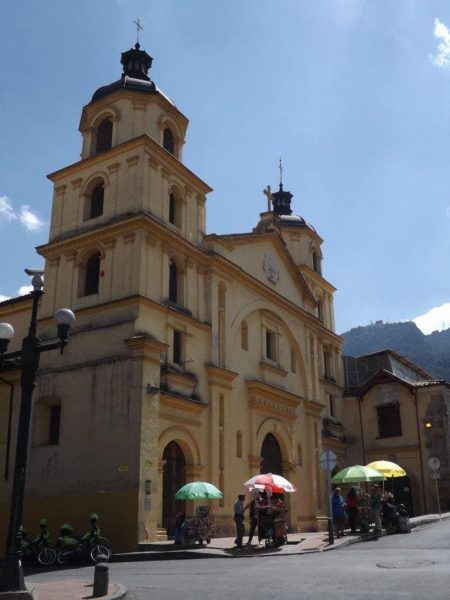
We’ve been in Bogotá for a few days now and have seen a lot of the city! We started out staying at the truly gorgeous Casa Gaitan Cortes, in the trendy Zona-G neighbourhood which is a fairly quiet, upmarket district with lots of cool restaurants, bars and clubs.
After two nights of luxury, we had to drag ourselves away to kick off the budget travel experience, but luckily our hostel – Lima Limon in the historic district of La Candelaria – is really nice. La Candelaria is the old colonial neighbourhood – narrow streets lined with antique buildings with brightly coloured, peeling façades – so it’s really pretty, and is also pretty artistic, filled with students and loads of lively, intimate bars.
On our first day, we ventured to the top of Cerro Monserrate, the huge, dark-green forested mountain towering above Bogotá, to orientate ourselves and experience the breathtaking views across the city. We’ve spent the last couple of days exploring La Candelaria, where there are tons of popular tourist sights…
Plaza de Bolívar
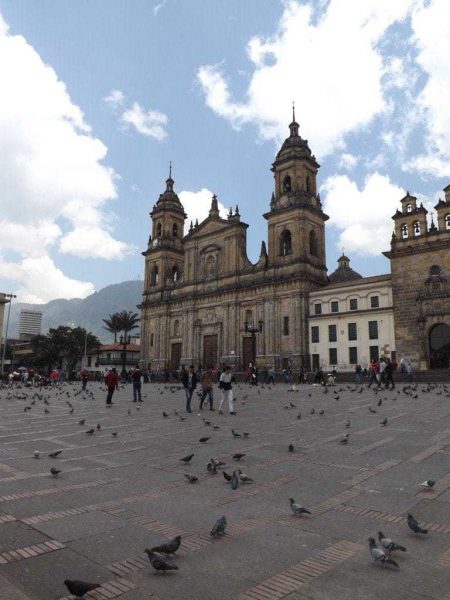
This is one of the focal points of any tourist trip to the city, and is one of Bogotá’s main squares. There are quite a few tourist attractions around the square and surrounding area, including the Palace of Justice, the National Capitol (where the Colombian Congress is located) and the Primary Cathedral of Bogotá – a stunning Colonial cathedral built at the beginning of the 19th century – while nearby are the Parliamentary buildings, the president’s mansion, and a number of museums. The square’s statue of Simon Bolívar – South America’s liberator and hero after whom endless streets, schools, buildings and towns are named (not to mention a whole country – Bolivia) – was built in 1846 and was the first public monument in the city. In spite of having more pigeons than Trafalgar Square, the Plaza de Bolívar was a great place to sit and watch the world go by.
Museo del Oro
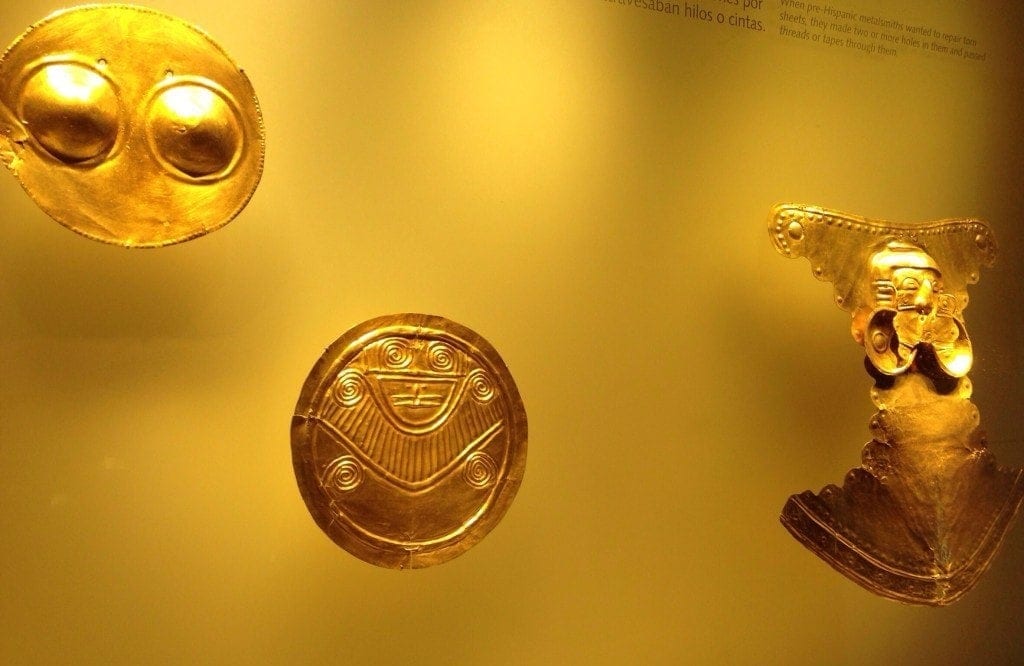
One of the best collections of gold in the world, the Museo del Oro (gold museum) in Bogotá is pretty impressive. There’s a huge collection of gold artefacts – as well as some silver, bronze and platinum – from Colombia’s ancient civilisations. Entrance is really cheap, at just 3,000 COP (about £1) per person – and it’s free on Sunday’s – so this is a great cool, quiet and fascinating place to escape the midday heat and while away and hour or two browsing the ancient art works. I had a great time eyeing up all the gold – especially the jewellery – and also learnt quite a bit! I was especially interested to learn about the ancient tradition of throwing gold and emeralds into a lake from a barge as gifts to the gods, a tradition which supposedly gave rise to the legend of El Dorado.
Museo del Botero
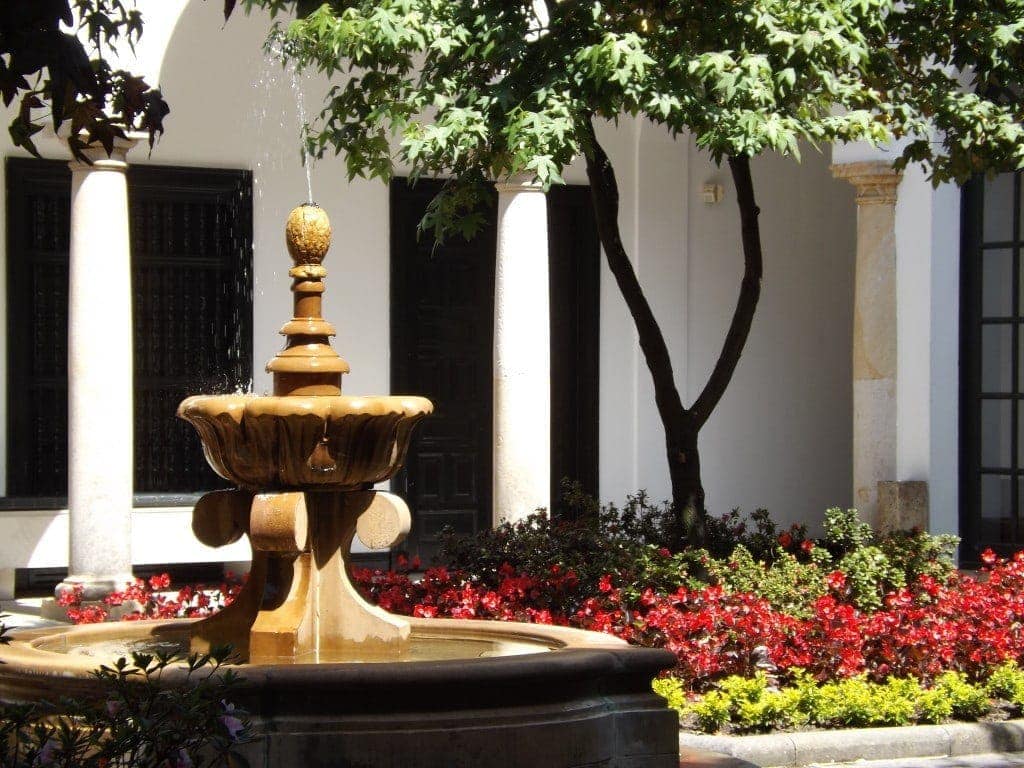
This museum, with the largest collection of Colombian artist Fernando Botero’s work anywhere in the world, was free to enter and set in a gorgeous, cool, colonial building surrounding a tranquil courtyard. I have to admit, I’m not a huge art fanatic, but the museum was a really nice place to stroll around and escape the midday heat. Botero’s style, termed Boterism, depicts people and figures in exaggerated volume – aka fat. Not being art critics or particularly serious people, Sam and I had quite a lot of fun laughing at the cartoonish paintings and sculptures of fat nude women, portly moustache-od men, and overweight animals (I loved the fat cat sculpture). There’s also a pretty impressive collection of works by other artists – including Freud, Matisse and Picasso – which were donated to the museum by Botero himself.
Museo de Policia
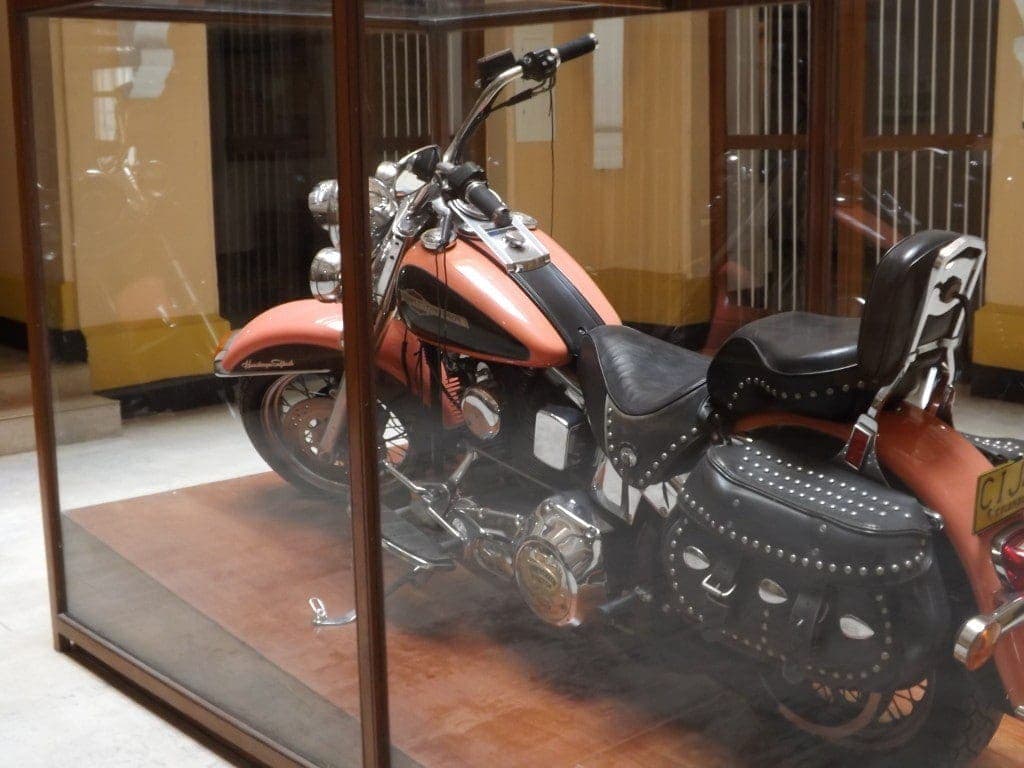
Although it wasn’t particularly brimming with fascinating treasures or artefacts, the fairly nondescript museum of the National Police was probably one of my favourite stops in Bogotá. Our guide, like all the museum’s staff and numerous other police on patrol in the tourist areas of Bogotá, was a member of the Auxillares – Colombia’s obligatory military service. At age 18, everyone must perform two years of military service – either in the National Police or the Army. People who complete secondary school, like our guide, seem to be given the easier jobs like working with the museum and aren’t trained to use a gun – something our guide looked a little sad about – while those who fail or drop out are given full military training and are able to use weapons. There were a few interesting artefacts in the museum, like guns and a motorbike confiscated from Pablo Escobar and his family, as well as hundreds of different guns in the arms room – but the real interest was in hearing the facts and stories from our lovely guide.
Zipaquira Salt Cathedral
First Published: 25/02/2014
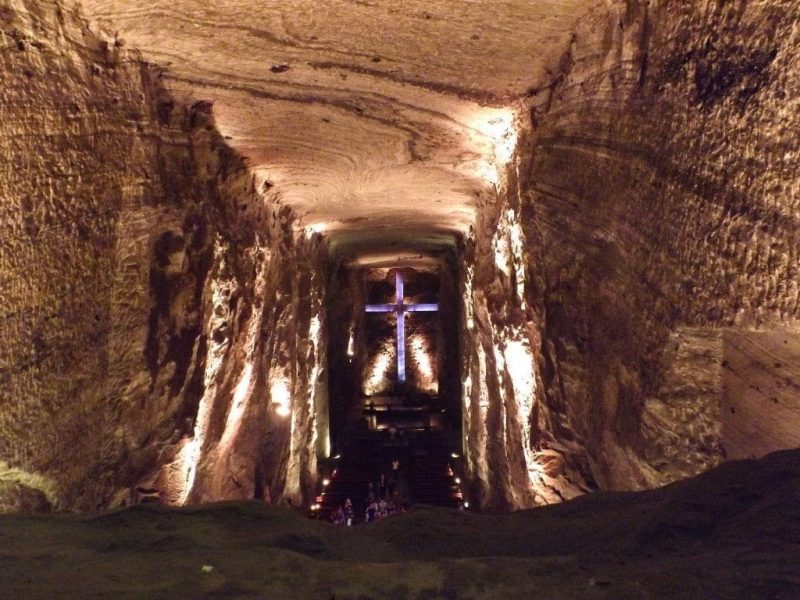
On Sunday last week, we hopped on a bus to Zipaquira, about two hours north of Bogotá, to head into the salt mines and see the famous salt cathedral (info on how to get there at the bottom of this post).
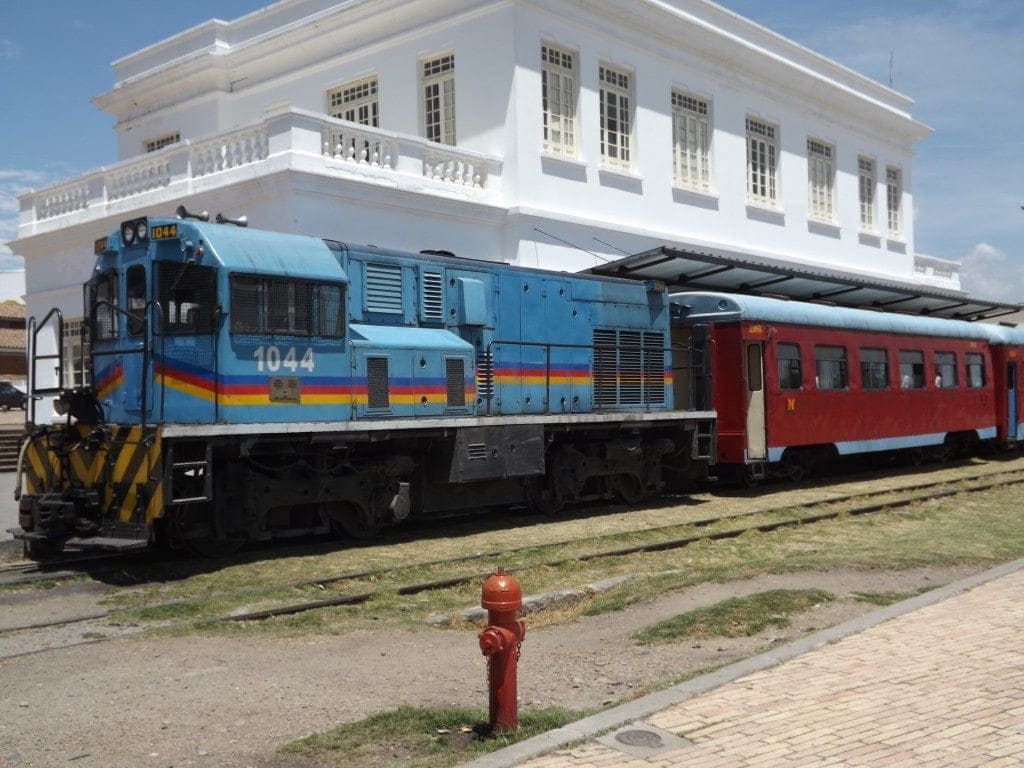
The bus dropped us off close to the city centre, and we took a short walk past the colourful Turist Tren (another transport option, which runs between Bogotá and Zipaquira on Sundays) up to the main square of the city’s old quarter which is lined with some beautiful colonial buildings including a lovely, crumbling cathedral. Zipaquira is much smaller and far more laid back than Bogotá, with fairly empty streets even on a Sunday, so it made a nice place for a walk.
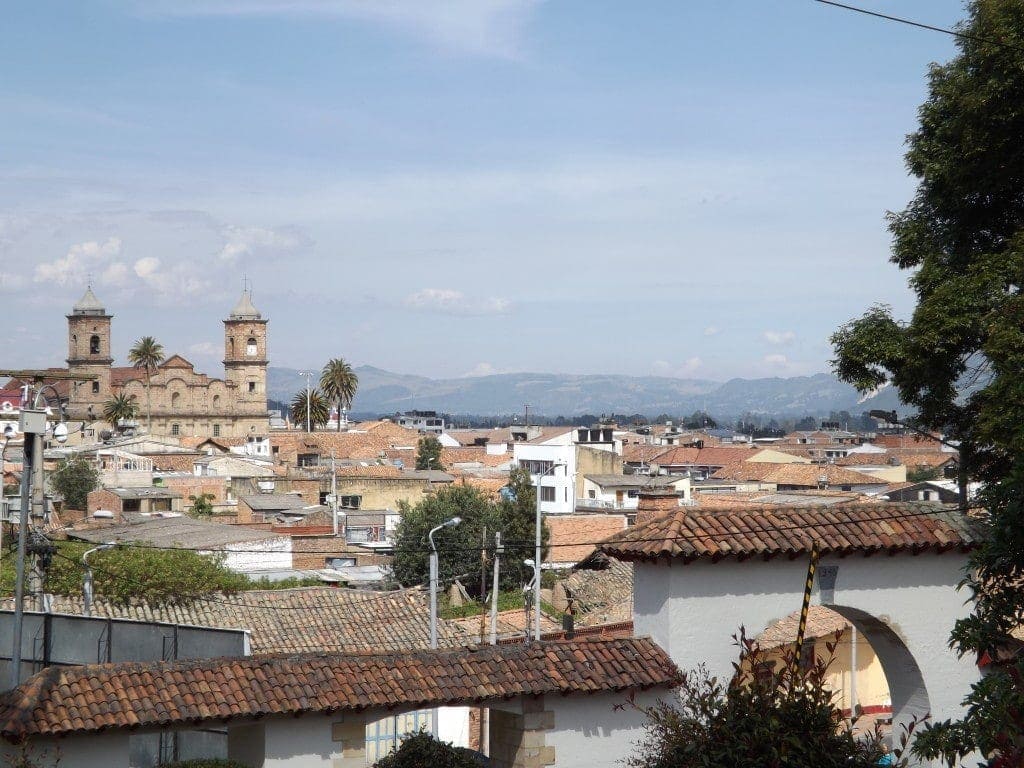
The entrance to the salt mine is easy to find from the main square. From the entrance up to the mine itself is a short walk up a fairly steep hill, which wasn’t that much fun in the bright midday sun, but we made it to the top red faced and sweaty and bought our tickets for the salt mine (after stopping for a well deserved ice cream).
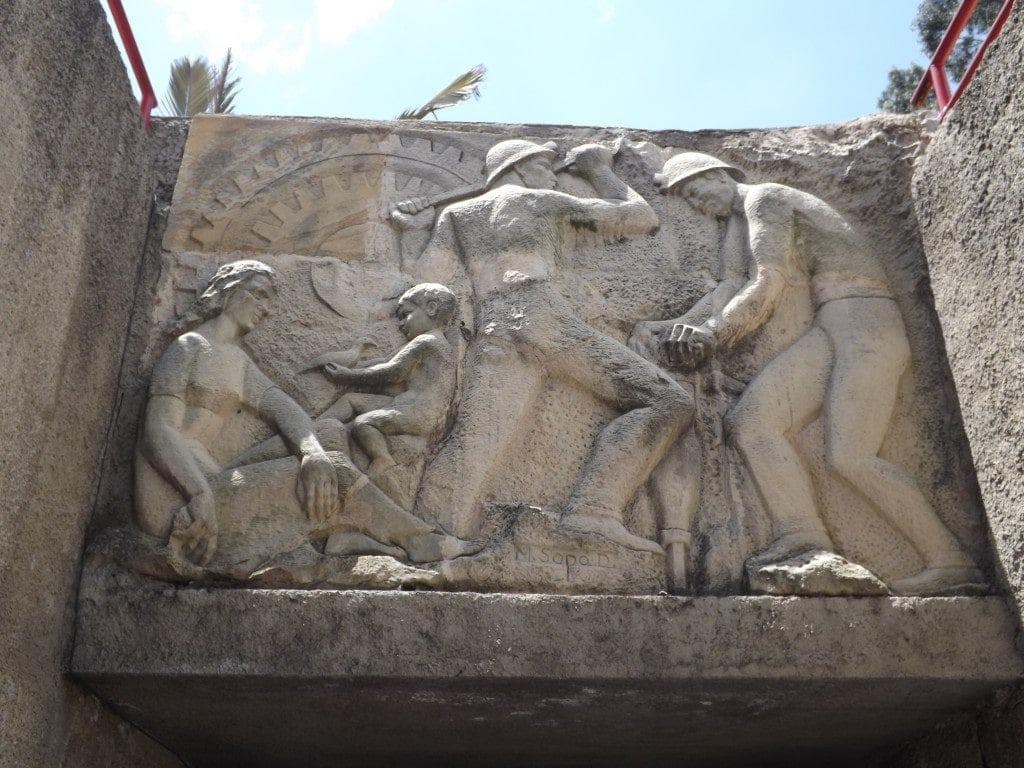
We followed a long, shuffling queue towards the gaping, cave-like tunnel entrance to the mine. Inside it was pretty dark, and cool straight away which was a relief to my burning skin. The walls are caked in lumps of smooth, white crust and even the bare rock clearly contains a lot of salt – we licked our fingers after touching the walls and the taste is unmistakable!
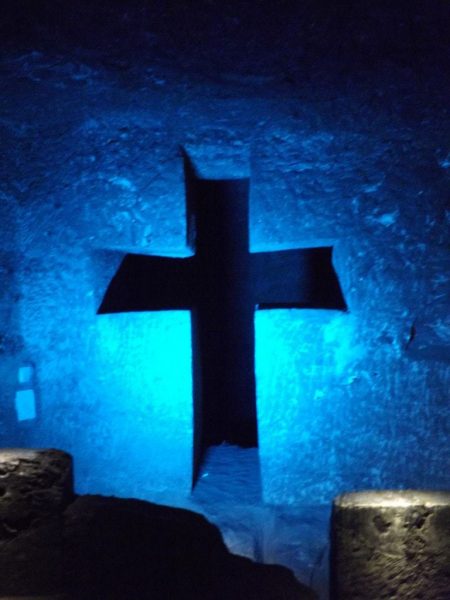
Inside the mine, which is the largest salt mine in the world, an enormous cathedral has been built. We followed the underground trail along, passing numerous carved crosses in different forms which symbolised the story of Jesus falling three times – with the crosses set at the bottom of some stone steps for when he fell, or a hollow cross set into the wall to symbolise when he was stripped of his garments. Each cross was enormous and was brightly lit in soft blue, green or purple which gave a really cool effect in the darkness. The crosses set down from the path, for each time Jesus fell, were in front of enormous caverns which were so big and dark you could barely see the bottom or the far end, which I assume are the areas which have already been mined for salt.
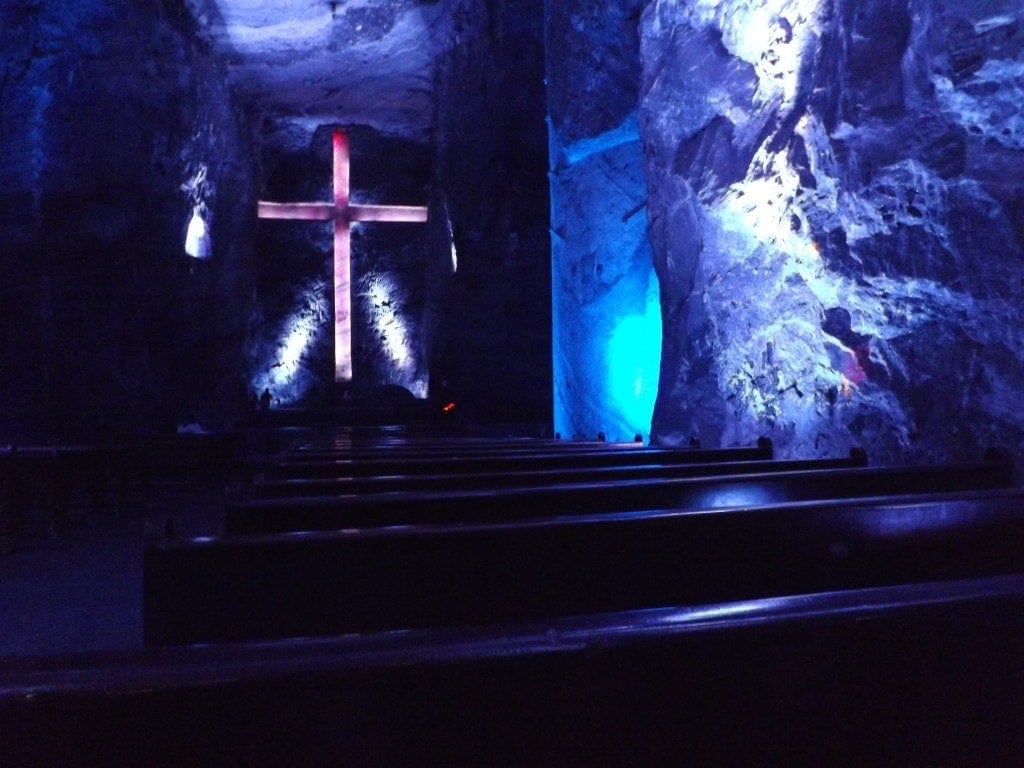
At the end of the trail, we reached the back of the cathedral proper. The first view came from the back, on a raised balcony watched over by an angel with a horn; from this we could see the final cross – utterly enormous and lit in ever changing colours – which stood proudly at the back of a cavernous space, behind an alter, facing the rows of benches. The salt miners would have at one time spent every Sunday here for mass, and in fact it is still a working church with services (although without a bishop, it actually has no official status as a cathedral).
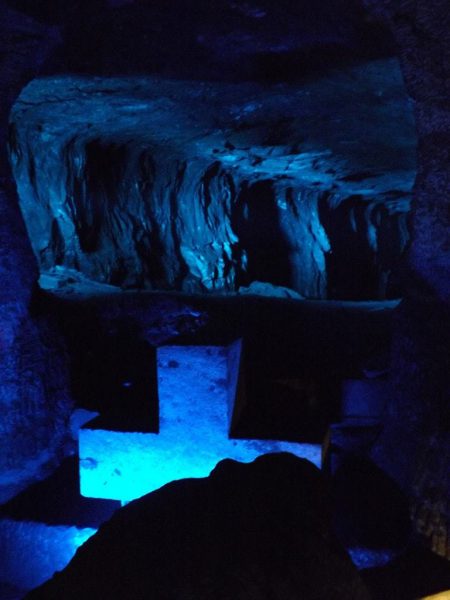
We spent a couple of hours underground, exploring the tunnels of the temple and the beautifully hand carved sculptures representing the birth, life and death of Jesus, before emerging blinking into the bright afternoon sunlight and heading back down the hill to the town.
We ate lunch in a small restaurant where they cooked the meat over an open fire in the back garden, before making our way back to the bus stop and catching a long, overcrowded and incredibly bumpy bus back to Bogotá.
Information
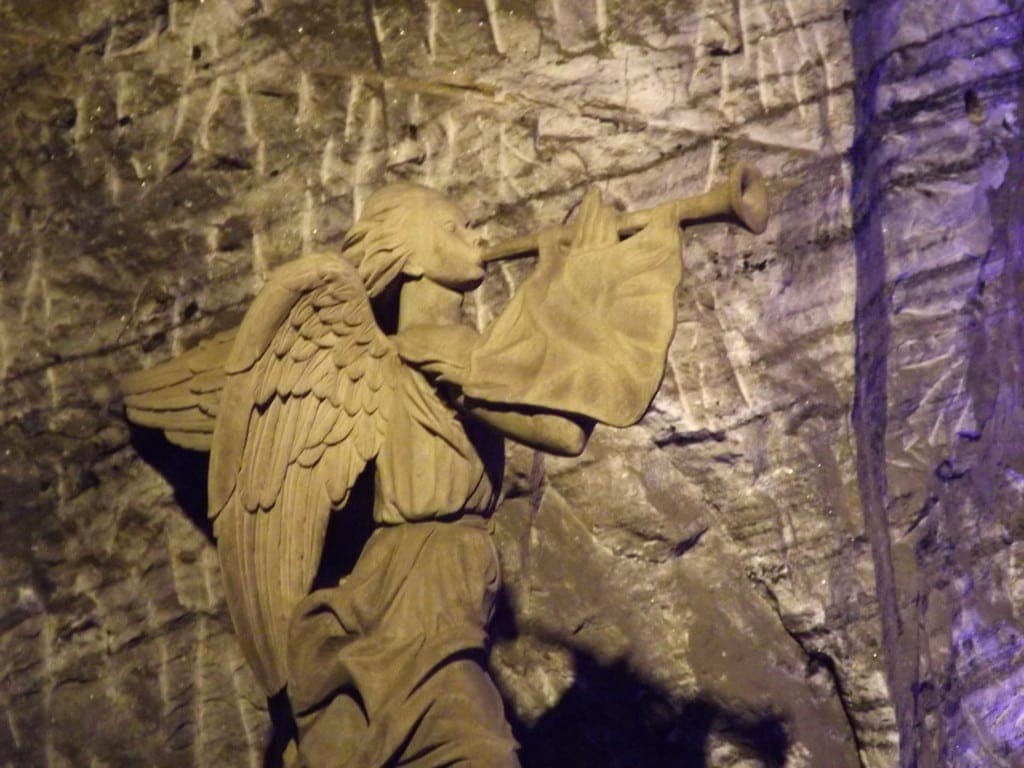
You can take a bus from Bogotá’s main terminal, Terminal des Transportes, or La Terminal. A taxi ride to La Terminal from La Candelaria neighbourhood takes about 20 minutes and costs about 20,000 COP (roughly £6). The bus ride to Zipaquira (they call it Zipa) costs 4,300 COP each way with Alliance and takes just under two hours (about an hour of that is spent leaving Bogotá). Tell the bus driver you’re going to the salt mine and he will let you out of the bus in Zipa’s centre, rather than at the bus terminal which is about 20 minutes outside. From where the bus stops, walk up to the main square then take a left and follow the road straight down till you reach the entrance to the salt cathedral. The walk from here is clearly marked.
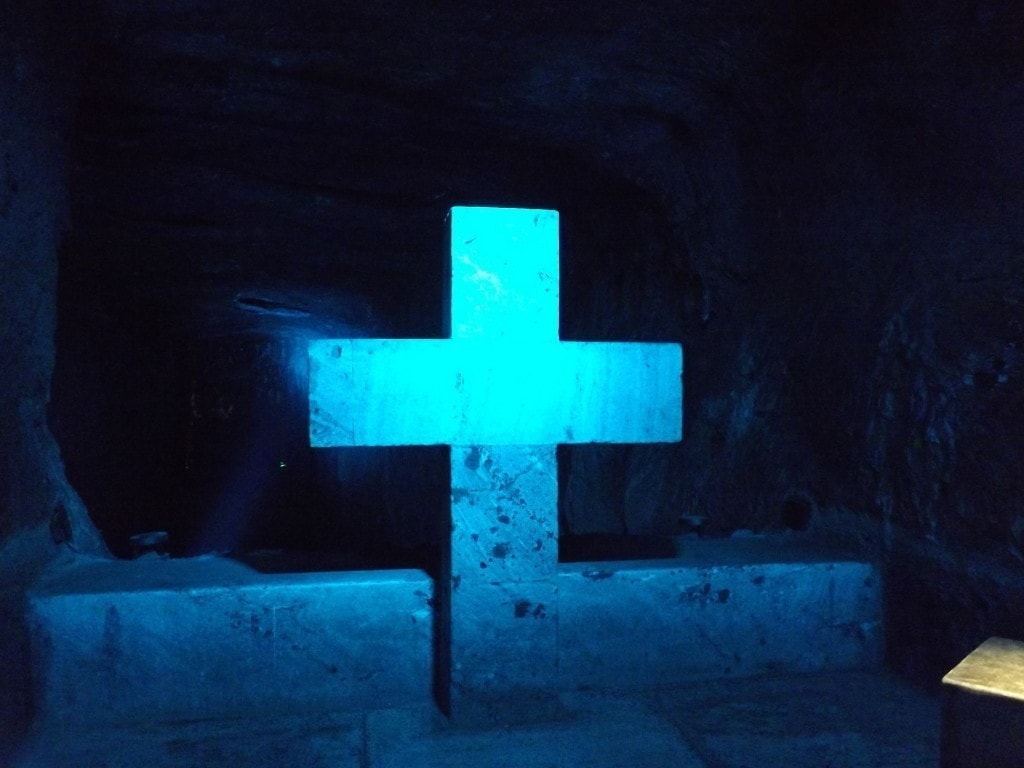
Entrance to the salt mine and cathedral – without any extras – was 23,000 per person To get back, just walk back to where the bus dropped you off and flag down the next bus you see headed to Bogotá – make sure it’s headed to the main terminal though and not the Punto del Norte which is right up in the North of the city and still about an hour away from the centre.
Paragliding in Bucaramanga
First Published: 25/02/2014
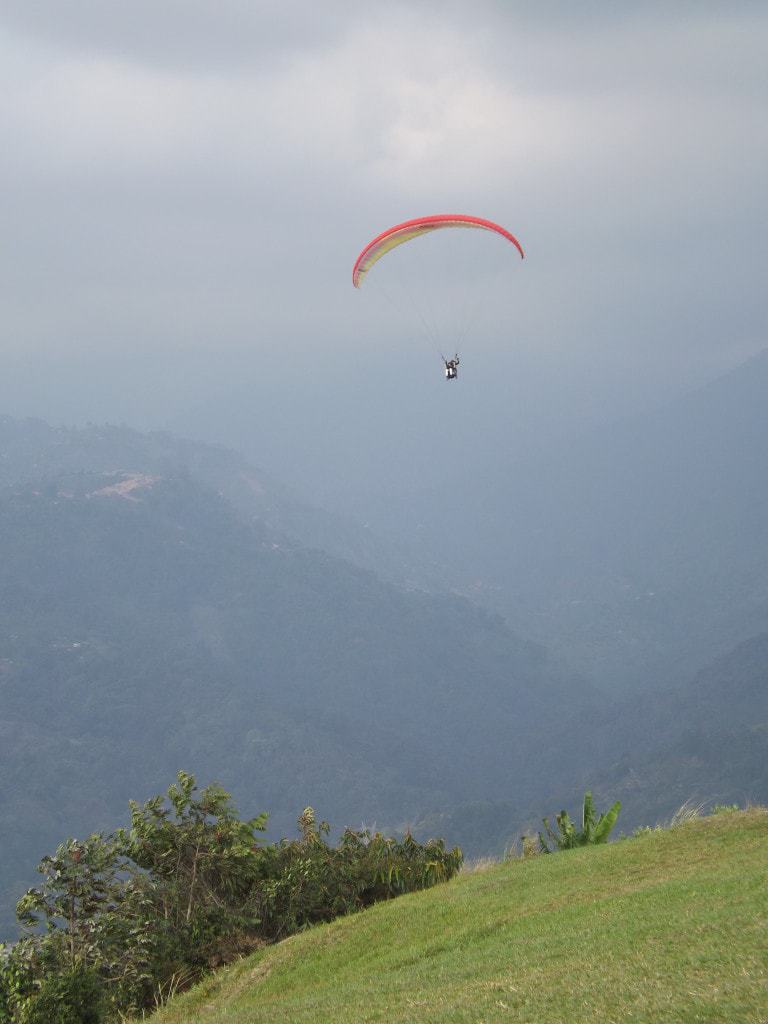
On Tuesday last week, Sam and I woke up in Bucaramanga – having randomly decided to stop there on the way to Santa Marta purely to break the journey up. We had no idea what Bucaramanga was or what it had to offer us, but after looking around our hostel – the lovely Kasa Guane – we soon found that the city was a bit of a haven for adventure sports lovers, with loads of great hikes, rock climbing and abseiling in the area. The thing that caught our eye straight away, though, was the advert for paragliding, and when we found out we could go that same day we decided we couldn’t miss it.
That afternoon, we took a cab to the edge of town where we were picked up by the bus for the paragliding school which is at the top of a hill overlooking Bucaramanga.
The cost of a tandem flight was 90,000 each (less than £30) for twenty minutes, although we each paid an extra 25,000 for photos. The school itself was great, fairly laid back with some really nice staff; one of whom told me that some of the pilots were among the best in the world. The guy who took me up had recently come third in a competition of one hundred entrants, he was really nice (although my broken Spanish meant we couldn’t talk much) and made me feel pretty safe.
Once we’d paid, things moved pretty quickly and soon I found myself, helmet on, being strapped in to the seat in front of my pilot. The instructor told me to get ready to sit, we took a few steps forward, there was a huge roar of wind and billowing fabric, someone shouted “sit” and suddenly the ground was gone beneath me. Within seconds we were twenty or more feet above the paragliding school, and the edge of the hill was falling away below us, with the trees and valleys looking like a little Hornby model village. Bucaramanga spread out in front of us, tiny buildings glowing in the weak sunlight that was filtering through the overcast sky.
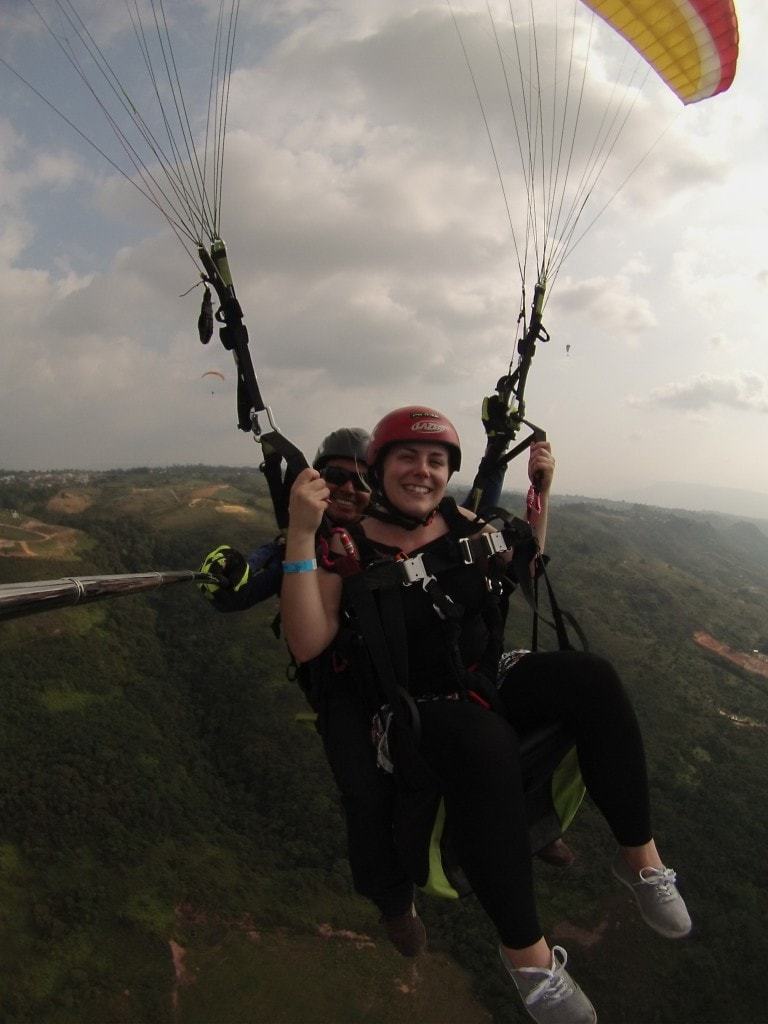
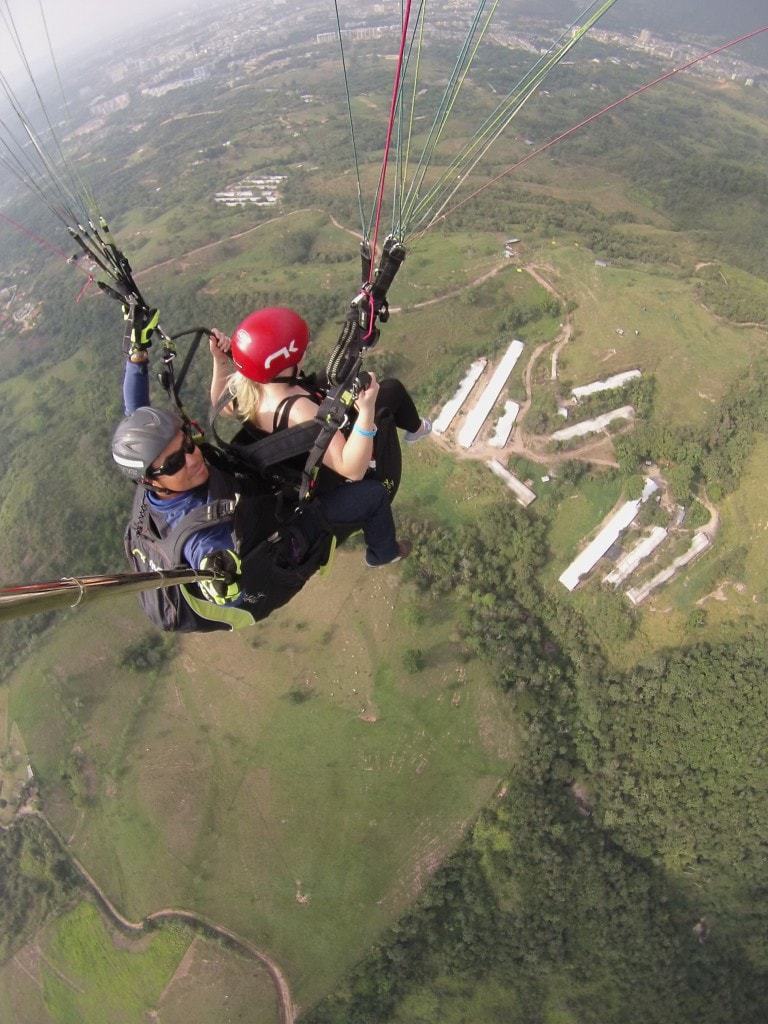
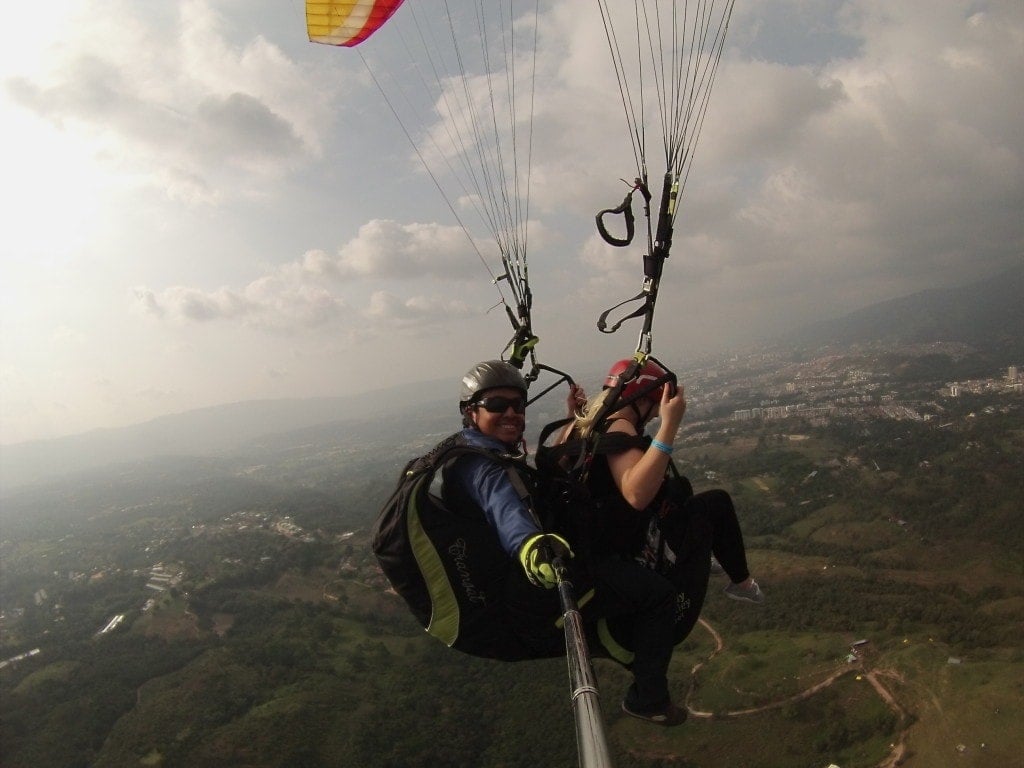
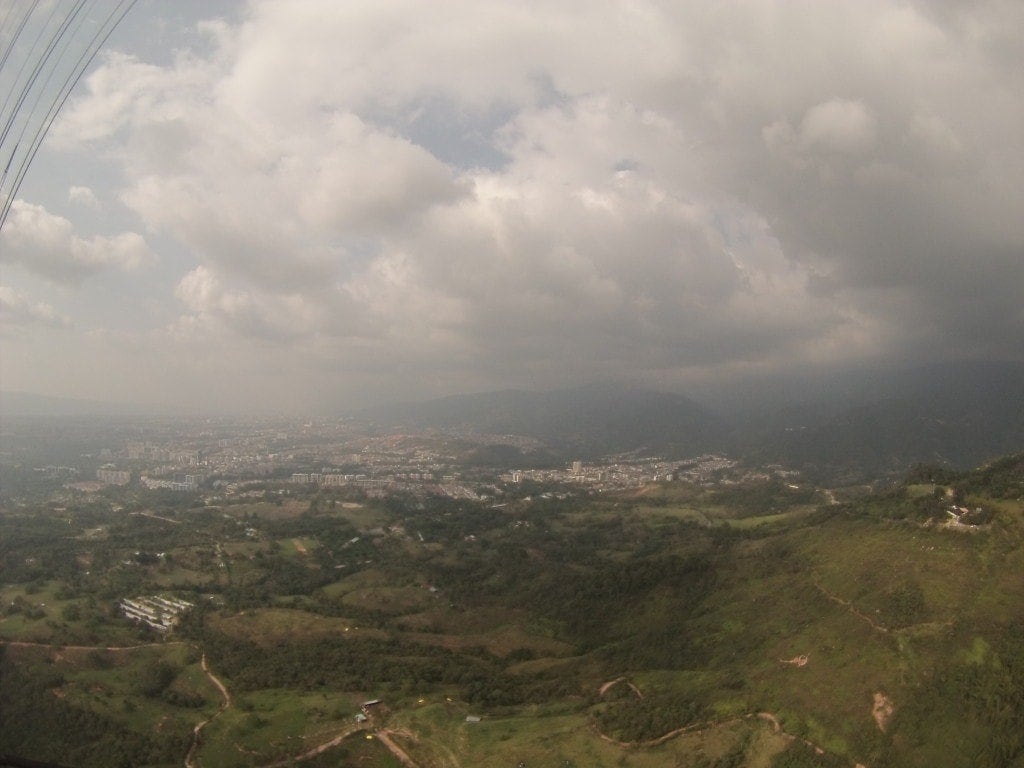
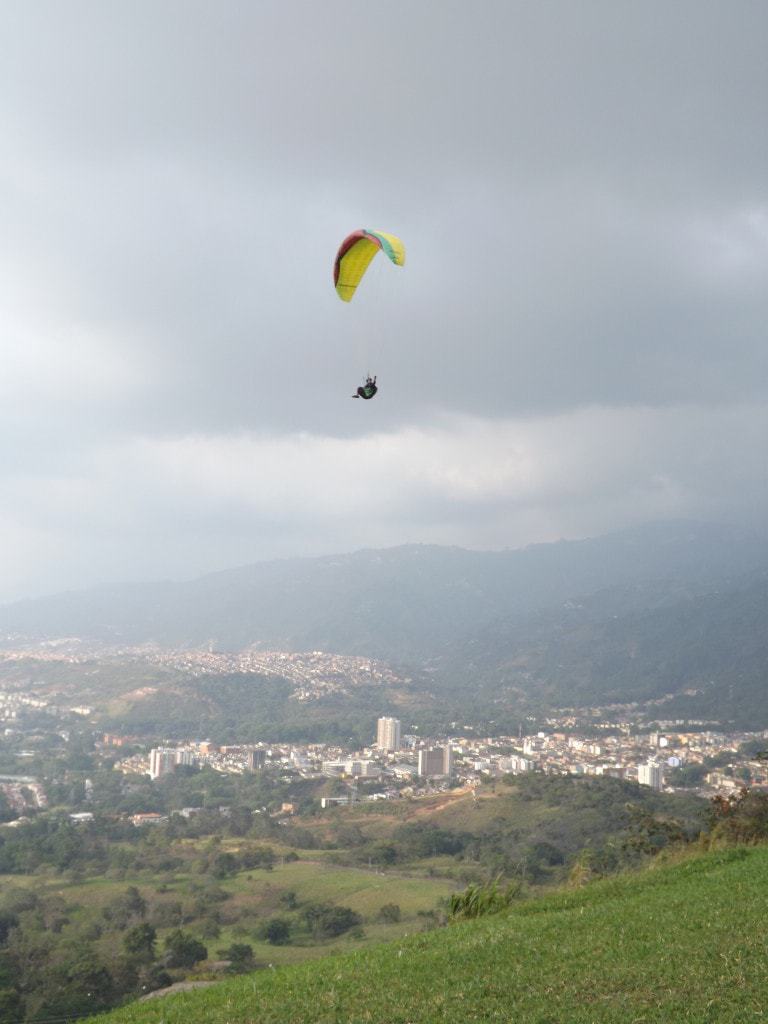
My heart was pounding in my throat, my knuckles were white from gripping the straps so tightly, but there was a huge, unshakable grin on my face. My pilot took hundreds of photos and a video using a small camera on a long stick which he held out in front of me, and in every single one I’m grinning like a maniac. The feeling is similar to those rare but beautiful flying dreams – in fact the feeling is exactly how you might imagine flying would be; no fear or butterflies or lurching stomach, just pure delight. I was so high on the elation and so completely, utterly happy at doing something I’ve always wanted to do, that I was genuinely moved to tears at one point.
Sam had a bit of a chat and a joke with his pilot, but other than “es muy bonito” I couldn’t really get much out. The feeling I had of pure happiness and genuine, unhampered joy was so private that I didn’t want to share it, and instead I was able to forget about the pilot and just enjoy the moment.
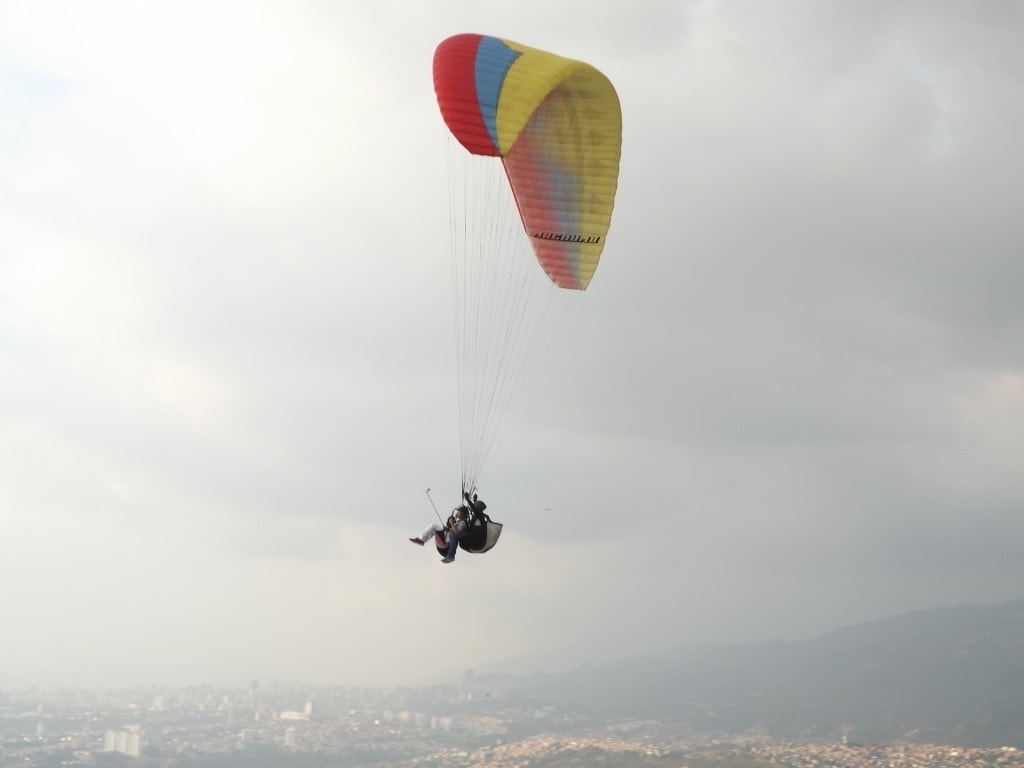
Landing was a bit more frightening. It was a very windy day, which made landing difficult; we looped around and around skimming nearer to the ground each time, but kept getting pulled back up by huge gusts of wind. My pilot showed off, skimming the tops of trees and whacking them with his hand, proving just how in control of the flight he was, and I was whooping out loud and giggling with the thrill of it, but eventually we had to land. My adrenalin rush lasted long after I had my feet back on solid ground, leaving me giggly and generally just ecstatic!
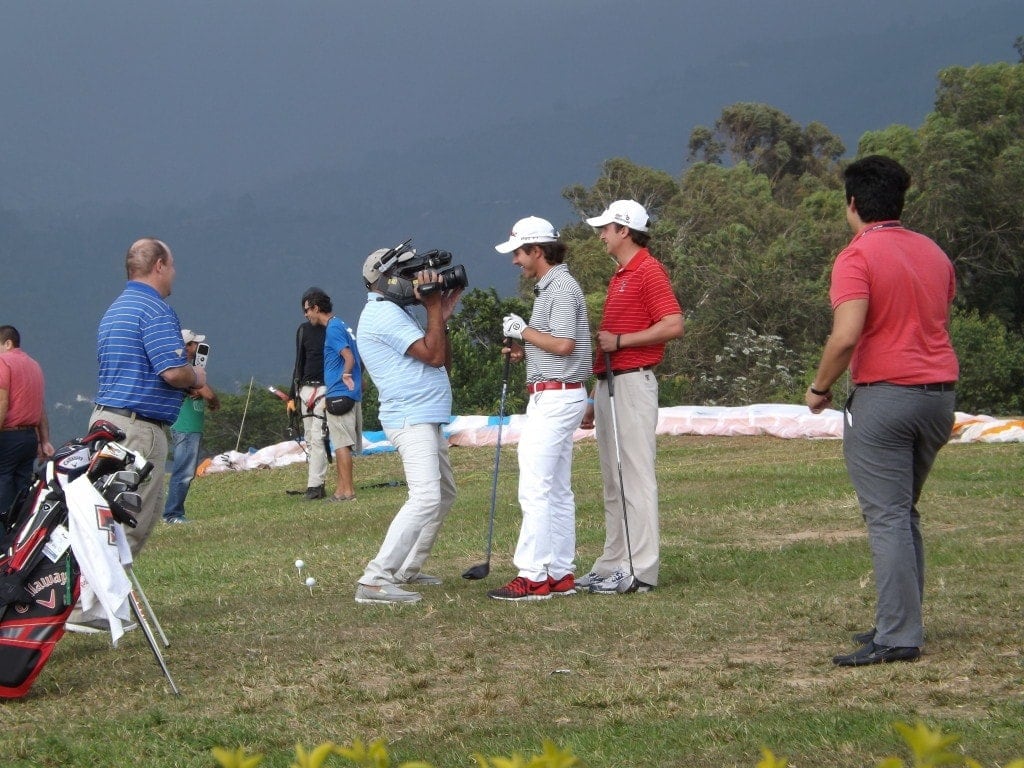
On the ground, while we waited for our videos and photos, we chatted to some guys who were due to fly next. I’d joked to Sam that they were dressed like golfers, but once we’d spoken to them we found out that they actually were professional golfers, playing in the PGA nearby – Finley Ewing IV and Santiago Rivas – and they were being filmed and photographed by ESPN. If you watched any of that tournament you might see a clip of us joking with two of the golfers, although I somehow suspect that they’ll edit that particular highlight out! They were both really nice and very nervous about the flight, but we watched them go up (after a very long photo shoot hitting golf balls of the hillside into the valley) and they clearly loved it as much as we did!
Paragliding was well and truly one of the best experiences of my life, and one I hope to be able to repeat (maybe soon if we find anywhere else in South America offering tandem flights). We also met a lovely English couple who run a paragliding course in Sussex, so perhaps once we’re back I’ll be able to learn to do it myself!
If you ever find yourself in Bucaramanga, Colombia, I wholeheartedly recommend taking a tandem paragliding flight. It’s amazing fun and you shouldn’t miss it!
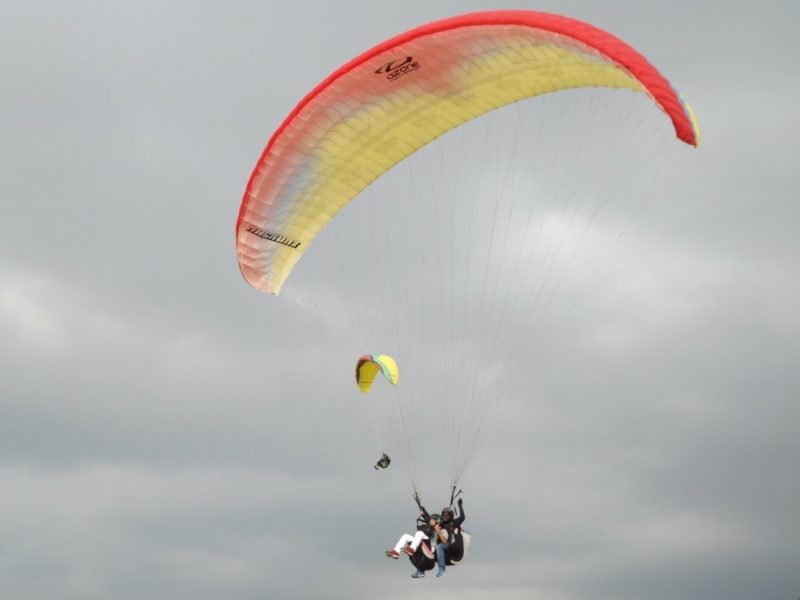
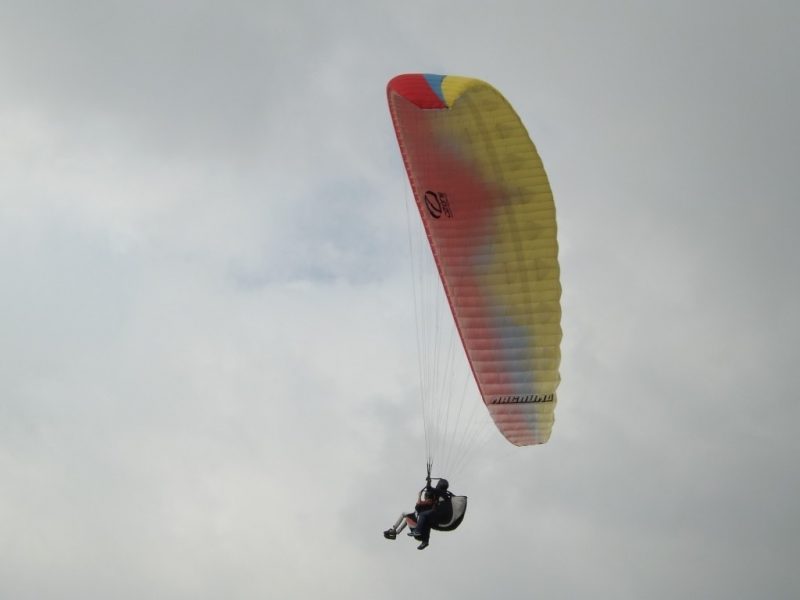
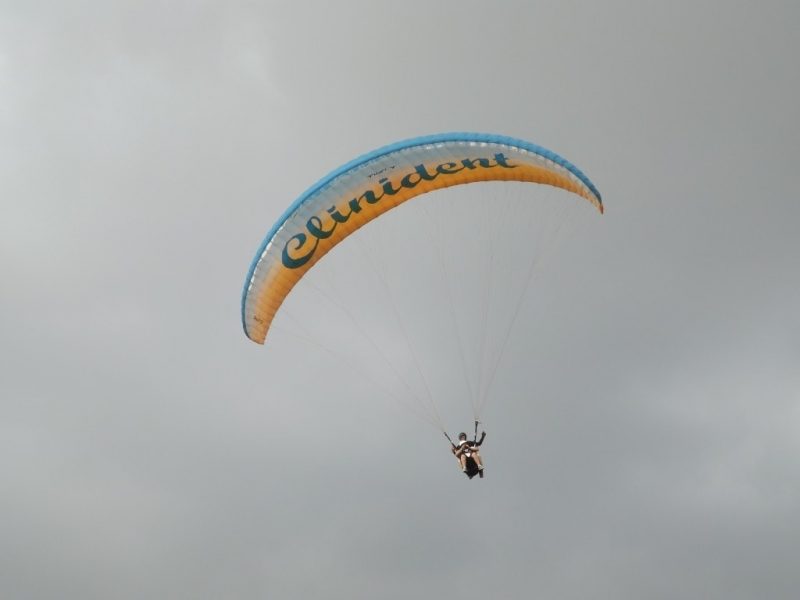
Camping, Hiking and Snorkelling at Tayrona National Park
First Published: 02/03/2014
Following our day trip to Taganga Beach near Santa Marta, last Friday Sam and I continued our search for the perfect beaches along Colombia’s Caribbean coast by heading to Tayrona National Park (lots of info about Tayrona at the end of this section).
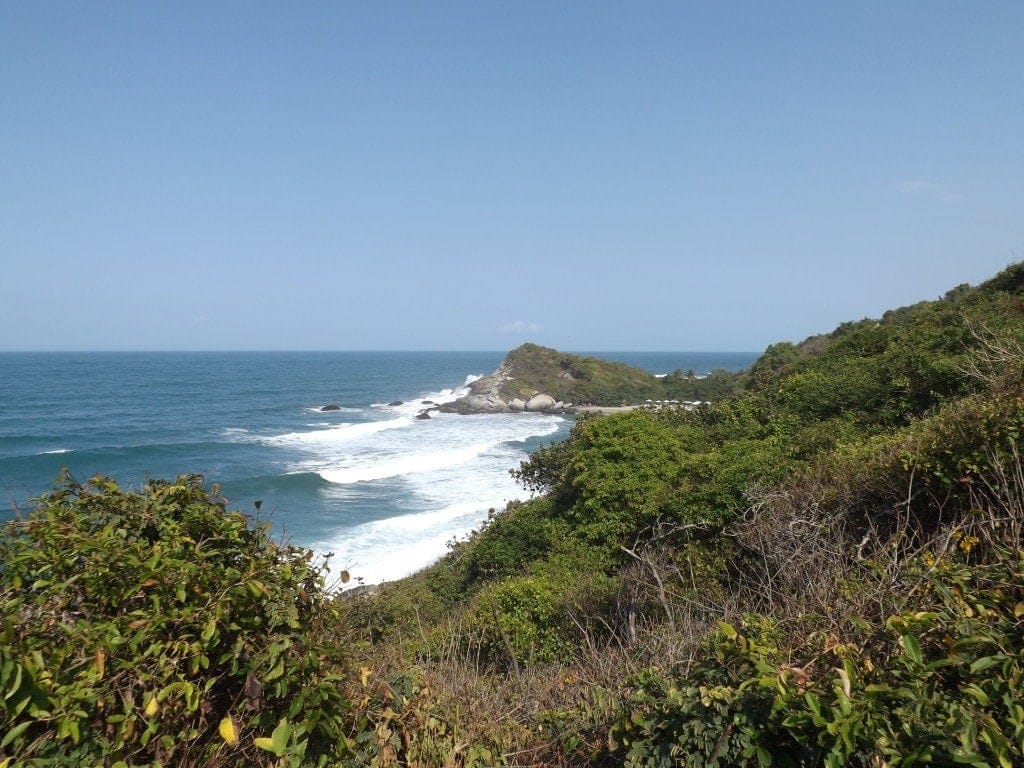
Around midday, we hopped on a bus in Santa Marta’s centre and pretty soon we were rumbling along through countryside that rapidly changed from fairly arid to lush green. In about an hour we arrived at the entrance to Parque Tayrona. A second minibus took us from the entrance to the centre of the park, from where we began our hike to the coast.
The walk was a fairly easy one, but Sam and I are slightly unfit and neither of us do well in the heat, so we did struggle. About half the walk is through thick, jungle-like forest which was as humid as a green house and filled with big, leafy trees. We saw lots of small lizards and several monkeys, although I really struggled to get a good photo of any of them – for wild animals they were surprisingly anti-social!
After a few fairly steep hills, we arrived panting and sweating at the edge of the forest and looked out at the gorgeous blue Carribean sea. There was still quite a way to go, but the wind coming off the ocean took a little of the pain out of the last part of the walk along a sandy path at the very edge of the forest.
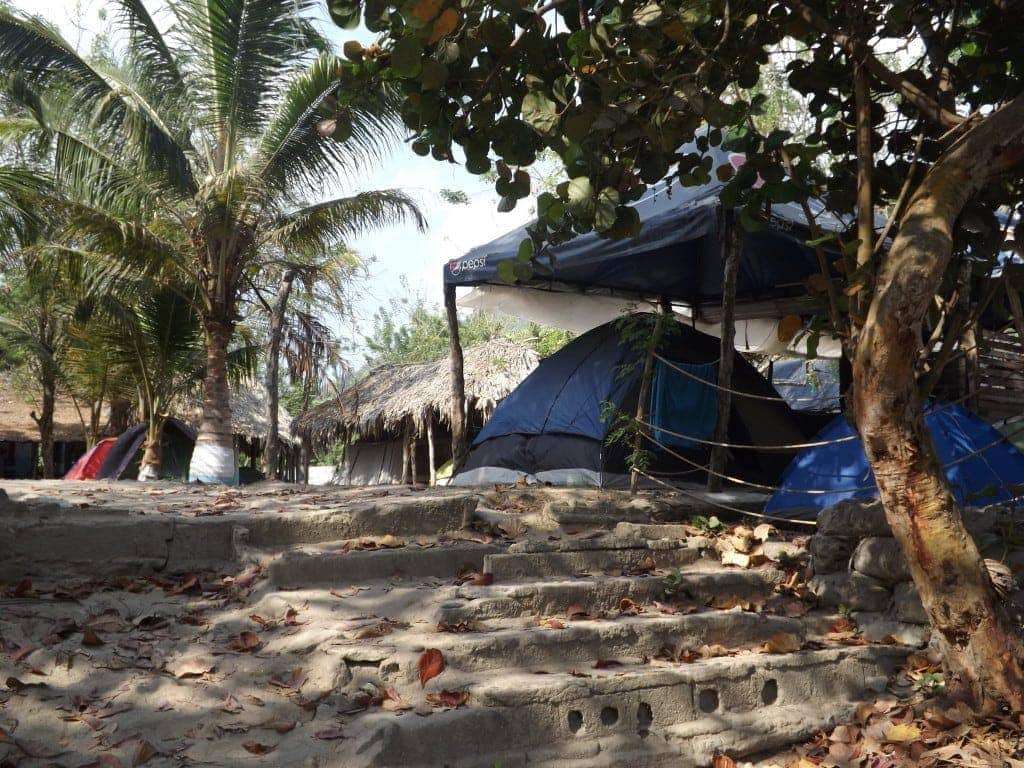
Finally, exhausted and very much overheated, we arrived at Arricifes where the first campsites can be found. Not wanting to walk any further, we settled on a campsite directly on the edge of Arricifes beach – a large stretch of rough, white sand lapped by huge and very strong waves – and rented a tent there for two nights.
As soon as we’d ditched our backpacks and changed our clothes, we headed out to the beach. It’s not safe to swim at Arricifes, so we walked on a little further – about 15 or 20 minutes – to La Piscina, a gorgeous, long bay with a skinny strip of white sand dotted with palm trees, where a natural strip of large rocks at the entrance to the bay act as breakers, keeping the water relatively calm.
It was nearly 5pm when we finally reached the beach, so there wasn’t much time left for a swim – the water was pretty cold – but we enjoyed lingering in the water until the sun was almost down, before heading back to a restaurant at El Paraiso near our campsite for dinner.
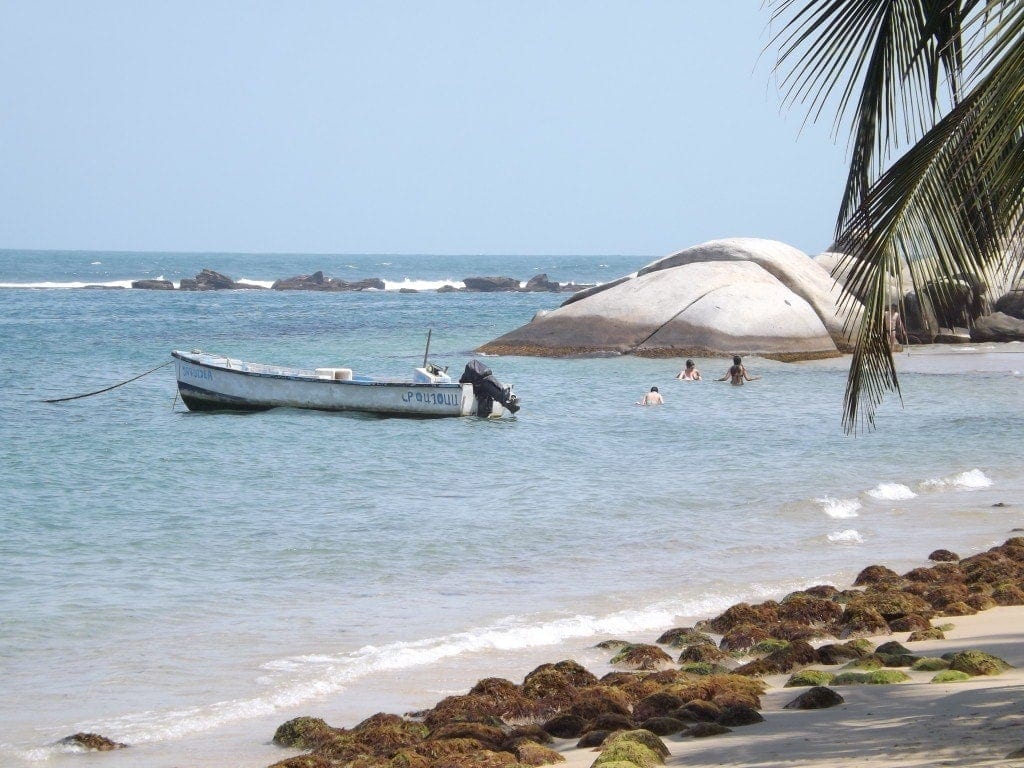
The next day we both woke up pretty early after a very bad night’s sleep. It’s been a while since I camped, and the many noises – wind and waves, cockerels, a very angry stray cat, other campers – along with a few nerves, kept us both awake.
Not wanting to tax ourselves with too much walking or exploration, we headed straight back to La Piscina beach (after a filling breakfast with freshly blended juices) to spend the day there. The beach is so picturesque – exactly the kind of white sand, clear seas, tropical forested, postcard-perfect stretch of coast we’d been hoping for – so we were really happy to spend the day lazing there with our books.
The day before, someone on the beach had told us that the bay was perfect for snorkelling, so we rented a snorkel for 5,000 COP an hour and had a look. Within ten minutes, I’d stumbled upon a sea turtle! The sight was so completely unexpected that I jumped, and had a quick struggle with the snorkel which filled with water when I gasped.
The turtle was huge, dappled green and brown, and was lazily gliding along the bottom of the bay taking very little notice of me. I followed him for a while, but eventually lost him: turtles are surprisingly quick, even when they’re making very lazy movements and barely seem to be swimming at all. Elated, I raced back to the beach to tell Sam, and he took a turn with the snorkel himself – managing to spot two more turtles (or possibly the same one twice!).
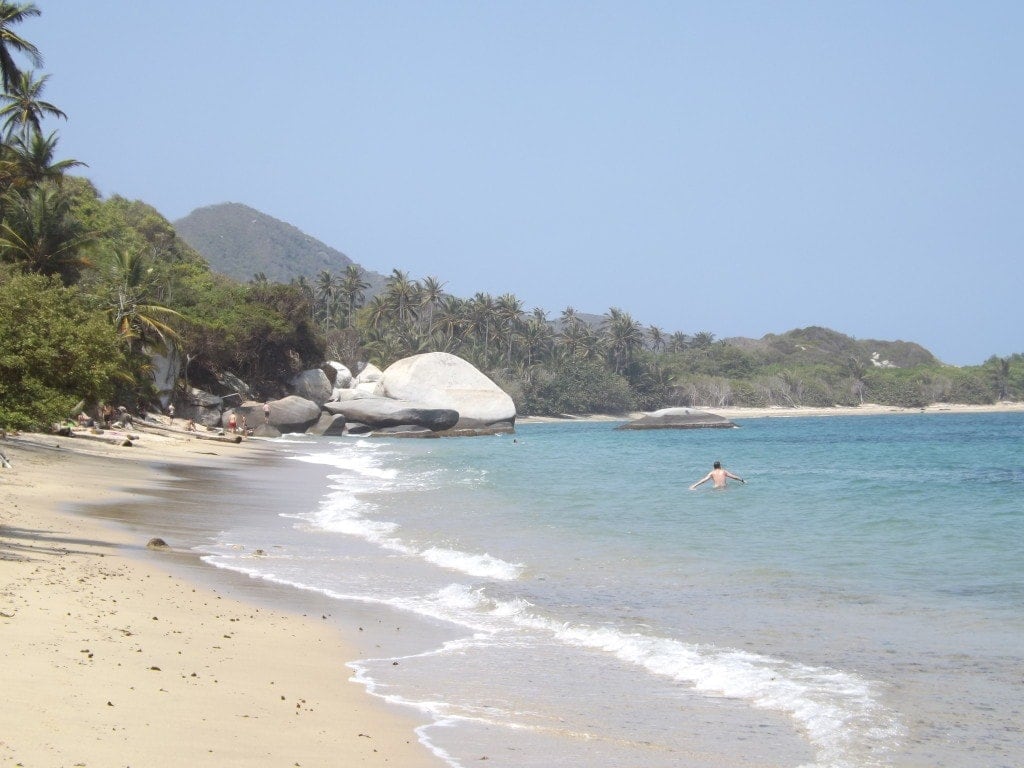
As well as the sea turtles, there was loads of life in the bay at La Piscina which made snorkelling there a fantastic experience. Colourful parrot fish, huge long grey fish which I first mistook for barracuda, angel fish, and dozens of species I didn’t recognise, all swimming amongst gently floating, pinkish sea weed which looked like flowers.
Close to our campsite was another, pricier camping location, Aviatur, which had a gorgeous looking restaurant – wooden decking with a palm frond roof and no walls. Wanting something a bit tastier than pasta or chips, we headed there for a slightly more expensive meal as a bit of a treat. The food was gorgeous – especially Sam’s: white fish wrapped in banana leaf with coconut rice – and after a long day with lots of swimming, we both ate with gusto and couldn’t resist dessert, too. The caramel flan was delicious!
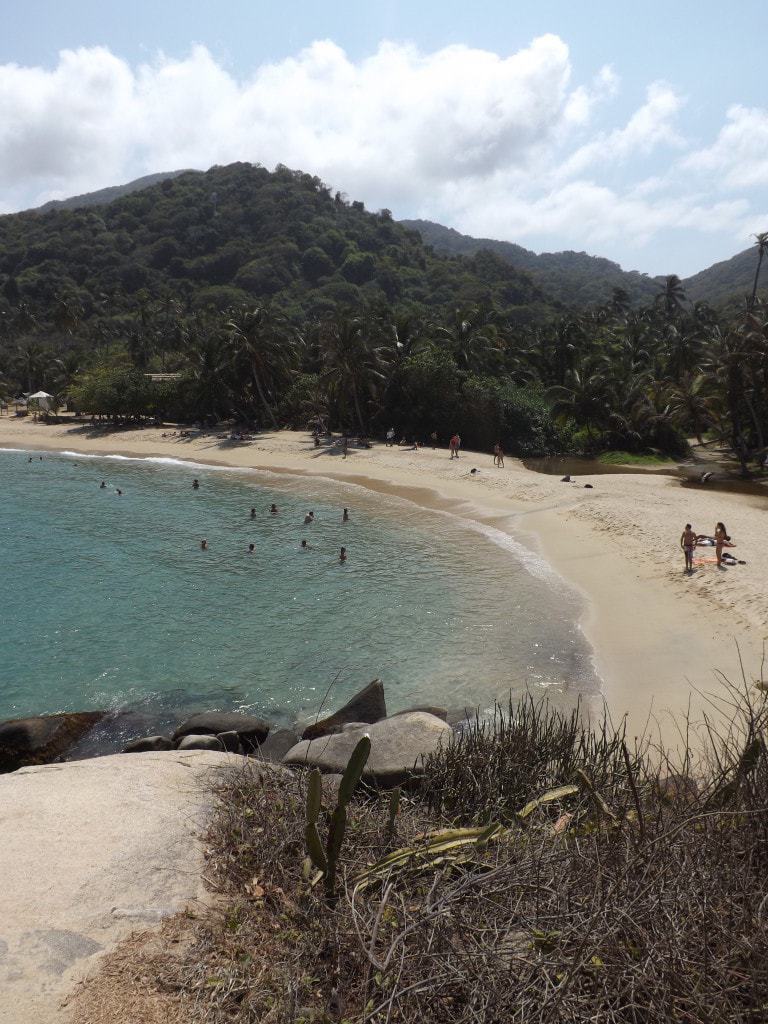
On our last morning in Tayrona, we bumped into two German girls we’d met in Bucaramanga (where we tried paragliding) and walked to El Cabo beach with them. El Cabo is about a 40 minute walk from Arricifes, and is probably the more popular beach in the park.
The campsite there was very crowded – and a huge queue at reception showed it was about to get even more so – and the beach was much busier than La Piscina, which had been lovely and quiet. However, the beach at Cabo was even more picturesque than La Piscina; two small bays divided by a little, grassy hill topped with a palm frond hut.
The water was vivid blue, the sand was white, and a small, warm stream filled with tiny brown fish cut in from the jungle. It’s the classic postcard image that you’ll see whenever you search Tayrona, and it really was a stunning beach – although for me the highlight was La Piscina, where the snorkelling was far better.
After spending a morning on the beach enjoying the deliciously cool waters, we had to head back to the real world, so we collected our things from the campsite and took on the almost two hour walk back through the forest in horrendous heat.
Confess time, I was a bit of a baby on the walk back; the hills nearly killed me and my head caught a bit too much sun, so I had a slight strop – thank goodness Sam was there to look after me and keep me going! Times like this are when I know I couldn’t travel alone; when I get scared or stressed or overtired, I need Sam there to encourage me and tell me it’ll all be ok.
We rode back to Santa Marta on a bumpy, overcrowded bus and headed straight to the Drop Bear hostel – an ex-cartel house in the beautiful El Jardin district (more to come on that, hopefully) – having had an amazing few days camping in Parque Tayrona, surrounded by jungle and lazing on pristine white beaches. The park, although a little pricey to a backpacker’s budget, is a must-visit for anyone headed to Colombia!
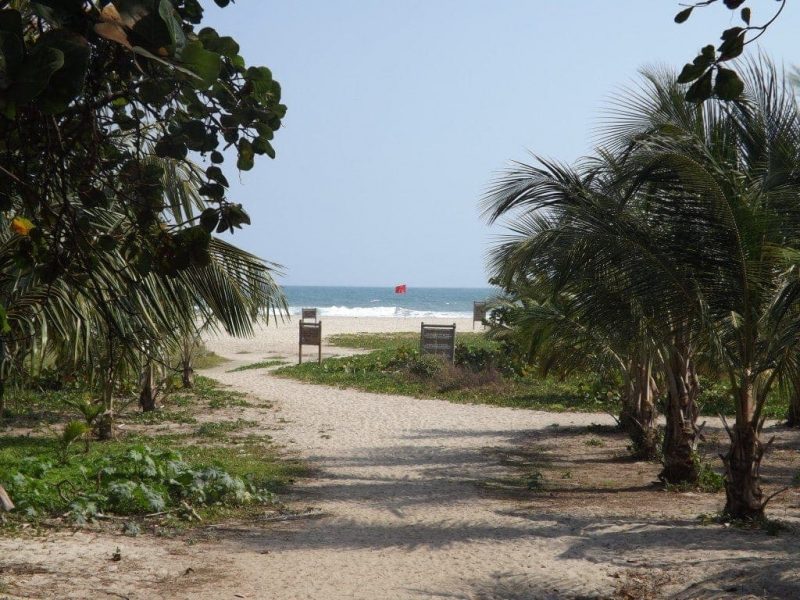
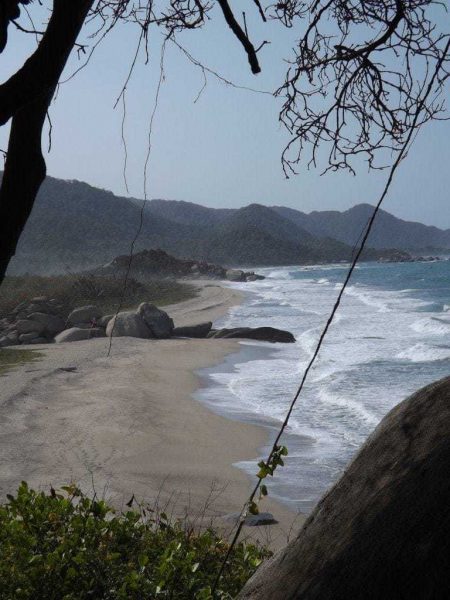
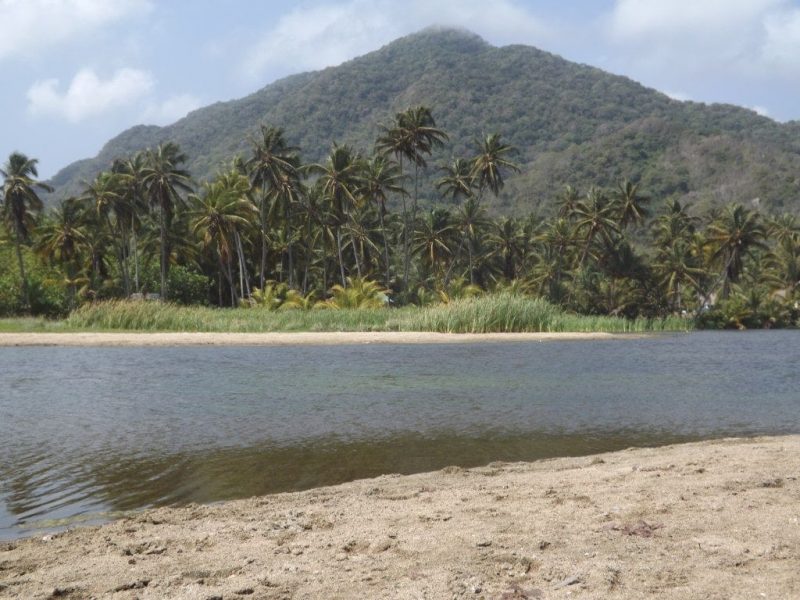
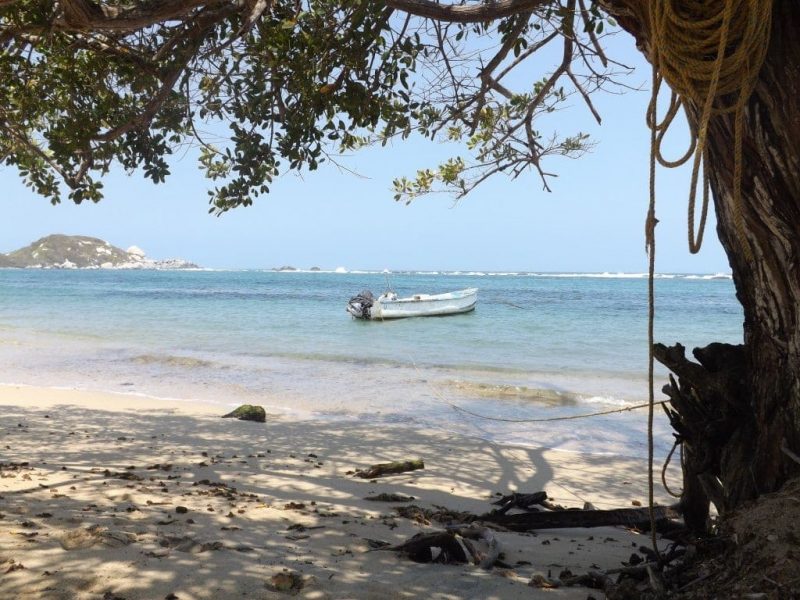
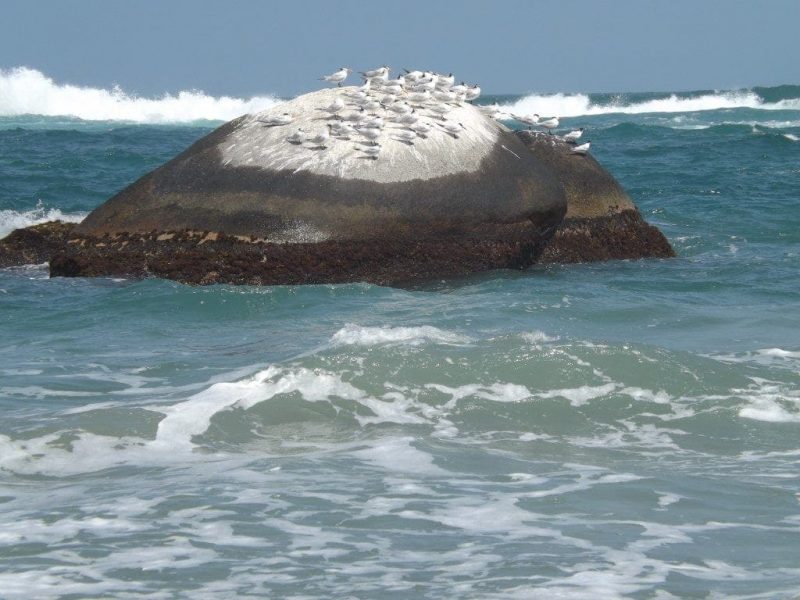
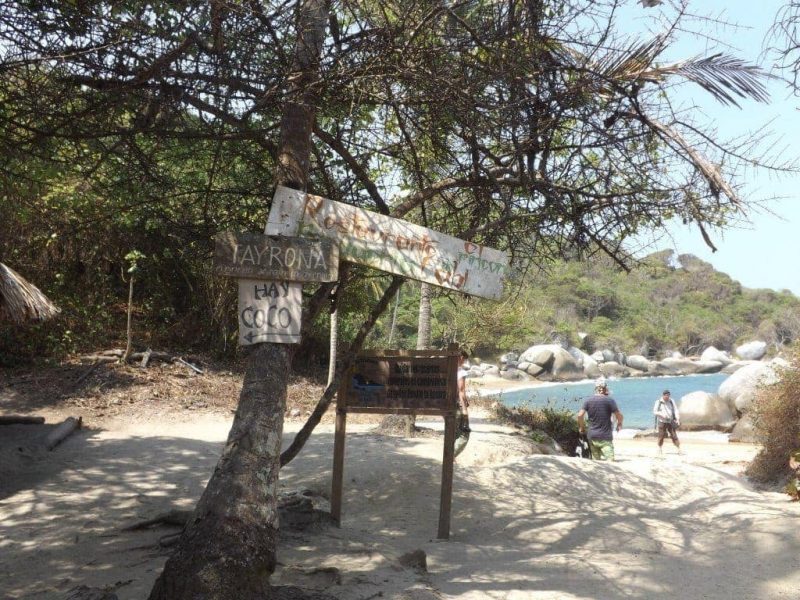
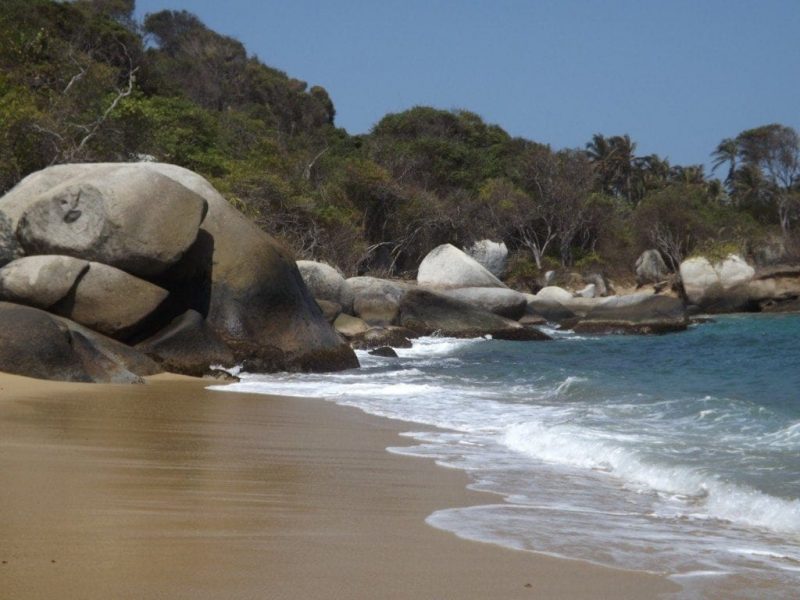
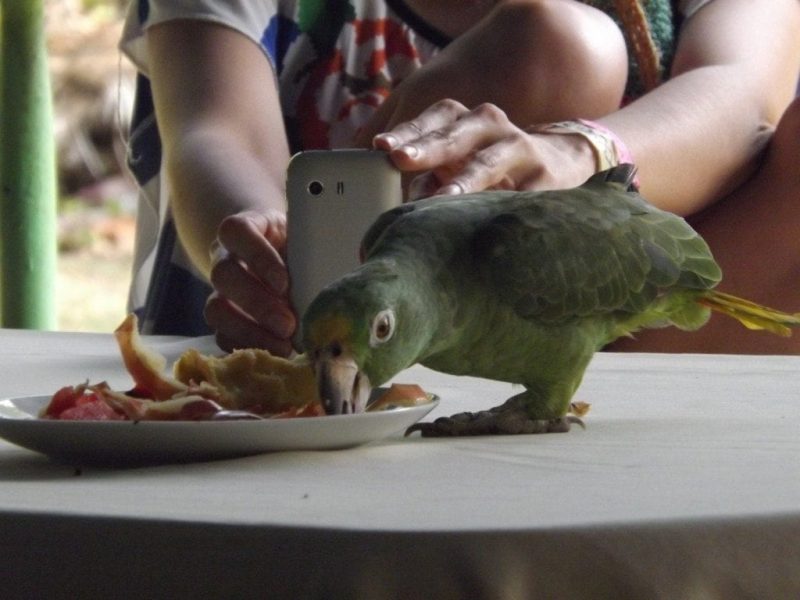
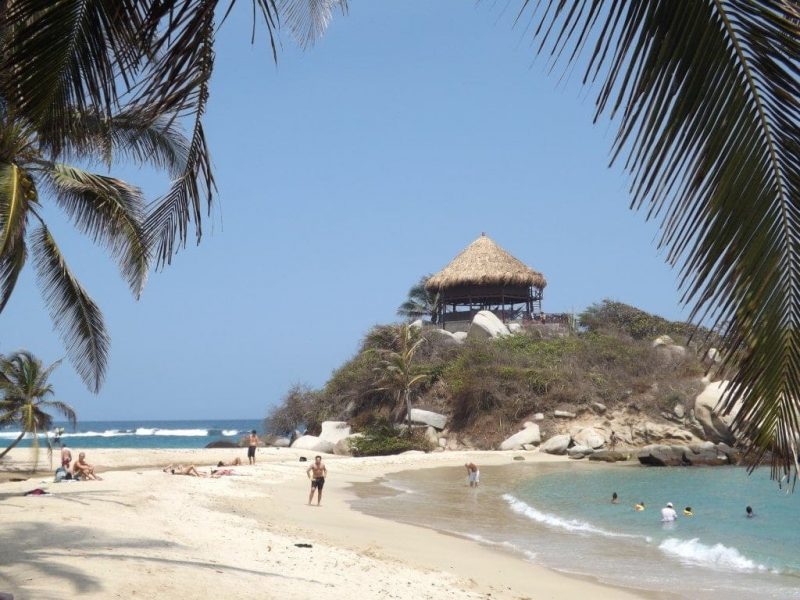
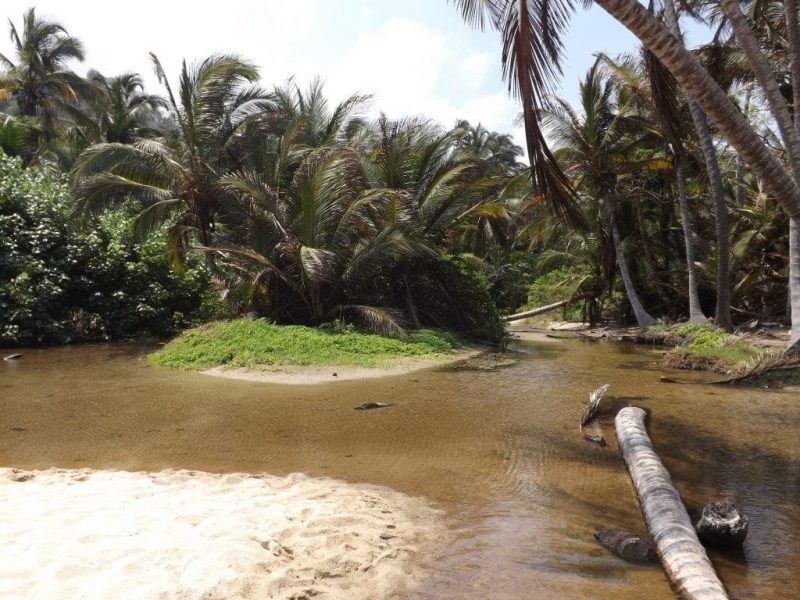

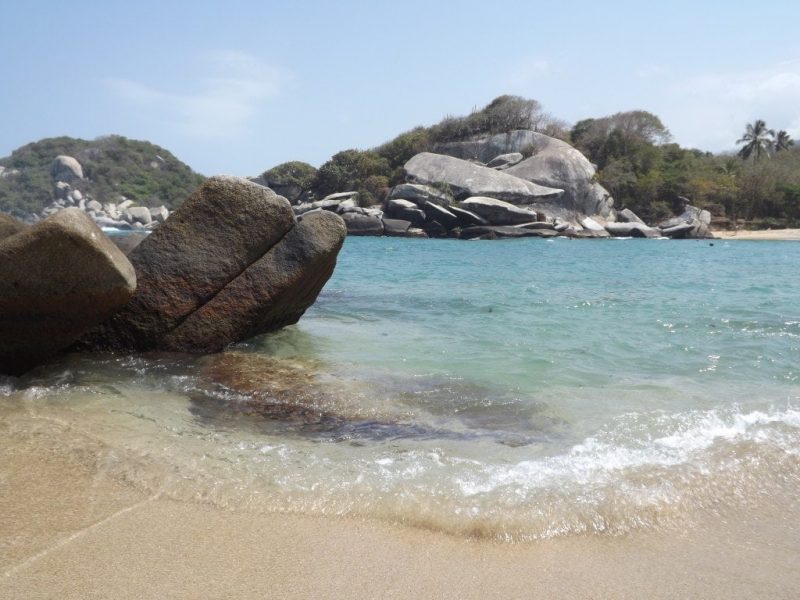
Information about Visiting Tayrona
Update: My info is a couple of years out of date, so you can also check out this awesome Guide to Tayrona National Park from the lovely Two Scots Abroad for more. Don’t miss it!
Get the bus to Tayrona from Santa Marta on the corner of Calle 11 and Carrera 11. The journey takes about an hour and costs 6,000 COP.
Entry to the park is 37,500 COP and you need to have ID with you – according to some girls we met they are happy to accept a copy of your passport, but we had originals. Inside the park is another bus costing 2,000 COP which will drive you into the middle of the park, knocking at least half an hour off the walk time. The walk from where the bus drops you is about one hour to an hour and a half, in strong heat with a couple of steep hills, so I recommend taking the bus for the first part. The walk is tough if you’re unfit, like we are, but not too challenging – there are steps and wooden walkways and the hills, though steep, are not particularly high.
Take plenty of suncream and insect repellent, and have a lot of water with you for the initial walk – you can buy more inside the park.
Food and drinks are generally priced a little more than they are outside Tayrona, so prepare to spend a little extra – or take your own food in.
The campsite at Arricifes charged 50,000 COP per night (not per person) for a tent which included mattresses. Alternatively, you can rent a hammock inside a mosquito net for much less – or there are cabins which charge about 200,000 COP per night. The campsite at Cabo is much more popular and as a result is very overcrowded – get there early or stick at Arricifes which is far quieter.
Many of the beaches are unsafe for swimming due to strong rip tides – wherever you see a red ‘no swimming’ flag avoid the water (you can generally tell by the extremely rough waves, anyway). The best beaches are La Piscina and the two smaller bays before it, and El Cabo.
Magic in Minca – Cascadas Marinkas
First Published: 08/03/2014
Since getting to Colombia, we had received numerous recommendations to get ourselves to Minca in the Sierra Nevada mountains, just 45 minutes outside of Santa Marta.
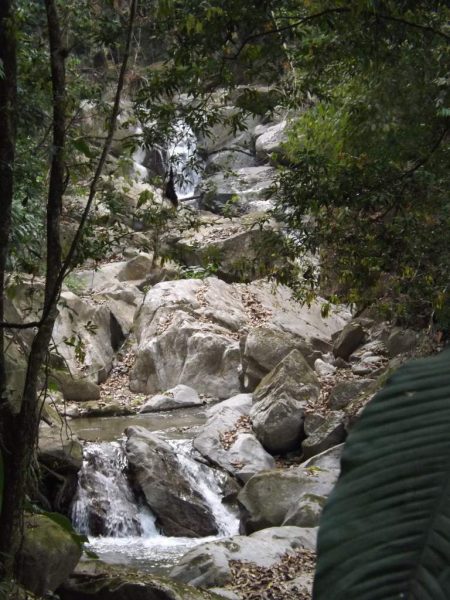
The most memorable came from Sarah, who valued Minca for its eco-friendly tourism, beautiful countryside, and most of all, its mystical qualities. The rocks up there are full of quartz which, she said, shamans in the indigenous tribes once used for rituals and healing.
As a result, the whole area is just so… magical. In spite of the numerous sceptical looks Sam and I exchanged, Sarah repeatedly assured us that Minca is simply filled with magic. The experience, the walks, the rivers, the woods… everything. So, in search of a profound experience – and hopefully a little magic – we hopped into a colectivo and headed for the hills.
Casa Loma Minca Colombia
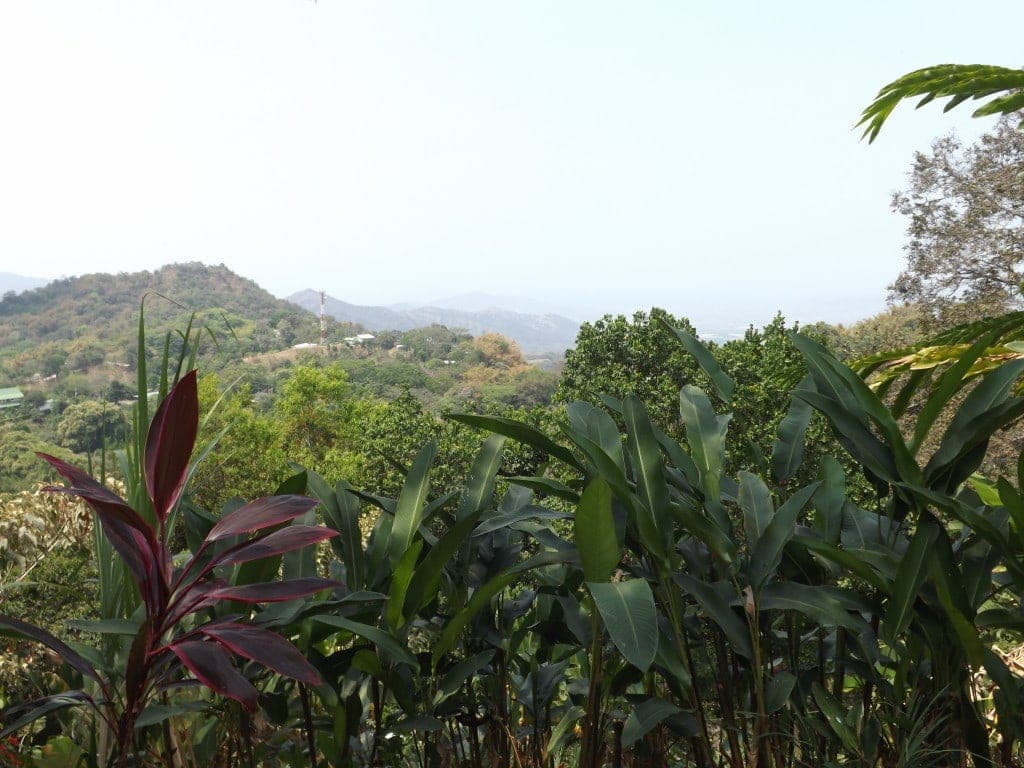
The colectivo – an ancient and rickety old green car impersonating a shared taxi – carried us past the dusty outskirts of Santa Marta and up winding mountain roads surrounded by lush greenery, alternatively bouncing over and swerving around the many potholes. Within thirty minutes we were in another world – and in another fifteen we had reached Minca, a tiny village perched on the edge of a valley and surrounded by towering, dark green mountains. We had recommendations from a fellow traveller we’d met in Bogota – “you have to stay at Casa Loma” – so ignoring the flock of teenage motorbike drivers offering their services as ‘taxis’ (no roads go up to the hostel on the hill, anyway) we shouldered our backpacks and followed the signs for Case Loma hostel. This is at the top of a hill behind the church; a gorgeous wooden treehouse facing one of the most stunning views I have ever seen. A foreground of vivid green jungle leaves and brightly coloured flowers speckled with floating butterflies, a background of deep emerald mountains studded with forest. And poking out of the haze in the distance, the city of Santa Marta and a glimpse of blue sea.
The hill up to Casa Loma is steep and deceivingly long, with so many curves you can’t tell how close to the top you are. Eventually, panting and drenched in sweat, we staggered up the last few steps and onto the front porch of Casa Loma, where the staff immediately produced glasses of cold water for us and let us sit for a few minutes to recover before checking us in. The hostel is beautiful, with a downstairs lounge open to the elements and dotted with hammocks, and has some of the friendliest staff I’ve ever met. We checked in, dumped our bags and rested from the uphill climb, and read the hostel’s guidebook for suggestions on what to do with our afternoon.
Las Cascades Marinkas
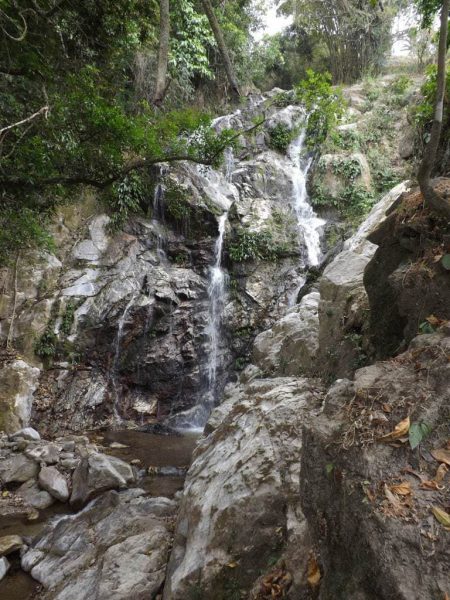
It wasn’t hard to decide. Las Cascades Marinkas – a set of waterfalls where you can swim in the water – sounded like the perfect afternoon trip. We stocked up on water and bread for lunch at a shop in the village, and set out on a pretty easy – though uphill – hike.
The walk was about an hour, all uphill, along a dirt road with occasional shallow river crossings. The road was lined by thick forest, a shallow, rushing river, and huge thickets of towering bamboo, and we were grateful for the shade and cool mountain breeze as we hiked our way to the waterfalls.
Once there, we paid 3,000 COP (about £1) each to enter – there’s a small wooden observation deck with a sign claiming that it serves as a restaurant – and clambered over the rocks to the higher of the two waterfalls.
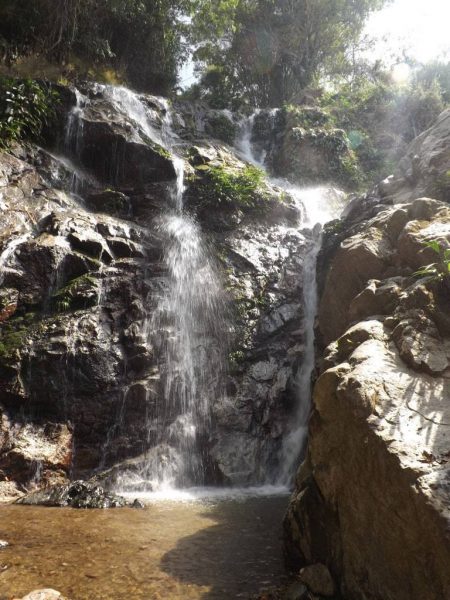
It was completely secluded in a small rocky enclave, and we were the only ones there, so after a quick change into our swimming stuff we were in the falls, splashing in the icy water. The upper waterfall is the much more beautiful, but has only a shallow pool beneath it where you can paddle; the lower pool is for swimming.
From the upper waterfall, the view across the forested valley of rolling mountains and spiralling black eagles is stunning, backed by the sheer rocky cliffs over which white sprays of water come tumbling erratically, glistening in the sunlight. Besides the sounds of rushing water and calling birds, there was total silence – no cars or motorbikes or other people – and although I couldn’t really sense any magic, there was a profound feeling of total peace hanging over the place, which sunk into both of us totally.
Magical Minca
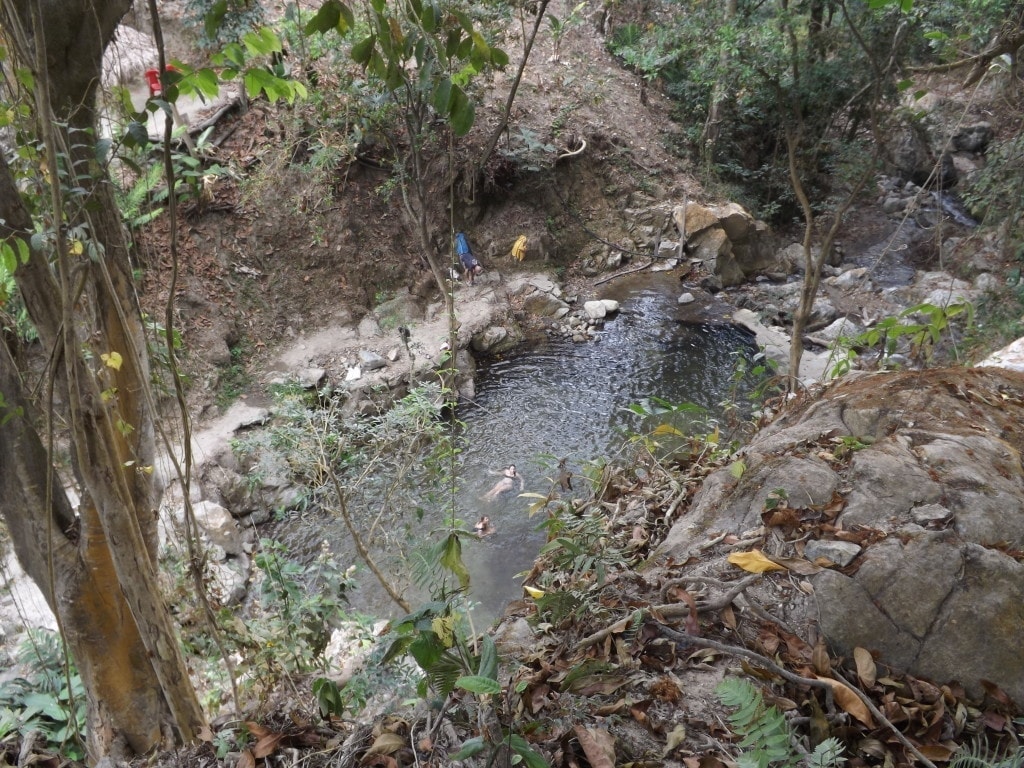
We climbed down to the second waterfall, where a wide, deep pool sat invitingly amongst the rocks, and slipped in. The water was overwhelmingly cold, but once we were in it was gorgeous; crystal clear and so clean. The rocks really are full of quartz around here, which makes the water sparkle with a glittery appearance; maybe not magical but certainly very beautiful. Again, the only ones there, we swam for ages enjoying the cool water and the tranquillity. The afternoon sun was beginning to slip down in the sky, catching the white spray of the waterfalls with a golden light and filling the valley below us with warmth, when we finally decided it was time to head back to Casa Loma.
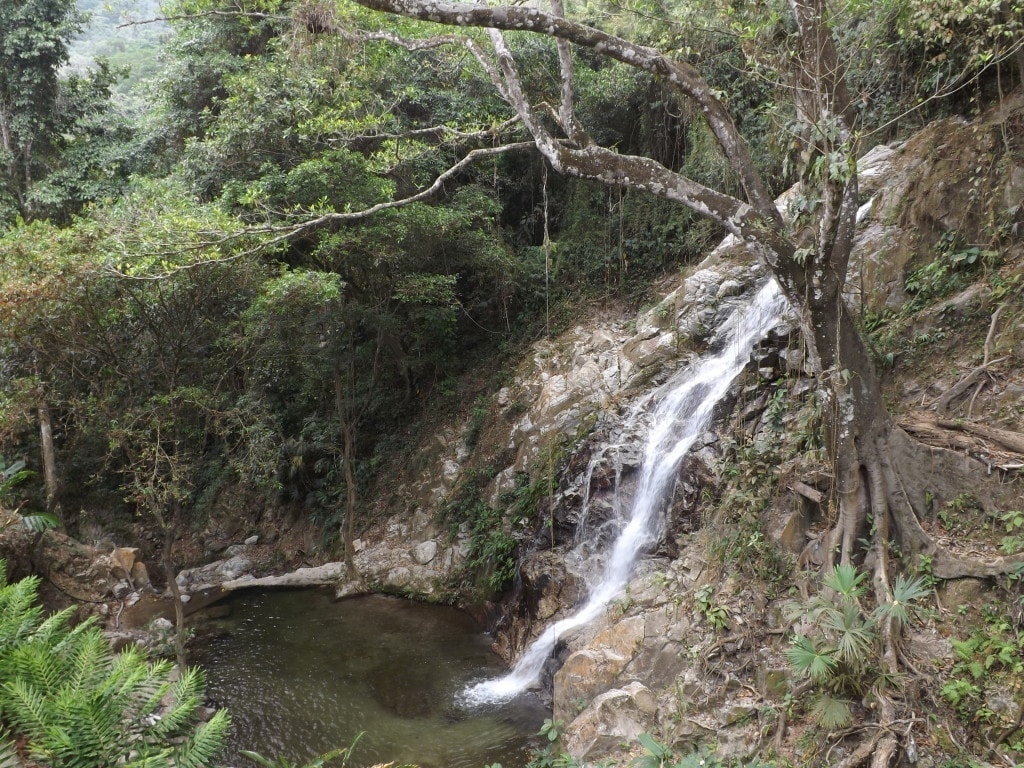
Without our bags, and reinvigorated by the falls, the climb up the hill to the hostel wasn’t as bad – but it was still pretty painful (it never got any easier); and we arrived just in time to watch the sun set over the valley, a glowing red ball in a peach sky. Every night, Casa Loma serves dinner – everyone eats the same thing and at the same time, giving the place a lovely family atmosphere – and by the end of our day of walking and swimming, Sam and I were ready to eat our own hands; so we were both a little disappointed to hear that dinner that night was vegetarian. But, the meal of rice with sauce, potato and pumpkin in a spicy vegetable sauce, and spicy beetroot salad, was one of the best I’ve had in Colombia; we both cleared our plates like starving animals and shared a fat, moist slice of chocolate banana cake for desert, which we ate on the porch looking out at the glittering lights of Santa Marta swimming in the heat haze like jewels in the inky night sky. Not quite magic, but almost.
Information
The cheapest way to get to Minca is by Colectivo (shared taxi) which costs around 7,000 COP per person.
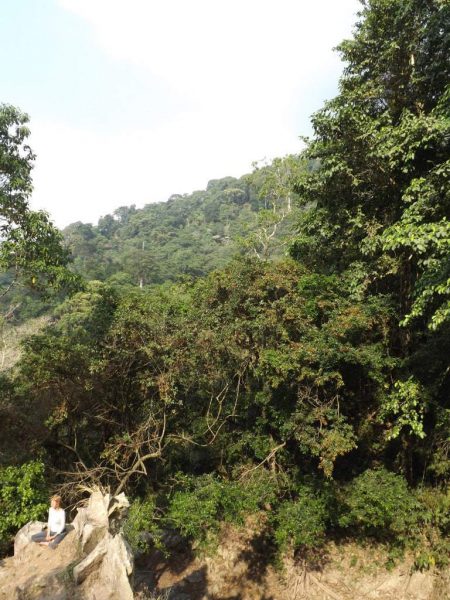
There are a number of hostel options but I highly recommend either Casa Loma (review to come) or Casa Elemento as these have the best views. We didn’t stay at the latter but we met the owner a few times, and stopped by there on route to Los Pinos. The staff were all amazing, the hostel is way out in the middle of nowhere halfway up a mountain, and the evenings seem on the whole more lively (aka drunken) than at sleepy Casa Loma. But it’s all about preference. Book Casa Elemento in advance and they will arrange to pick you up in their jeep from Minca; otherwise the walk is around two hours up a pretty steep mountain path.
A dorm bed in Casa Loma costs 22,000 a night, or there are private rooms, hammocks or tents – plus a campsite if you’re bringing your own tent with you.
If you’re heading to Las Cascades Marinkas, try to go midweek as it will be quieter. Get there early if you can – the pool will be more in sunlight in the morning and early afternoon. In the dry season, it’s possible to do the walk in flip flops, although trainers will be more comfortable. Entrance is 3,000 COP.
Minca, Part Two: The Seven Hour Hike
First Published: 09/03/2014
Our second day in Minca began beautifully, as I imagine almost every day in that quiet town surrounded by lush forests in the Sierra Nevada does.
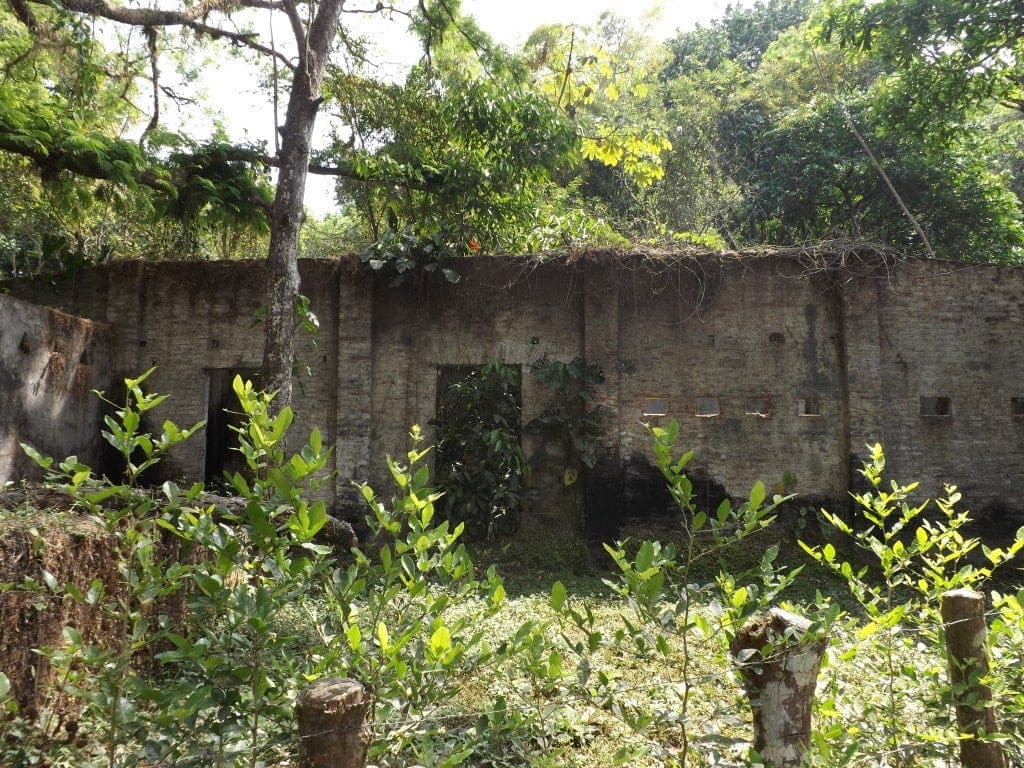
We woke up early but naturally, called out of sleep by the soft dawn light and the long, high-pitched wails of cicadas – which we’d nicknamed “megabugs”. Although not blind, they act it, and fly into everything (me, the waterfalls, the walls, the waiting mouths of the dogs which seemed to find them very tasty) and like moths are irresistibly attracted to lights.
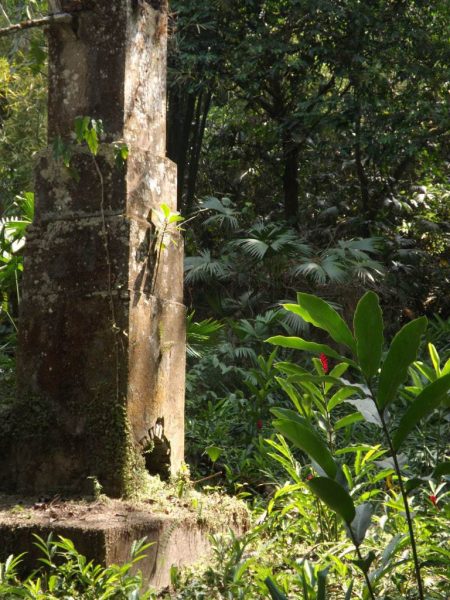
They fly with a crackling sound like rustling dry paper and when stationary, they make a cricket-like noise which is impossibly loud and sounds like a long scream echoing across the valley, and which I at first assumed must be birds until we realised it was the cicadas. While we were in Minca, they were absolutely everywhere, having recently emerged from cocoons about two weeks before our arrival, and they did not shut up once! Anyway, on with day two…
After fuelling up with a hearty breakfast at Casa Loma, our gorgeous hostel in the hills, and buying bread and cake for lunch in the village, we headed out on our second adventure in Minca; a hike around the valley via Los Pinos. Los Pinos is, according to our hippy friend Sarah, the most magical place in Minca – this is apparently something to do with the profound silence she experienced whilst she was up there.
Another side note: Sam and I are not hikers. We’ve never done a hike together, we’re fairly unfit, and we both suffer massively in strong heat. That being said, we were pretty optimistic when we left Casa Loma for a hike which the guidebook quoted as five to seven hours.
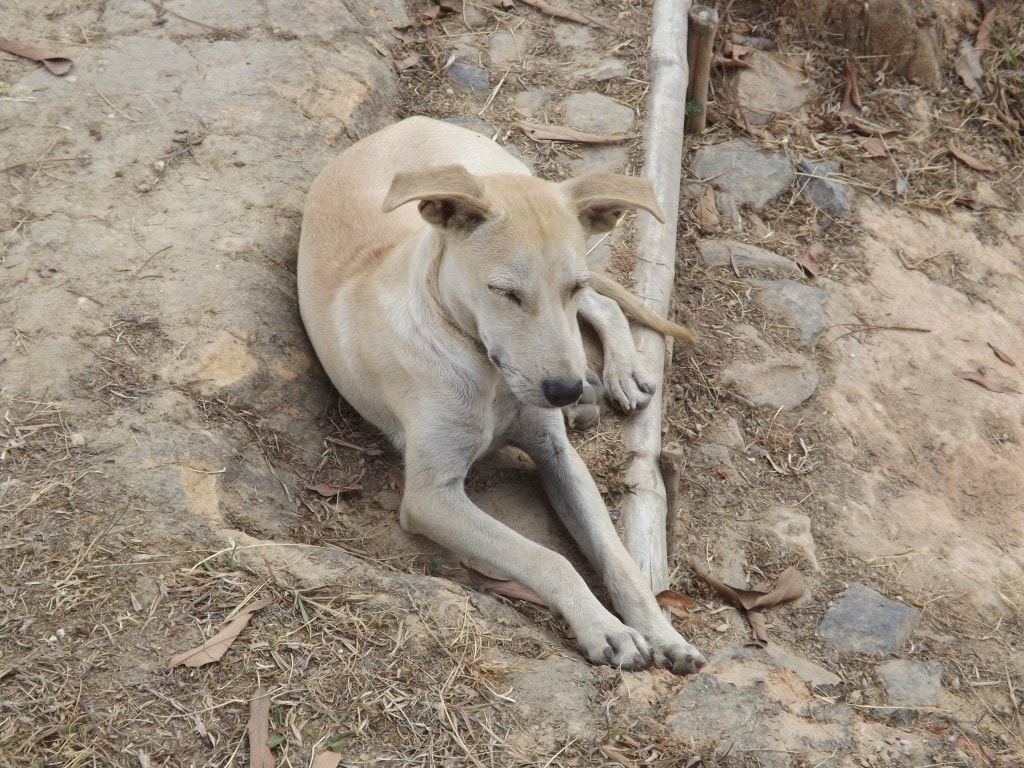
In the village, one of the local stray dogs – a skinny, beige-coloured mutt with big sad eyes and shaky legs – started following us after Sam gave him some much-needed attention. We nicknamed him Philippe, petted him, and fed him a little, and our new pet wound up following us the entire way, possibly motivated by food, although I like to think he was protecting us.
The first mistake we made was not reading the route instructions properly before setting off, and starting the circuit in the direction which our guidebook said was the harder and more adventurous route. This meant that the uphill climb, which took in total nearly four hours – with numerous rest stops as my chest heaved and legs trembled – was much, much steeper than if we had gone round in a clockwise direction. After about an hour of walking, the hill began to curve more steeply beneath our feet, with each bend in the dirt road getting a little worse. The walk took us up through cloud forest, so the air was cooler – every gust of cold mountain breeze was delicious – but also damp and humid, making walking harder. My top was completely soaked through with sweat – as though I’d fallen in a pool of water – and my legs were in agony. We pressed on, and in spite of the difficulties it was a very pretty walk; the road was lined with thick woodland filled with birds, Megabugs, and butterflies – as well as a family of pigs and a small snake that we just about caught a glimpse of.
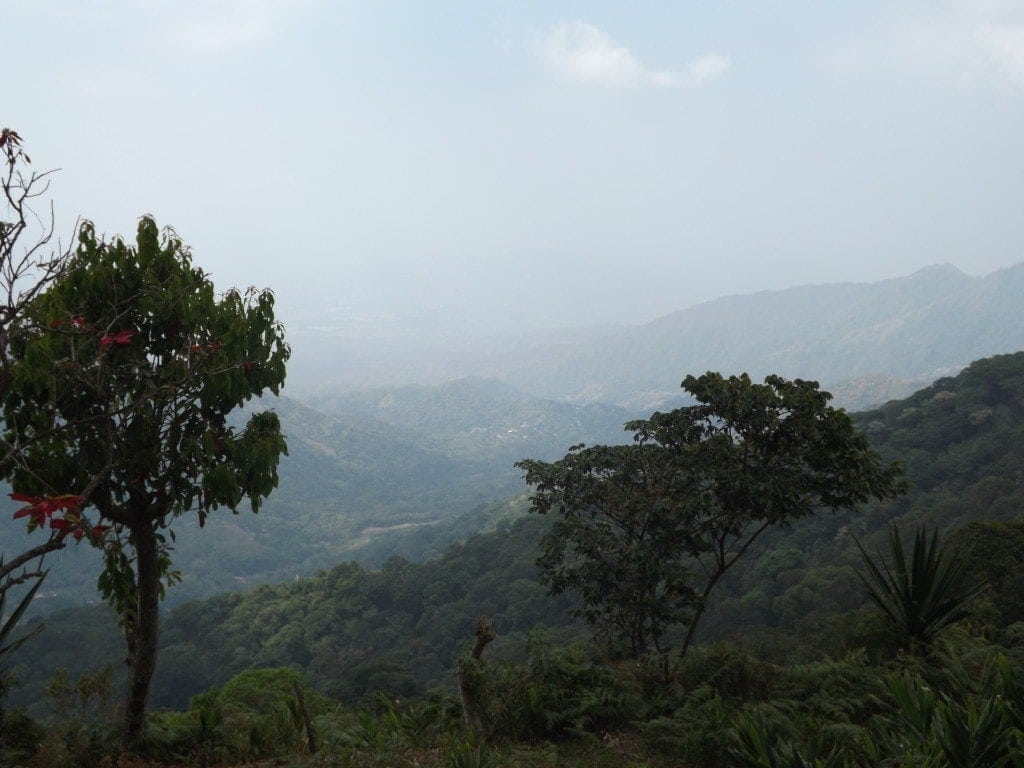
Our second mistake was not bringing a map with us. On the map pinned to the wall in Casa Loma, the circuit was one long, circular road which went up the mountains behind Minca, through Los Pinos, and back down the other side to Minca. In reality, the dirt track curved in a snake-like pattern up the mountain with a number of turnings and side roads. We walked the wrong way down one of these and had to double back on ourselves, with Philippe looking on disapprovingly, until we eventually stumbled upon a turning for Casa Elemento, a hostel whose owner we’d met the day before, where we decided to get some directions. The staff at the hostel, which looked like a really great place to stay way up in the mountains in total seclusion, were really friendly, inviting us to sit down and getting us glasses of water. They gave us some really helpful and thorough directions to Los Pinos, via a shortcut behind the hostel, and let us sit down for a long time to rest and chat before we got back on our way again.
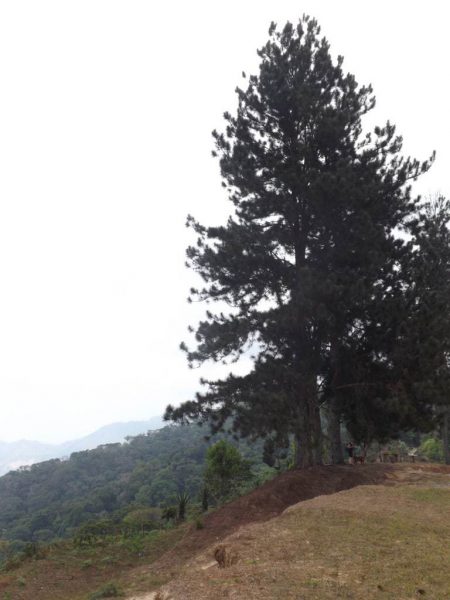
Los Pinos, when we finally made it (after the worst section of the climb which almost reduced me to tears) was not quite the breathtaking viewpoint I had expected. On a clear day, you should be able to view the snow-capped peaks of two mountains behind the valley, as well as all across the valley below as far as the sea by Santa Marta. Unfortunately, the sky was overcast and hazy when we arrived, so all we saw was the deep valley on either side and the line of about six pine trees for which the viewpoint is named. Los Pinos was also lacking the total silence promised us by Sarah; there is a small house there and a nearby village, with children playing and dogs barking, so actually we experienced much less silence there than we had on the long walk to get there.
After splitting lunch with Philippe, we set off on the last stretch of the walk. This, fortunately, was almost all downhill; descending through the valley first past small cliffs of exposed red earth overlooked by looming, forested mountains, and later through a lush green valley of jungle-like forests, banana trees, and colourful birds where we passed a few farms and coffee plantations.
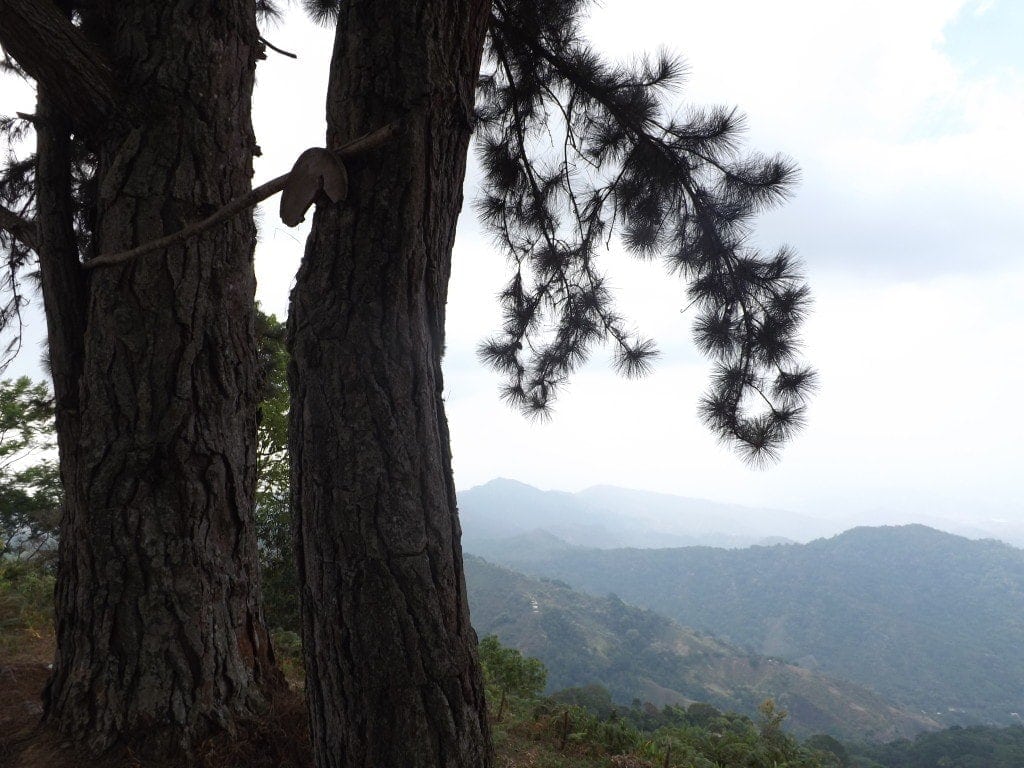
Once we’d finally arrived back in Minca almost exactly seven hours after setting off, Philippe flopped himself down under a slide in the dusty playground, and gave us an exhausted look which clearly said “you two are insane, I am never following you anywhere again”. So, we had to leave our new friend down in the village and face the final challenge – the steep climb back to Casa Loma – alone; where we flopped ourselves down in deckchairs on the porch to watch the sunset and drink copious amounts of Coke to refill our bodies with much needed sugar.
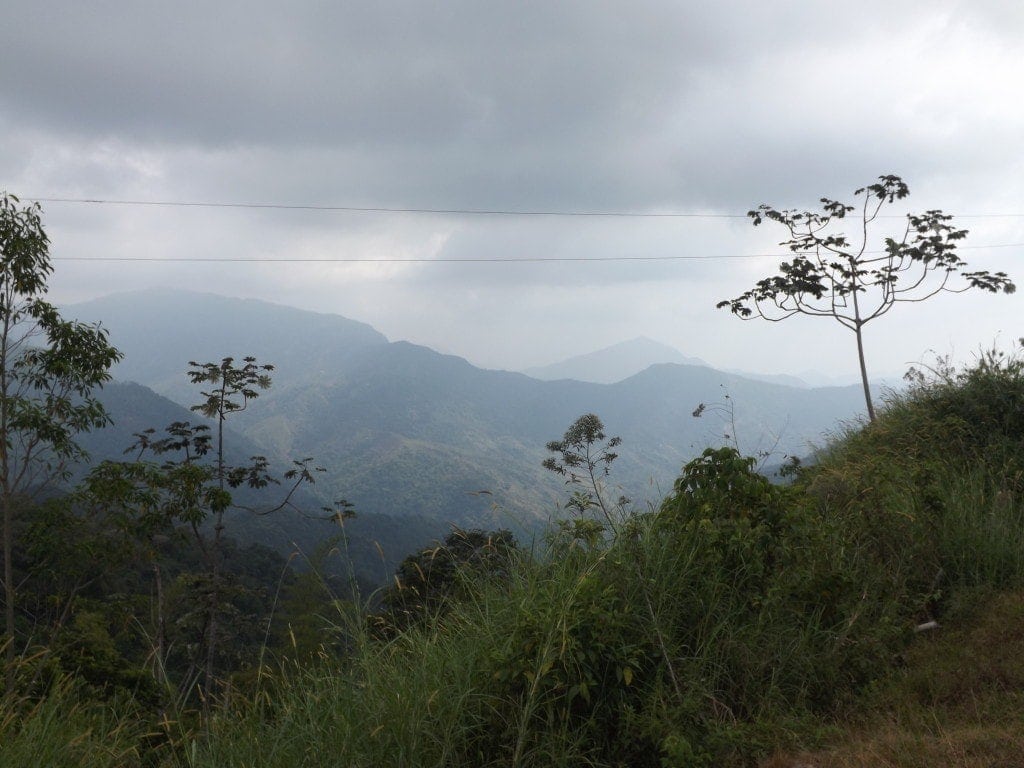
That night, we sat outside Casa Loma nursing our aching feet and chatting with the staff and other guests over dinner; another delicious meal with couscous, chickpea curry, and vegetable salad. Although the day was physically draining and definitely in no way magical – with the main point of the hike, Los Pinos, a slight disappointment – I felt a huge sense of achievement at having completed such a big and difficult walk, and so very proud of myself, that every second of the pain and every drop of sweat seemed completely worth it!
Minca, Part Three – More Waterfalls and Taking the Plunge
First Published: 10/03/2014
Our original plan was to stay in Minca two nights, but after our second night – even after the agony of the seven hour hike the day before – we just couldn’t tear ourselves away, and booked into Casa Loma for a third night. If it hadn’t been for carnival on Saturday that week, we probably would have stayed even longer – in fact I’d happily head back there right now if we didn’t have a whole continent waiting for us.
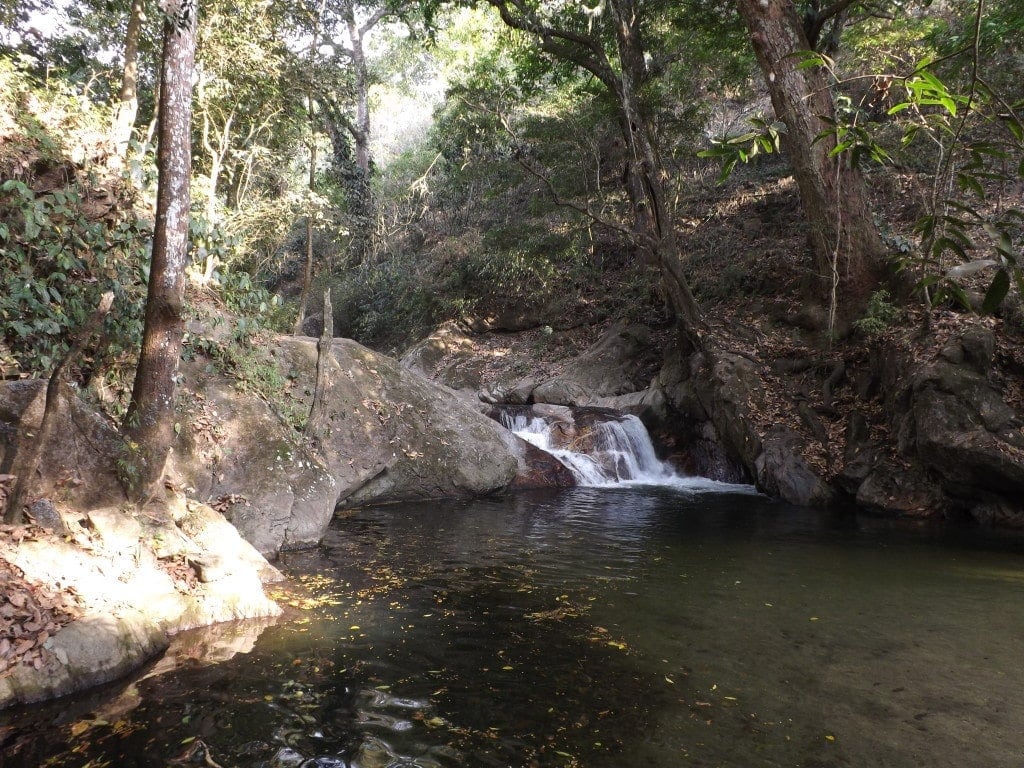
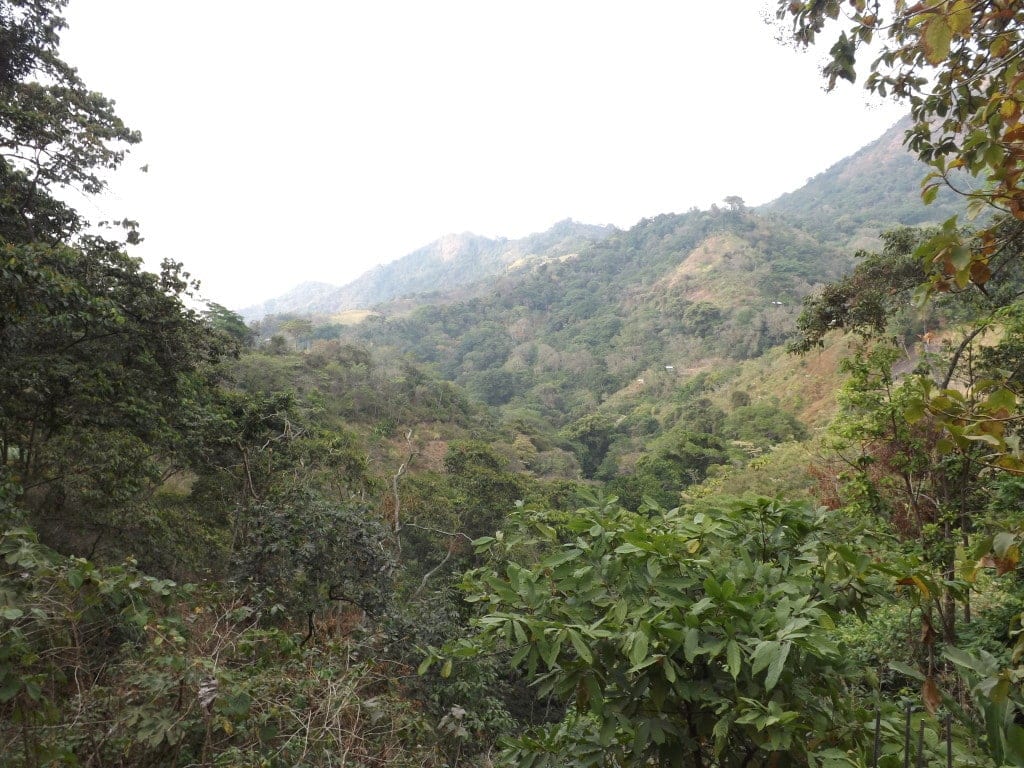
The third day, still aching from our long and mainly uphill hike, we decided to take it easy. That morning, we booked massages with the local yoga teacher and Reiki healer – who visits Casa Loma most mornings to run a yoga class (which we skipped) on decking at the top of the hill, facing the forest and overlooking the valley in what has to be one of the most beautiful places for morning yoga on earth.
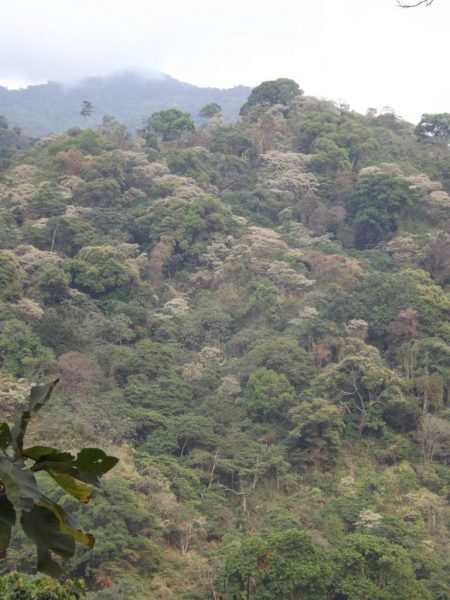
The massage wasn’t entirely what I’d expected. It took place in the same place as the yoga class, facing the vivid green forest filled with darting birds and colourful butterflies, and began with me seated on a stool, practicing good posture (apparently I hold my chin too high) and breathing excerices, including fire breathing (fast breaths in and out, heaving my diaphragm up and down). The instructor, a very enthusiastic guy with a growling voice and a tendency to run off on tangents on the importance of energy, told me to open my nostrils wide when breathing in, to allow maximum oxygen to reach the ‘energy centre’ at the front of my brain, just at the top of the nose. “More oxygen, more energy, better perception, better consciousness”.
After the breathing exercises came the proper massage, which was great. Sam complained that his was too hard, with too much pressure, but that’s my favourite kind of massage. I felt my joints click and soften up, slowly recovering from the strains of yesterday. Slightly off-putting were the humming noises, chants, loud commands for fire breathing (very difficult when you’re face down on a massage bed) at random intervals and continuous insistences for me to let Gaia in to speak to me (“she has many gifts for you”) coming from the masseuse, but, ignoring those, it was a really good massage and exactly what I needed after the dreaded hike of the day before.
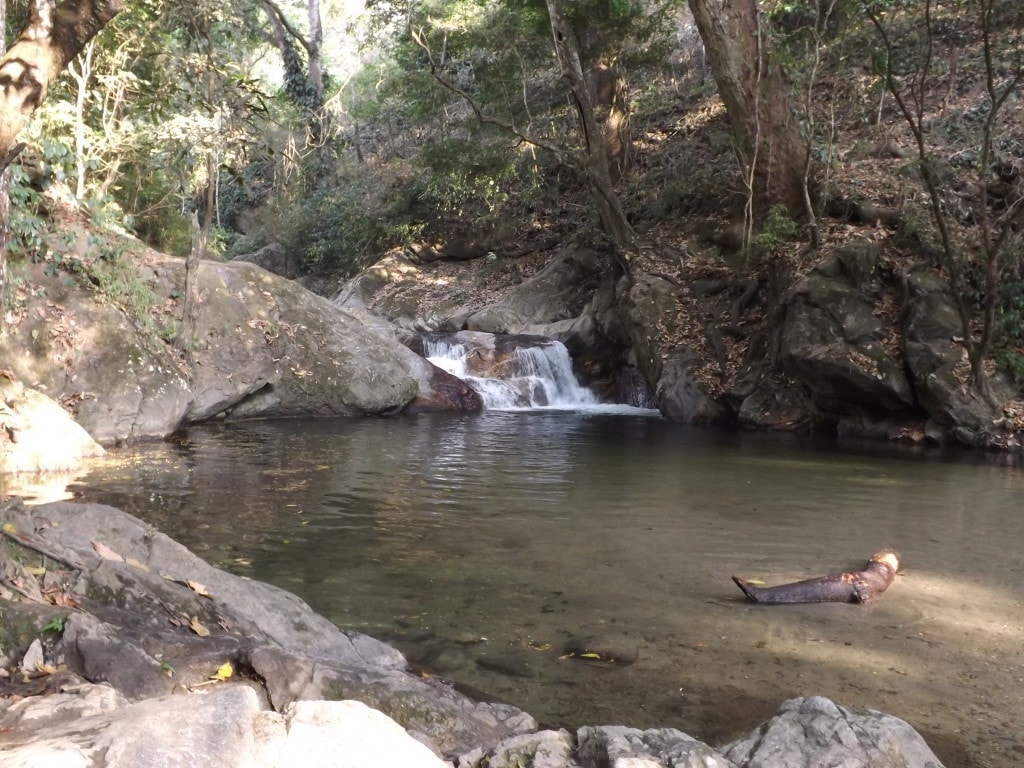
After our massage, we headed to a wifi cafe in Minca for lunch (there’s no wifi at Casa Loma, which completely adds to the peace up there) and I cooled off with a fresh, natural lemonade; my favourite drink in Colombia (sweet and sour and made with lots of sugar!). Afterwards, we set off to the nearby Pozos Azules, a series of deep swimming holes fed by small waterfalls.
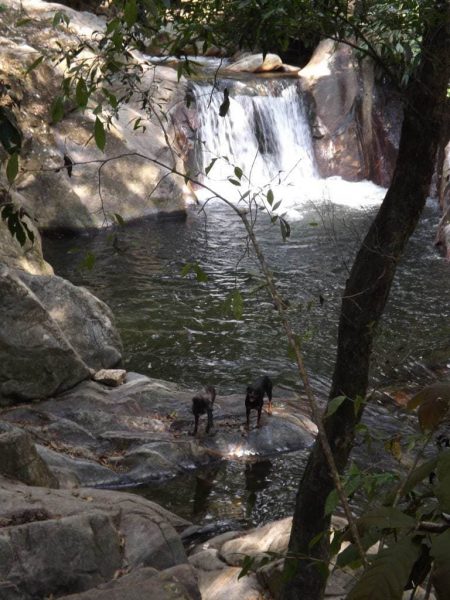
We couldn’t face another walk – even the hour or so it would take to get to the pools – and there are no car taxis in Minca, so (Dad, don’t read this part) we took a moto taxi, which is a popular and cheap form of transport in Colombia. Basically, we hopped on the back of motorbikes and were driven to the pools. The drivers know every crack in the roads around Minca and are clearly really experienced, but that didn’t stop my heart leaping into my throat as we sped down a bumpy dirt track, me clinging to the back of the bike for dear life. The ride was very nerve racking but also pretty fun, and since I’ve never been on a motorbike before I felt pretty pleased with myself for having braved it.
At the pools, we bumped into Ed, the owner of Casa Elemento, for a third time and he recommended us to climb up to the second pool which is much bigger and into which you can jump from the top of the waterfall (about seven foot or so above the water level). So, we headed up there and slipped into icy cold but incredibly clean, crystal-clear water which tasted fantastic. The pool was pretty secluded, with just three other people there besides us, and it was a gorgeous experience to swim in the river completely surrounded by thick, green forest and a penetrating silence. Just like at the Cascades Marinkas, the rocks around the pool were full of quartz which made the water sparkle as though filled with gold glitter.
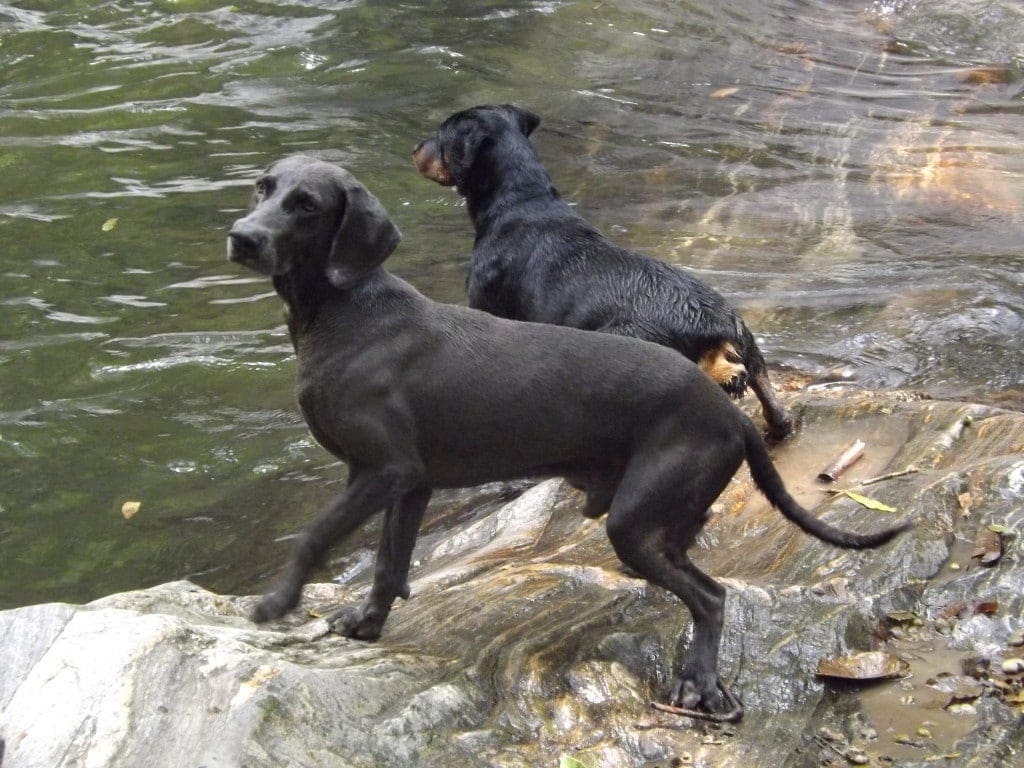
There was a local boy at the pools with his two dogs – big, silly animals which kept chasing the same stick and then scrabbling out of the pool with it clamped firmly in both their mouths – and he climbed up to the top of the waterfall to jump in. Sam, and another tourist who was there with his girlfriend, soon followed suit, plunging into the deep water from the top of the fall, with the local telling them both exactly where to jump from and where to aim for. As recently as five years ago, it was unsafe to travel to Minca, so the locals there, even more than the rest of Colombia, are extremely grateful for the tourism which is bringing a lot of profit to their little town, and are therefore very friendly, helpful and protective of tourists. The boy appointed himself our unofficial guide, letting us play with the dogs and showing us where it was safe to jump in.
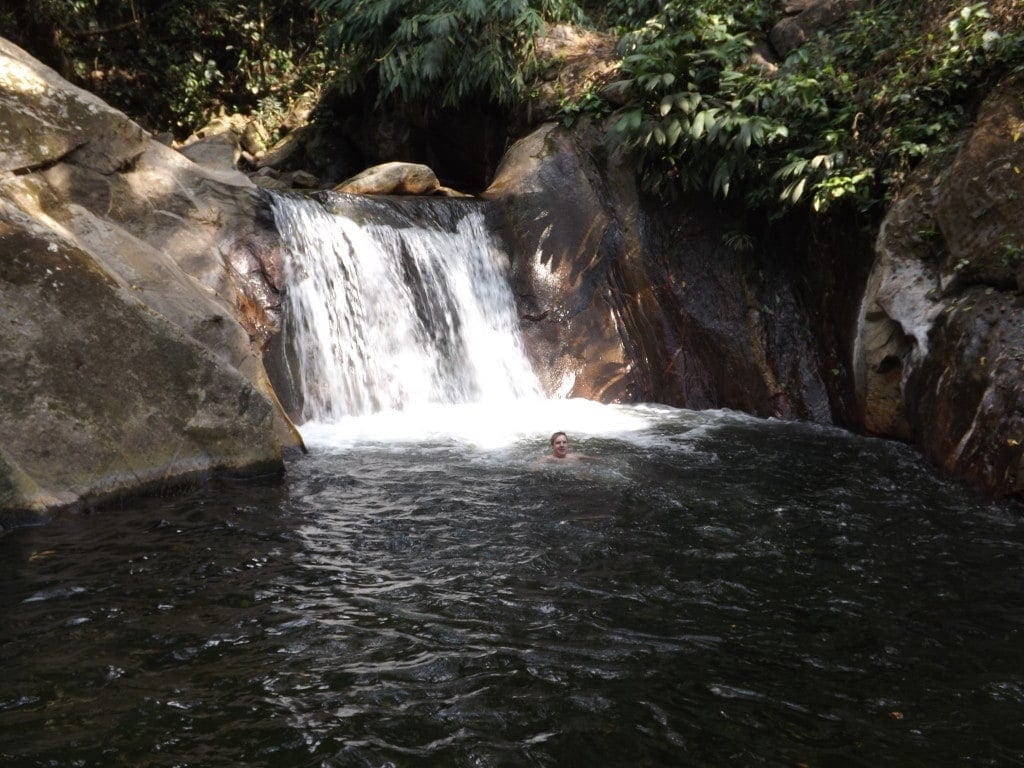
Having tested the depth of the water, I plucked up the courage to jump off one of the smaller rocks into the pool. I am a notorious worrier and have a tendency to over-think everything; I’ve also developed a fear of heights in the last few years which is pretty new to the girl who once climbed out of her attic bedroom window to sit on the roof. One of my New Years resolutions was to try to be more brave, to “jump in without analysing first”, so I decided that I also had to have a go at jumping off the top of the fall. But, once up there, and even with repeated assurances from Sam and the others who had all gone before me, I found that I could’t do it. My heart raced in my throat, my whole body trembled so that my knees jerked with the shaking, and absolutely nothing could get me to take the leap forward once I’d looked down. So, feeling like a complete failure and very miserable about it, I had to climb back down on foot.
Later on, back at Casa Loma, I consoled myself with the knowledge that I’d been brave enough to ride on the back of a motorbike, and to jump in from a smaller rock, but even so if sort of clouded over the fun of the afternoon, because I was so disappointed with myself. Next time the opportunity comes to jump in feet first, I’m going to force myself to take it; because a huge part of travelling is to grow, get braver, and face things that you would normally avoid.
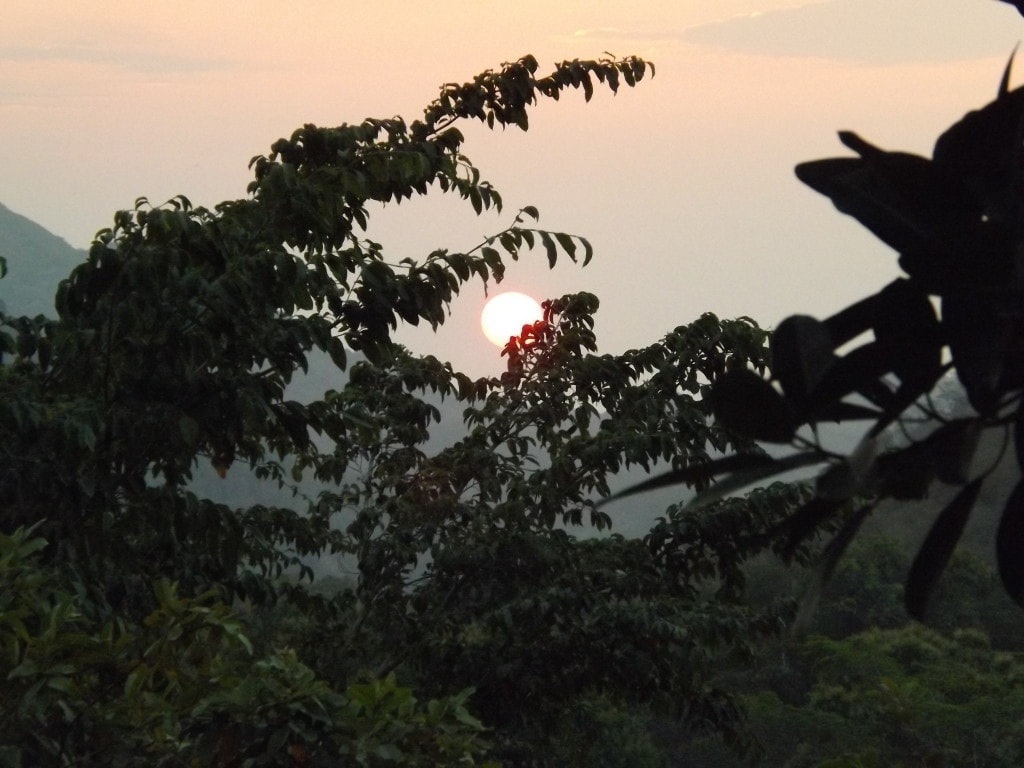
The day ended with a “Forest Cinema” at Casa Loma after dinner; a Wes Anderson film projected onto a screen up on the decking on the hill where the yoga class is held. Every now and again, the scream of a Megabug (see part two) would drown out some of the dialogue, but that’s all part of the experience, and there’s nothing like watching a film under an open sky filled with more stars than I’ve seen in a long time.
It was our last night in Minca, and we’d well and truly fallen in love, so the next day we slunk back to Santa Marta with heavy hearts. But, carnaval was calling, so we had to leave all the magic of Minca behind and head back to the real world once again.
Carnaval in Barranquilla
First Published: 18/03/2014
After three days in the gorgeous mountain town of Minca, surrounded by silence and the monochrome green of forest filled valleys, the colours and crowds of carnaval in Barranquilla suddenly sounded a little daunting.
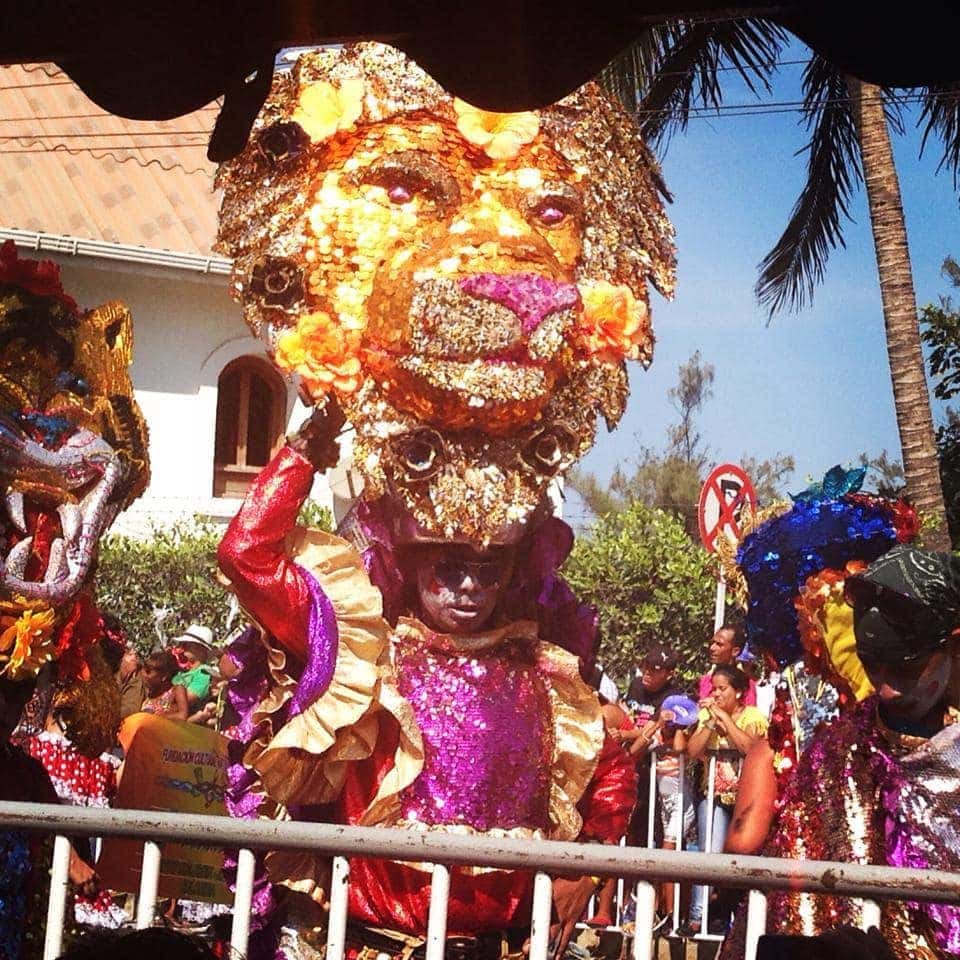
Especially because we had nowhere to stay in Barranquilla, and knew that every bed in town had been booked for months. Not wanting to fork out £100 a night for a hotel – and certainly not optimistic enough in our energy levels to partying until the first bus out of Barranquilla at six am the next day – we had no choice but to head back to Santa Marta and plan a day trip to Barranquilla for the first day of carnaval.
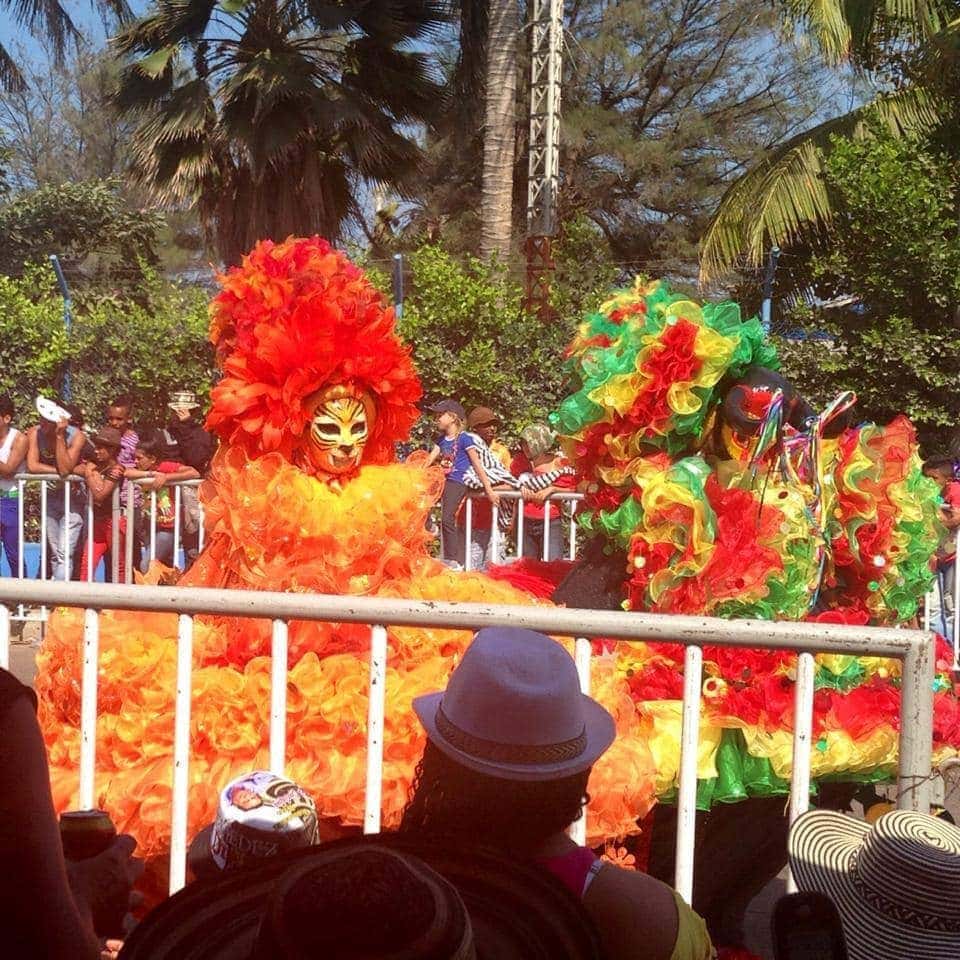
So, we headed back to the fabulous Drop Bear hostel, which was was holding a carnaval party that night – complete with a traditional band and a dance act out by the pool – so we sat outside with a few mojitos and got ourselves in the mood for carnaval!
The next morning we headed off to Barranquilla at about 10am with a bus load of Drop Bear guests and a bottle of the fiery, sambuca-esque Colombian drink Aquardiente being passed around (although, since I was hungover and it is a disgusting drink, I declined). Two hours later, we had arrived in a baking-hot, sticky Barranquilla filled with empty streets and closed shops; the whole city having drained to the centre to line the parade route.
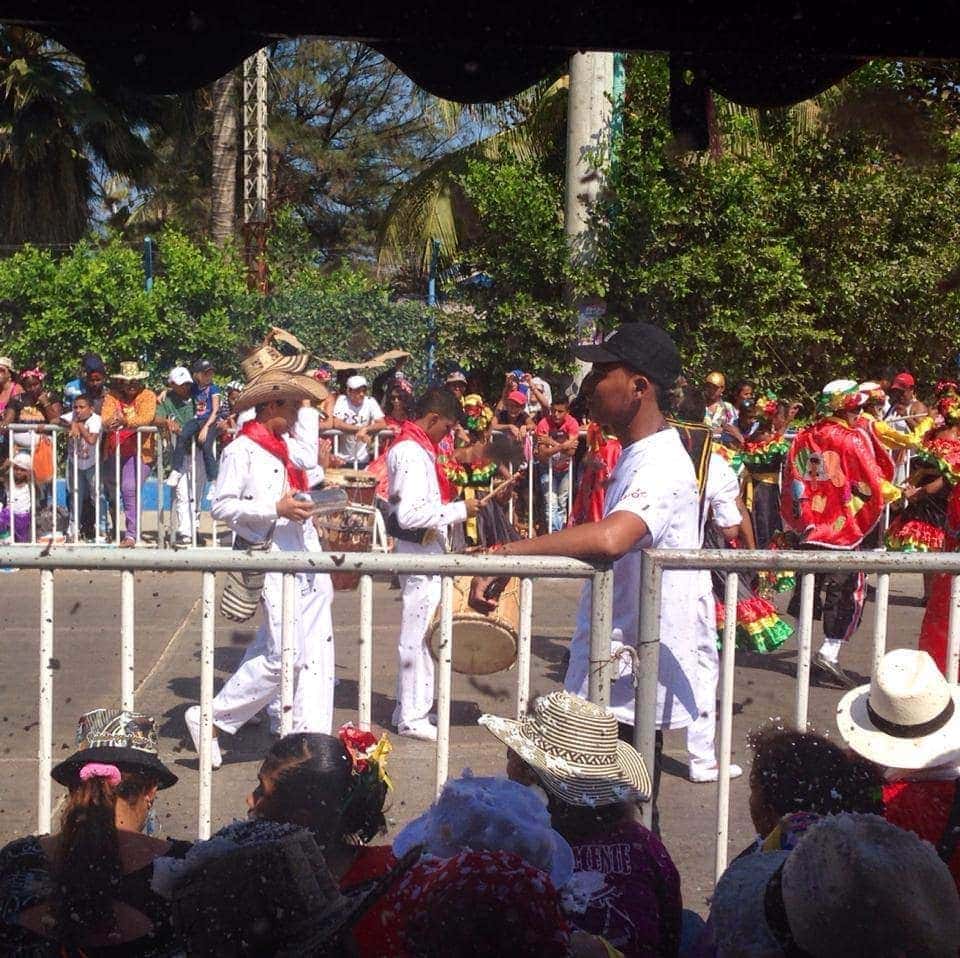
A short walk later and we had joined them, finding ourselves stumbling through a confused crowd of hawkers, barbecues, stalls laden with sombreros, wigs and costumes, guys with coolers full of beer, dancing locals, snow-cone carts, costumed party-goers, and endless foam ejected from aerosol spray canons that appeared to be the highlight of carnaval for most locals. Being gringos, we quickly became a popular target and were coated head to toe in foam, but it was all part of the atmosphere – so we bought our own canon and joined right in.
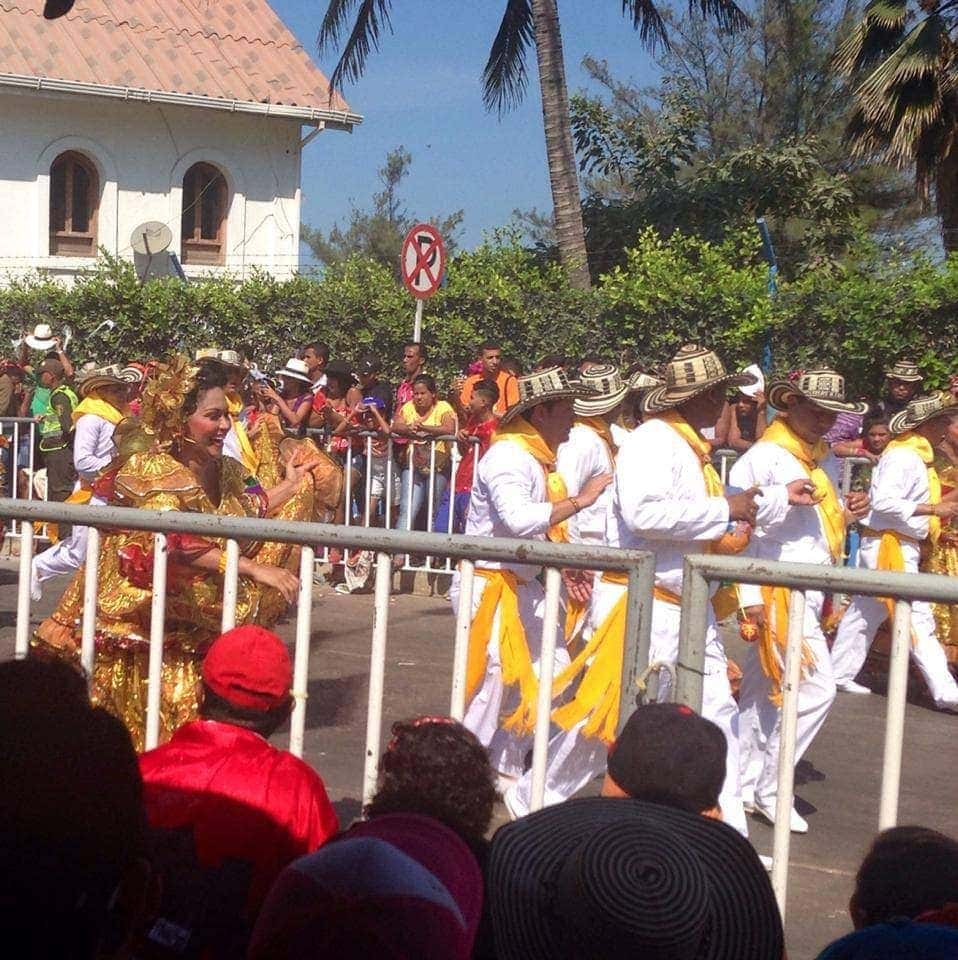
It took a long time for the parade to reach us – we were stuck right at the end of the route in the “cheap seats” with all the locals – so we made the most of that time by moving through the crowd to have a look. We ate some barbecued sausages skewered into kebabs with baked potatoes and peppers – delicious – and cooled down with super-sweet, syrupy snow cones, while we waited for the first signs of the parade, which eventually turned up in the shape of Colombia’s favourite song of the moment: Mr Black’s El Serrucho (not a day passes where we don’t hear that song at least twice) which seemed to be the theme of the carnival. We bought seats in the shade to escape the painfully strong midday heat (15,000 COP each for seats, shade, and a view of the parade route which was otherwise obscured by the crowds) and watched the parade approach. Led by tributes to the military, police, navy, fireman and other services in Barranquilla, the parade finally got started. It was huge; far bigger and longer than I was expecting (a good three or four hours) with endless groups of hip-shaking dancers, marching bands, people in costumes so varied it was ridiculous, folk dancers in traditional dress, floats, and celebrities (including a few from the Colombian football team), all ploughing forwards with joyful smiles in the heat to the endless, pulsing beat of cumbria – although some of the dancers seemed to have flagged a little by the time they reached us.
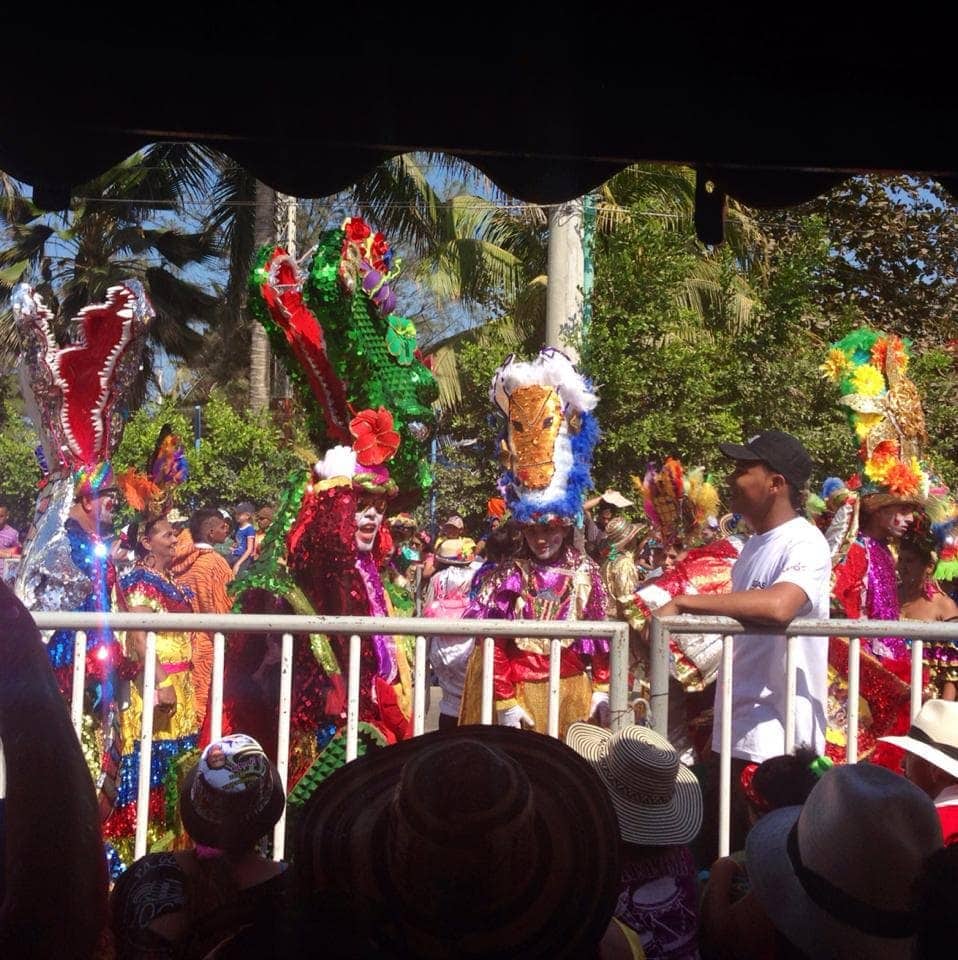
The first day of Carnaval, on the Saturday before Ash Wednesday, is the Battle of the Flowers and has the biggest parade consisting of the greatest and most colourful creations. The floats were particularly incredible, one of which housed an enormous, animatronic caiman opening and closing it’s bright green jaws over the head of a pink-frilled carnaval princess. I loved the gaudily pink float from which Carnaval Queen Maria Margarita Diazgranados Gerlein (who had her own theme song) waved to the adoring (and they really were adoring) crowds in her huge, tinselled, hot-pink cupcake dress. The dancers were all incredible, as well, with frilled dresses whose swirling colours evoked the spirit of a battle of flowers, and whose shaking hips were almost impossible to believe. So many different costumes emerged throughout the parade, each one more bizarre than the last: men in drag, giant babies, a huge crowd of neon green snakes, Obama and Osama walking side by side, Dracula, bears, caimans, Mr T… the list goes on. Everything was a bit surreal, coated in foam with lurching shapes and colours, and a surging crowd.
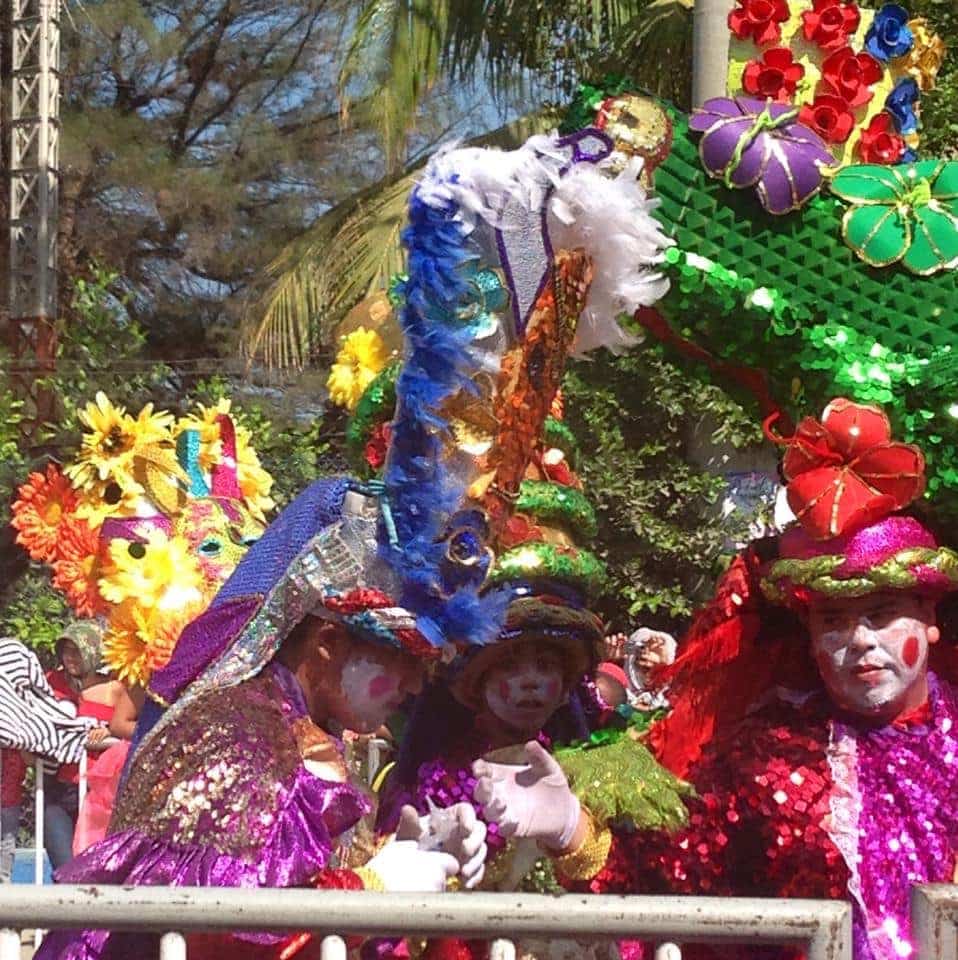
Eventually, the parade became a bit much, so we backed out of the ‘seating’ area, which had become a slippery, foamy whirlpool of bodies shoving and standing on chairs, desperate for a glimpse of some Colombian pop princess. En route, Sam had his phone stolen from his pocket, which added to our sense of despair at the claustrophobic crowd and giddy kaleidoscope of parade and pumping music. I thought we’d have to go home early, but then we bumped into a few friends from Drop Bear and a few drinks and jokes with them soon made us feel better. Pretty soon, we found ourselves surrounded by locals wanting to talk to us, introduce themselves, and take photos with us – especially with Sam, who for some reason is incredibly popular with twelve year old Colombian girls! They would shyly pose for a photo and then run off shrieking with delight. It was a bizarre experience, but everyone was so genuinely friendly and lovely, and so excited to meet us (two white, blonde people must look so out of place in that dark skinned, dark haired mass of bodies) that it was a really fun experience, and the highlight of carnaval for me. A few men came up to me and just told me their names and shook my hand – happily chatting away to me even though I couldn’t understand a word. One girl in particular, a skinny, beautiful little eight year old with huge, shining dark eyes, really caught our attention and we made a big fuss of her; she came up to ask for a photo and rung her hands with such exquisite delight when we said yes, smiling her massive happy smile, that we all just fell for her instantly.
At the end of the parade, we walked with her family through the pressing crowd, until it surged through a bottleneck gap at the end of the street and we were separated from our new friend. Luckily, about thirty minutes later her bus stopped in traffic next to us and we spotter her waving madly from the window, so we ran over for a last quick high-five and a kiss on the cheek.
My experience of carnaval was surreal and dreamlike – at times almost nightmarish, given the hideous crowds, stolen phone and me cutting my foot on the walk back to the bus, having to patch myself with a scarf and limp on so that we didn’t miss it – but the experience that was totally worth it, to meet all those wonderful Colombians who welcomed us into their tradition with open arms and wide smiles, and especially to meet that gorgeous little girl, so pleased to see us and to practice her English “good morning”. Although we couldn’t get back for any of the other days of celebration, it was an incredible experience and I’m so glad to have shared in it.
Information About Barranquilla Carnaval
Book a hostel months in advance if you plan to stay in Barranquilla, and be prepared to spend a lot more than usual for a bed.
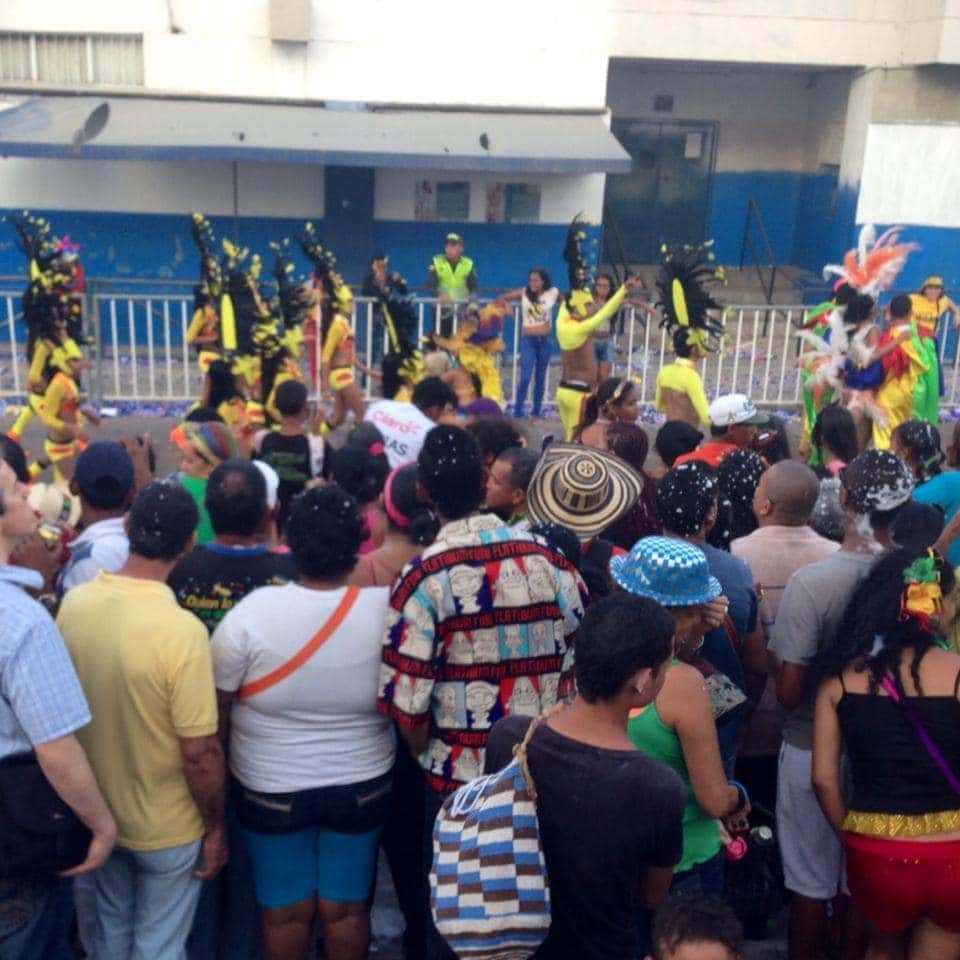
Alternatively, MarSol run buses throughout the day from Santa Marta (and other buses leave from the Terminal) for about 20,000 COP.
Apparently, you can book tickets for VIP areas in front of hotels and other private sections of the parade route – for a clearer view and less crowds – although I preferred getting stuck in with the locals towards the end of the parade route.
Don’t take valuables! Have as little cash as you need on you and keep it in a zippered bag or money belt. We met numerous people who had unfortunately been pick-pocketed or had their bags slashed, and unfortunately Sam was unlucky enough to get his phone stolen. It’s a common trick, someone will spray foam straight into your face and eyes, and while you wipe them clear they will lift whatever is in your pocket. Be vigilant and if possible get an anti-theft bag.
First Day in Cartagena
First Published: 28/03/2014
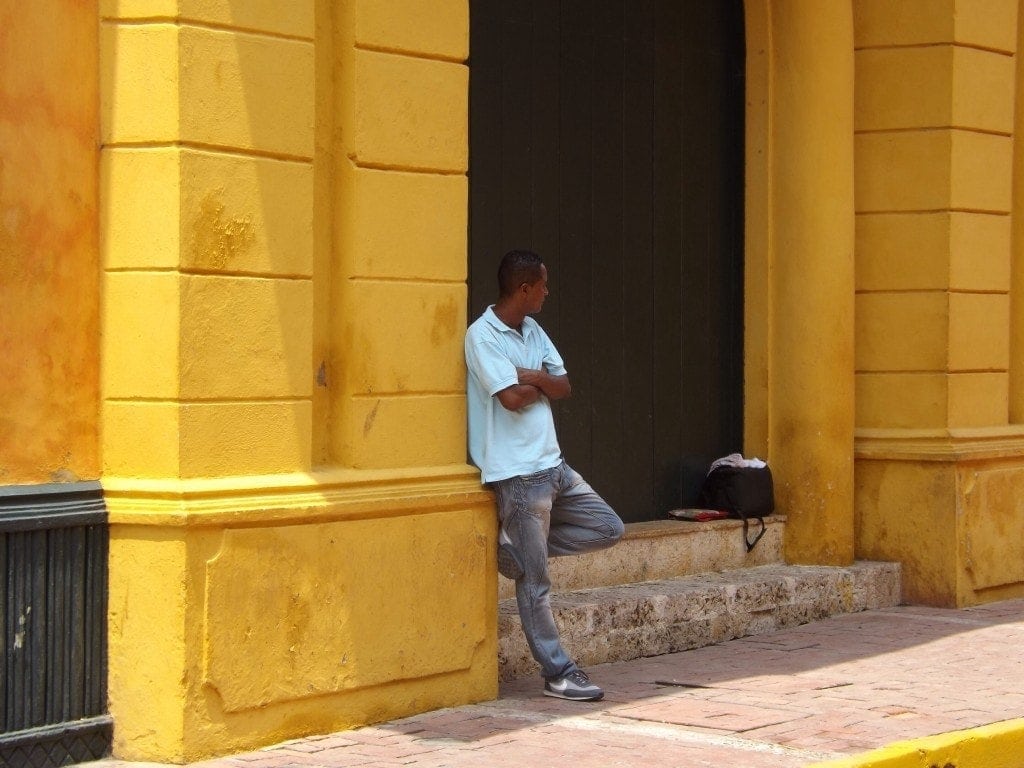
Our arrival in Cartagena three weeks ago seems so long ago now it’s almost hard to write about it.
A broken laptop, sporadic wifi, and a lot of travel in a short space of time has left me very behind with blogging, so it seems strange to be writing about the bright and colourful Cartagena on the glittering Carribean coast, while through the bus window I can see the arid landscape of brown mountains, sugar plantations, and dusty yellow or brown houses that surround Chiclayo in Peru.
But the heat is the same, an oppressive white heat that is stronger than anything I remember feeling before so that makes it easier to recall.
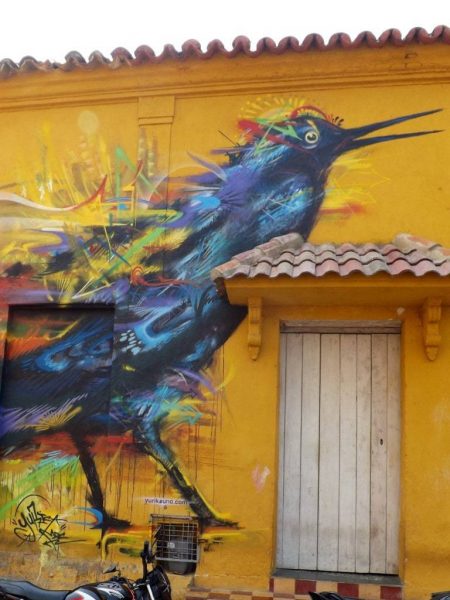
When we arrived in Cartagena it was evening, still hot but stuffy with the darkness. It was the first time we’d arrived somewhere without making a booking, something we instantly regretted as we were turned away from the hostel we’d been recommended, then five others. Weary and downhearted, we were traipsing down one of the narrow streets in Cartagena’s old town centre, buckling under the weight of our backpacks, when we found Donald, the Jamaican owner of the Cuban-themed bar Casa del Habans. He had a perfect American accent and the friendly confidence of a man who knows everything, and certainly he knew everything about Cartagena that seems needed to be known. Donald quickly saved the day, pointing us in the direction of The Roof, a hostel on the edge of the old town – “the roof always has beds” – before making us promise to come back to try his mojitos, again with his easy confidence: “you don’t like my mojitos you don’t pay”.
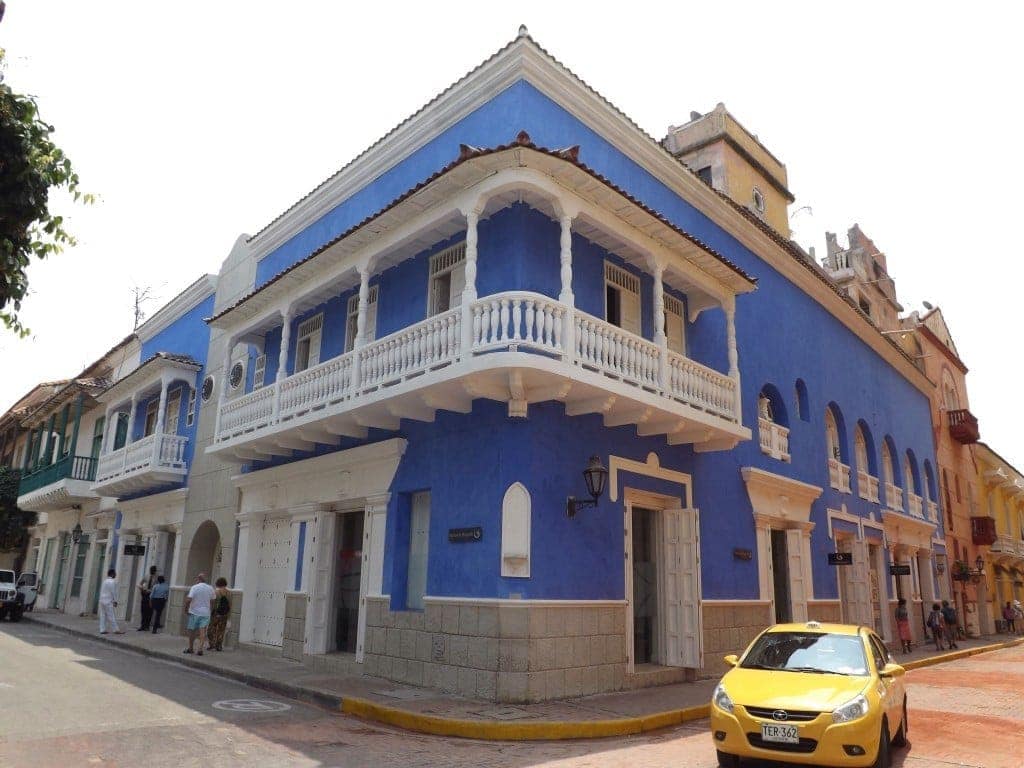
Once we’d checked in at The Roof, where, of course, they did have beds, because they always have beds, we dutifully headed back to Casa del Habano to try Donald’s mojitos, which were, of course, delicious. Possibly the best I’ve ever tried, they were very different to most mojitos – much greener for one thing, and juicier – although Donald maintains that the secret ingredient is simply “lots and lots of tlc”. Not only did he sort us out with plenty of drinks, but as soon as we mentioned eating Donald produced the menus for two neighbouring restaurants and, once we’d chosen, had our food – two big plates of delicious creamy pasta – delivered across the street to the bar by the restaurant’s staff! After eating, we spent the evening chatting to Donald and his friend, an American expat named Dia, mining them for more tips about our latest destination, especially about the best beaches nearby.
It was the perfect welcome to Cartagena, a beautiful, relaxing city that loves it’s tourists and, more importantly, loves to have a good time!
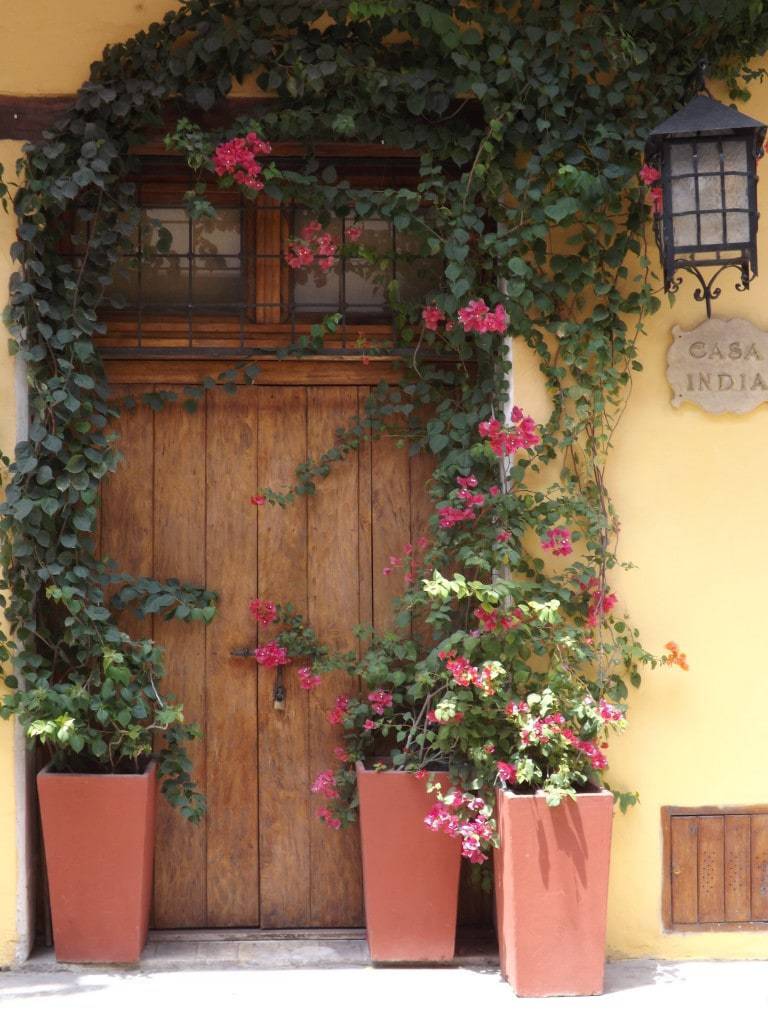
After our first evening in Cartagena, I was already in love, and woke up the following day ready to explore. I’d found a helpful website with tons of great recommendations, and using a freebie map from the hostel we put together a jam-packed day tour that would let us see plenty of the city.
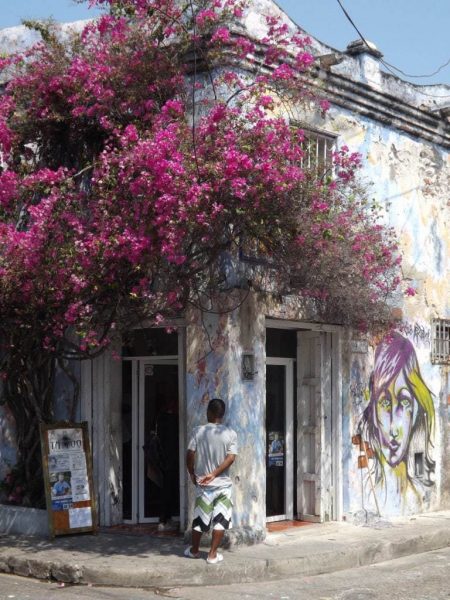
Starting at our hostel on the edge of the walled section of the city, we dived into the old town; an intricate net of narrow streets lined with beautiful colonial buildings. There was so much colour everywhere – pink, blue, orange, yellow, white, red – and the buildings, mostly in lovingly restored conditions with fresh paint (although equally pretty were the peeling, faded facades of less well kept buildings) had beautiful details like wooden window boxes, iron grilles, or colourful trailing plants climbing the walls. I could gush and gush about how pretty the place is, but I don’t think I could ever do it justice – the cramped streets closing over at the top with leaning balconies and window boxes, bursting with flowers; the stalls of fruits or icy fresh lemonade; the women in brightly coloured traditional dresses… it’s just one if the most beautiful cities I’ve ever visited: a vibrant fusion of antique European and lively Caribbean styles.
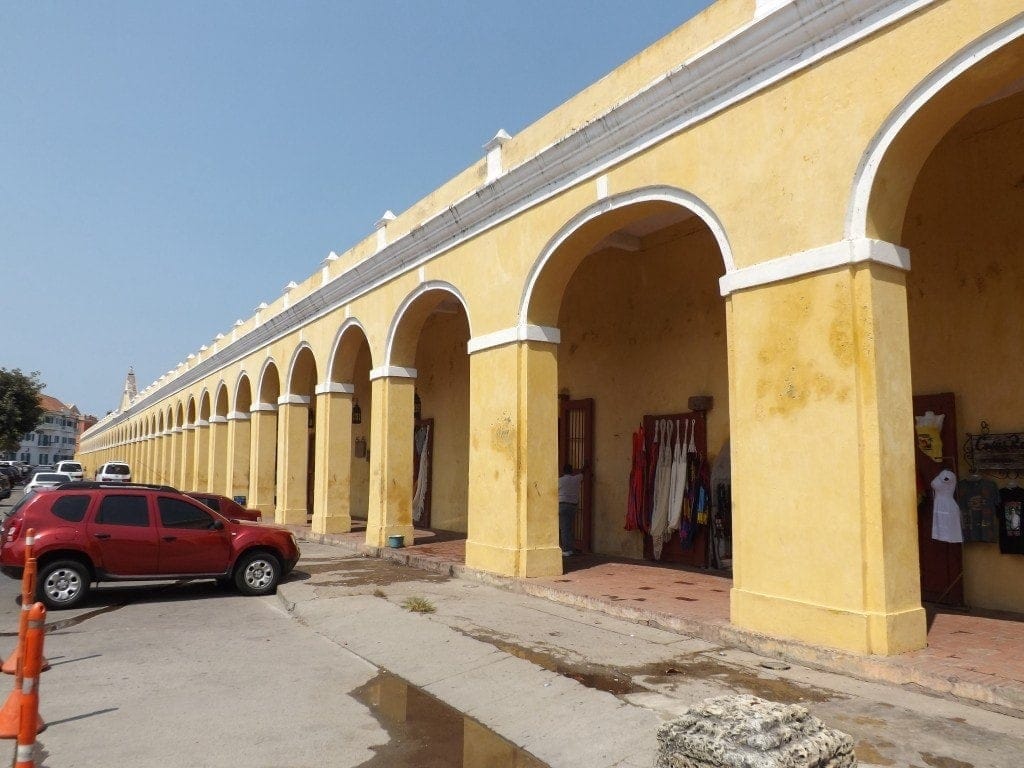
In the northeast corner of the old town, we came to las bovedas (the vaults). One-time army storage vaults, these small, tunnel-like spaces behind sweeping yellow arches have been converted into beautiful souvenir shops. I’m not usually interested in these kinds of things, but the shops were really good and very fun to browse, selling loads of authentic hand-crafted goods like shoes, jewellery, leather bags, hip flasks and more – as well as a great selection of Colombian emerald jewellery, and the usual souvenirs like key rings and postcards.
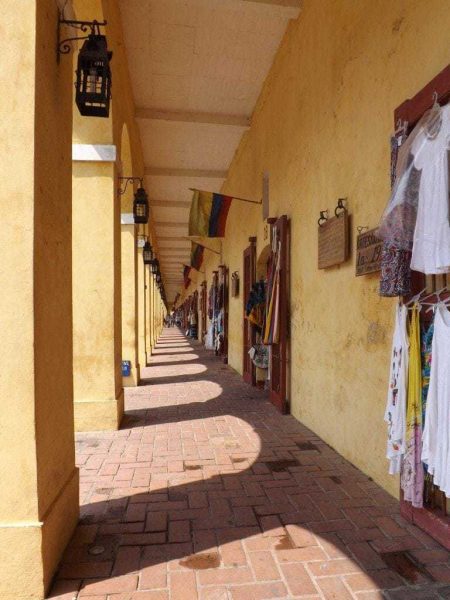
Above las bovedas are the city walls, thick sturdy walls built by the Spanish in the 16th century, lined with rusting canons. We strolled along the wall opposite the ocean, enjoying the sea breeze ruffling the palm trees and cooling our hot, sticky skin. By mid morning, the city was already overwhelmingly hot; a heavy, white heat that hung on our backs and drenched us in sweat, slowing our every movement, so the sight of the sea and the whipping wind were welcome relief. Even that wasn’t enough, though, so eventually we turned back into the city in search if aircon and a cold snack.
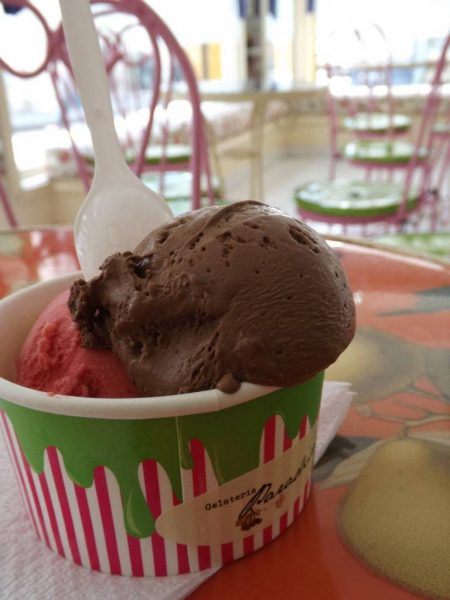
We found it in the shape of Gelateria Paradiso, a beautiful, boutique ice cream parlour with a pastel pink and green vintage inspired decor, elegant iron chairs, and an icy air conditioning system. The array of colours and flavours behind the counter was almost overwhelming, but luckily the lovely manageress let me sample a few before a made my final decision – mora (raspberry) and chocolate, a delicious combination. Sam had the tangy and super sweet limonada de coco (coconut lemonade) which is a must try at this gorgeous gelateria.
Sufficiently cooled and refuelled, we headed back into to baking streets and wound our way to the Plaza Bolivar, a green and shady square with fountains and benches, overlooked by grand two-storey buildings. One of these was the Palacio de la Inquisicion, a building once owned by the Spanish church and used, among other things, for the torture and execution of religious prisoners, heretics and witches.
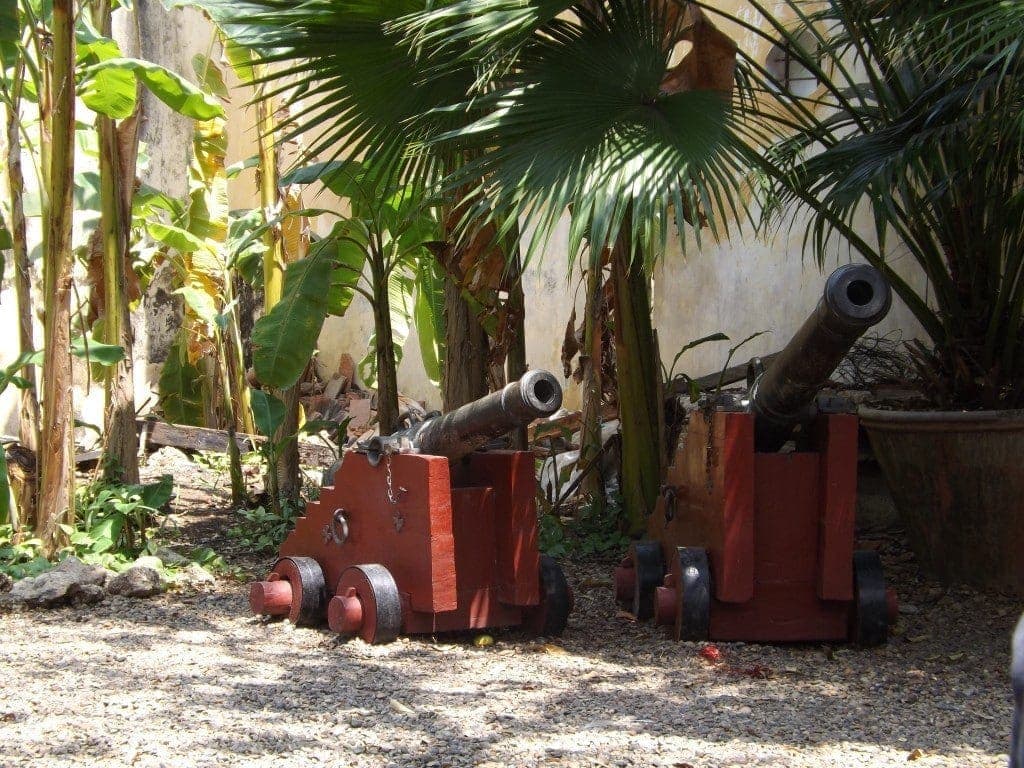
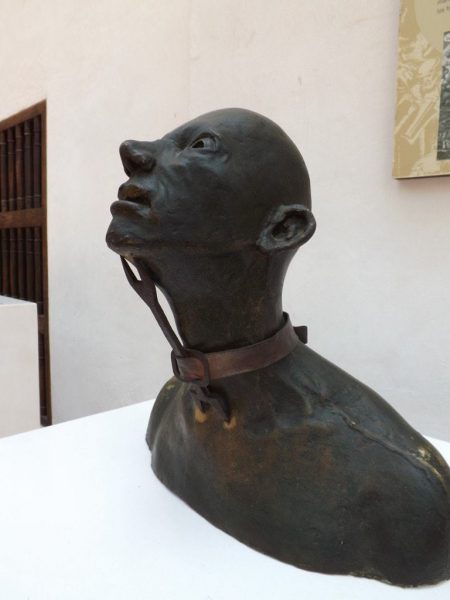
You wouldn’t think the place had such a dark history to look at it; a lovely example of a Casa Alta (literally tall house: two or three storey mansions set around an inner courtyard, which were reserved for the rich and social elite) with a cool, richly decorated interior of black and white marble floors and thick wooden doors. We found the antiquated torture implements in the quiet, leafy patio area surrounded by crumbling rock walls and flowering banana trees. The morbid instruments – spiked collars, a stretching rack, a menacing guillotine – sat silently amongst leafy plants in a picturesque setting, almost distracted from their grizzly history if it weren’t for the illustrated notes describing how and for whom each one was used. The most haunting was perhaps the gallows, with a noose just slightly swaying in the breeze, silent and brooding in the corner of the courtyard. Looking at the wooden trapdoor beneath the noose, I couldn’t help wonder how many innocent pairs of feet had kicked and struggled there, hung for half imagined crimes by the over zealous Spanish church.
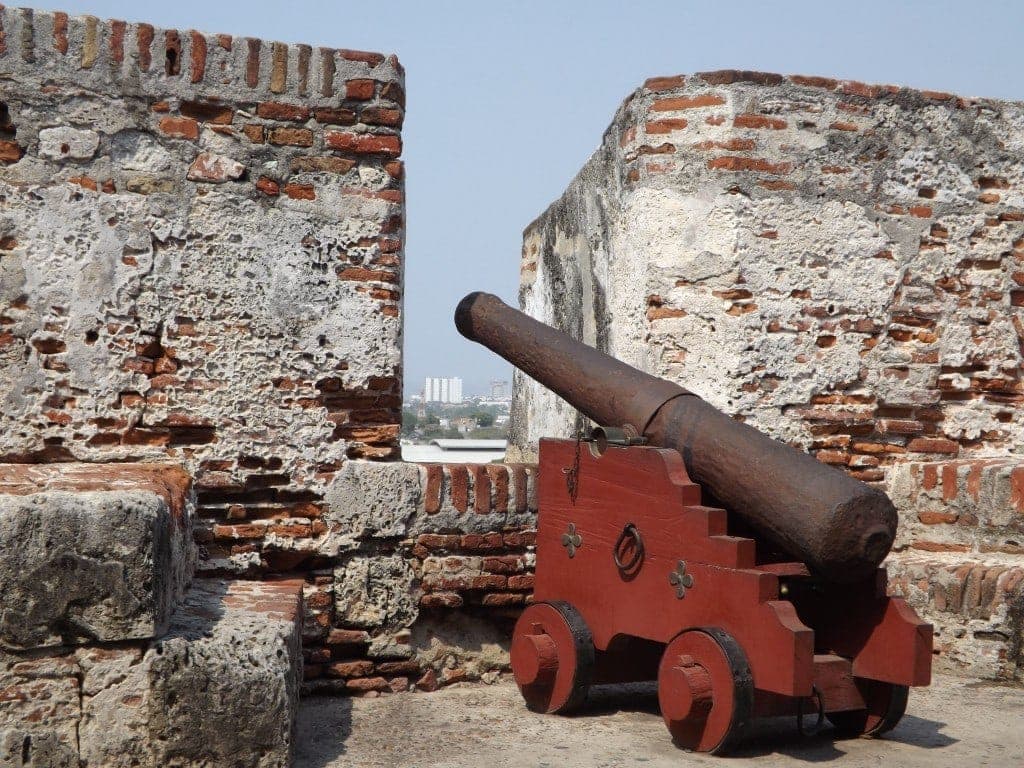
Morbid curiosity sated, we left the beautiful old building and headed into another part of Cartagena’s old town outside the old city walls, La Getsemani, passing the old cathedral and the yellow clock tower on the way. The beautiful buildings and bright colour schemes continued here, perhaps in slightly worse condition that before, but still wonderfully picturesque – I could hardly put down my camera, constantly spotting more lovely details. We stopped in the a Plaza de la Trinidad for lunch before continuing out of La Getsemani and over the bridge to the Castillo San Felipe. This ancient fortress, bedecked by turrets and rusting guns and reinforced by an immensely sturdy outer wall, overlooks the old part of Cartagena like its personal guardian. Built in 16th century and expanded over the 17th and 18th, it has an interesting history as a key player in the war against the British in 1741, but today the castle serves as a viewpoint for groups of tourists, providing stunning 360 views of Cartagena – both the old and modern parts of the city. Aside from the view, the castle doesn’t have much to offer, but wandering through some of the skinny, dimly lit interior passages was pretty fun!
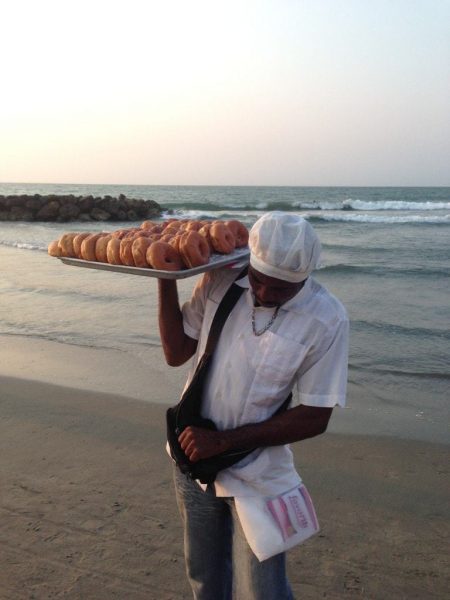
By late afternoon, we were pretty much worn out from sightseeing and fully beaten by the sun, so we hopped in a taxi to the beach at Bocagrande. Old big mouth is the wide bay fronting Cartagena, and the beach there is a long strip of sand lining the piece of land that sticks out into the bay. This is the modern, expensive area of the city, the beach is backed by skyscrapers and fancy hotels and looks more like Miami than Colombia. As with most beaches in Colombia, there were dozens of people selling souvenirs, drinks and snacks on the beach – including a man with a tray of enormous sugary doughnuts, which were fantastic! It’s certainly not the prettiest beach we’ve visited, but it was clean and very fun.
We spent the rest of the day in the water, surprisingly warm with strong, fast waves that were great for leaping and splashing.
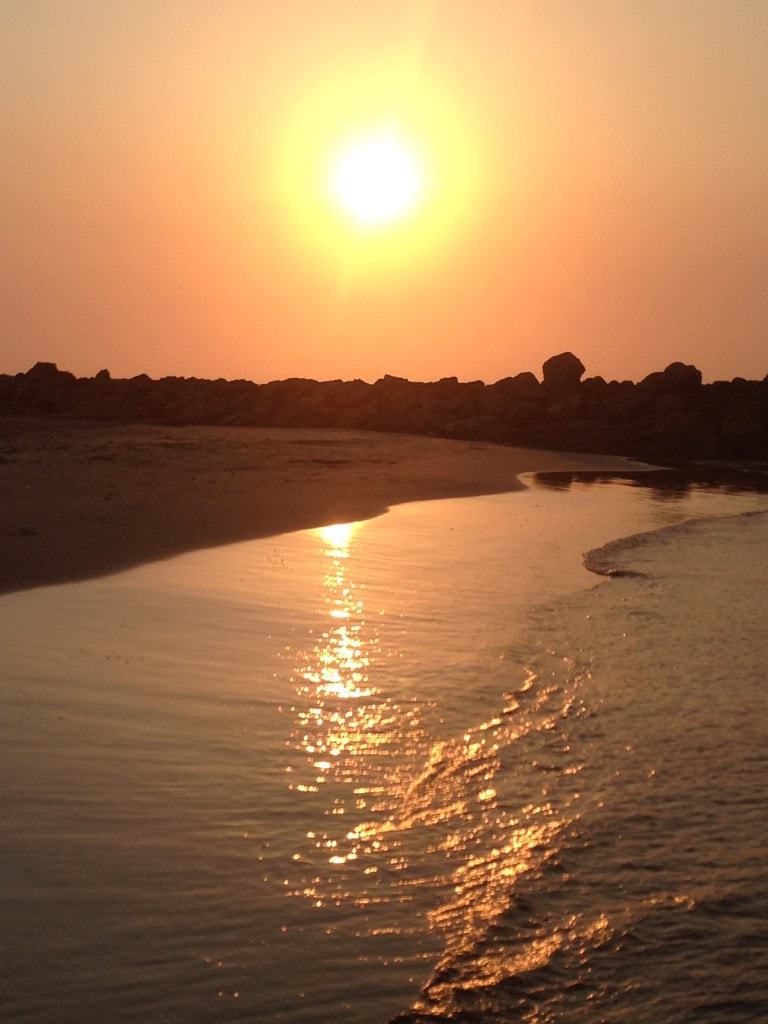
We swam until the sunset over the sea; a vivid ball of shivering gold sinking down a clear sky, painting everything pale orange and turning the water into glittering light. It was the perfect end to a fantastic day in my favourite Colombian city, Cartagena.
Playa Blanca, Cartagena
First Published: 29/03/2014
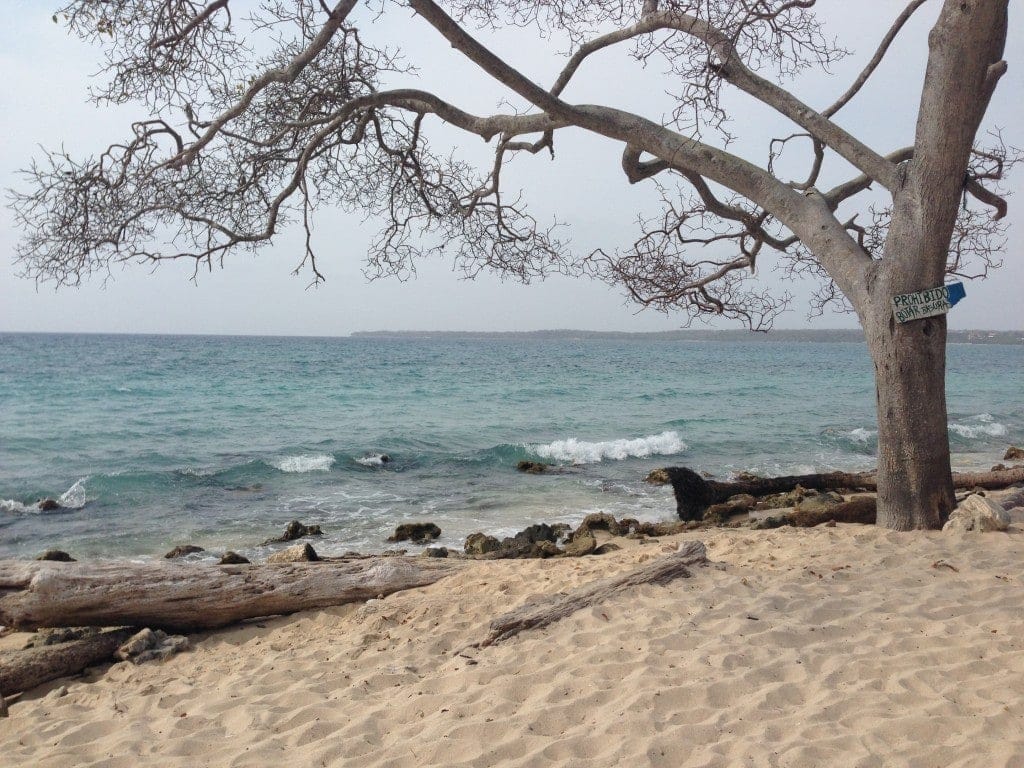
After a fantastic evening on the lovely, but rather plain, Playa Bocagrande in Cartagena, Sam and I were desperate to get a glimpse of the beach advertised as the area’s best, Playa Blanca. It’s on the Isla de Baru, part of the Rasarioa archipelago and national park, and the easiest way to reach it is by boat.
Most people head to the port and wind up with a pricey ticket for a tour through the archipelago which lasts a few hours, stops at an aquarium which by most accounts is fairly boring, and finally finishes at Playa Blanca up at the busier ‘touristy’ end.
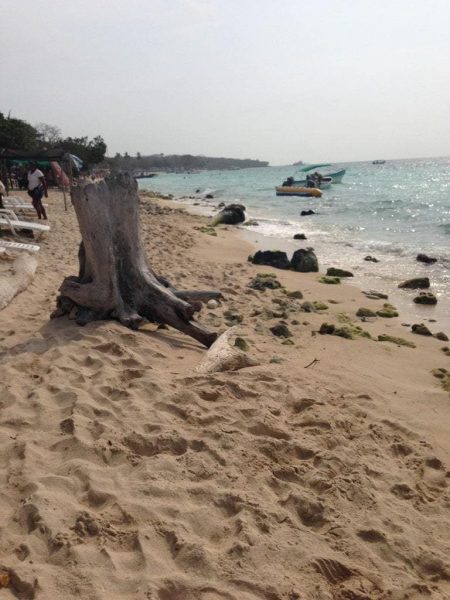
Thanks to our hostel owner, an enthusiastic guy with a hint of a New York accent, we avoided all that; he sent us instead to the Mercado Bazurto market port, where he said we could buy much cheaper tickets for seats on a cargo boat.
When the taxi pulled up at the market – a sprawling, shabby network of stalls, guys pushing carts, stray dogs, motorbikes, wholesale stores, and litter – I was a little daunted, but knowing we wanted the ‘lancha’ for playa blanca our driver pulled up alongside the intensely busy market port and called over a ticket tout who offered us passenger seats on board a small motorboat. Soon enough, we were sitting amongst an ever growing pile of boxes, sacks of potatoes, bags of onions, toilet rolls, vegetables, trays of eggs, drums of gasoline, and who knows what else; but it was almost an hour and a half before the boat was deemed full enough of bodies and cargo for us to set off, by which time my buttocks were numb and my leg had fallen asleep from my cramped position sharing a seat with a sack of potatoes.
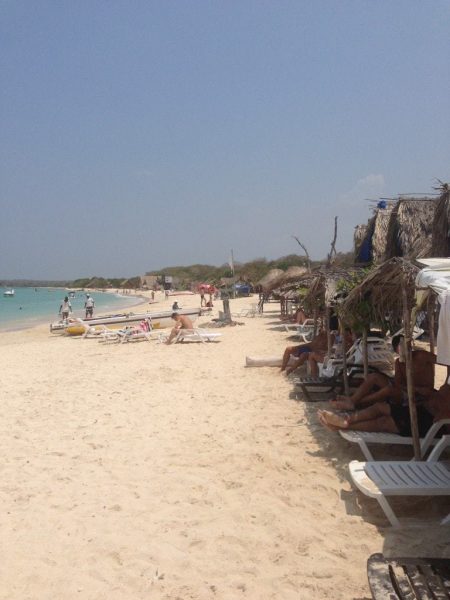
The boat ride was uncomfortable but fun; speeding over the water on a motorboat, the view blocked by a wall of spray. After about forty five minutes, we pulled up at an almost empty section of a seemingly endless stretch of pristine white sand, backed by thick green forest. The view as we flew towards it on the motorboat was stunning, exactly the image that springs to mind when you think “Caribbean Coast”.
The beach was lined with restaurants and campsite-style hostels, all built from wood with palm frond roofs and a decor of driftwood and painted shells, giving Playa Blanca a chilled out atmosphere of having truly escaped, making it perfect for travellers.
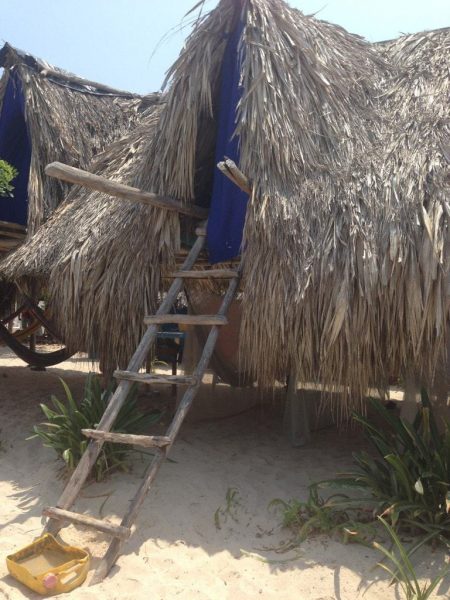
We ‘checked in’ at the first hostel we came across, Hostel Any, a row of stilted individual huts facing the ocean, with camp beds inside them or colourful hammocks below. The owner, a really easygoing guy who seemed to pretty much live on the beach, rented us a hut for 40,000 cop, then went back to gazing dreamily at the sea. This was extremely rustic accommodation; just roll mats and sheets for furniture, a curtain for the door, wind for aircon and the sound of the sea to send you to sleep, but although the bathroom was – putting it lightly – extremely unpleasant, it was a great place to spend the night, and so peaceful!
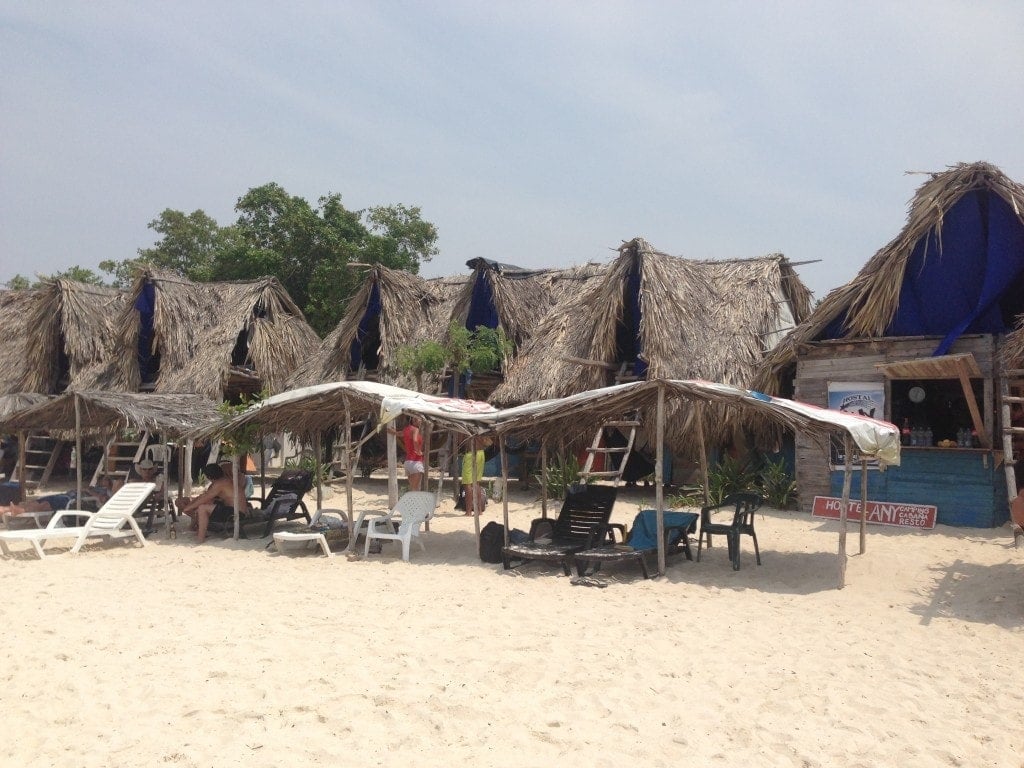
Once we’d dumped our bags, had a quick bit of lunch, and changed into swimwear, we set about enjoying one of the best beaches we’ve discovered so far. Hostel Any provides plastic loungers under palm frond shelters on the beach for shade, so we laid ourselves out in the warmth and got on with some good old fashioned relaxing. The beach is a truly gorgeous setting; warm, turquoise water that’s so clear you can see your toes on the sandy bed, clean, ice-white sand that stretches for miles in either direction, twisted and sun-bleached trees at the waters edge, and further back towering coconut and palm trees swaying in the gentle breeze.
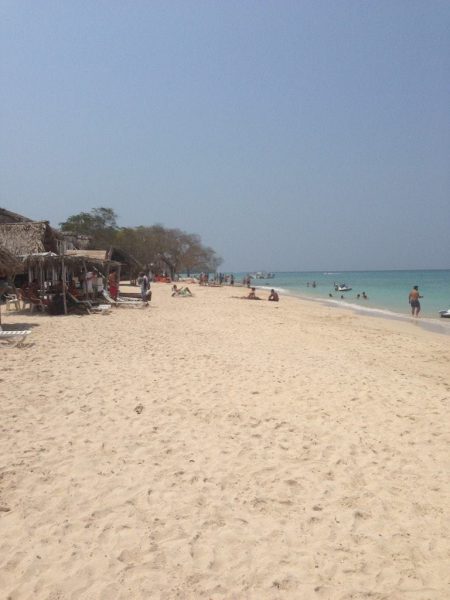
Further along the beach, where the tour boats and ferry come in, it’s really busy and more touristy – with so many locals trying to sell you souvenirs and massages that it’s difficult to finish a sentence without interrupting yourself with yet another ‘no, gracias’. But where the cargo boat dropped us off, the beach is much quieter – if you do arrive by ferry I recommend to walk left and keep walking until you reach Hostel Any, at least. There are a lot less salespeople down this end, the beach is wider, and it’s really empty, making it the perfect place to relax on the sand or in the gorgeous water.
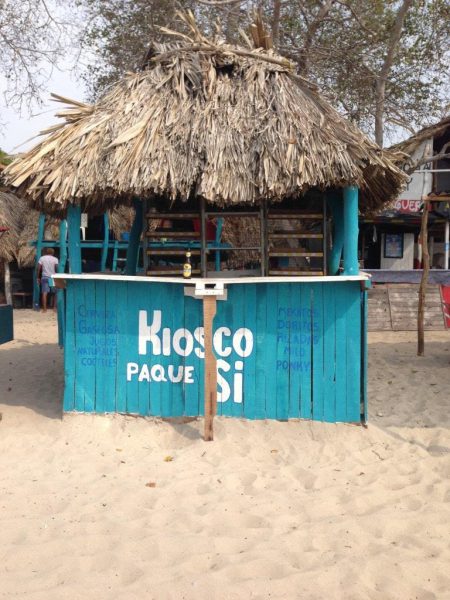
There is one local selling his wares in the beach who you absolutely should not turn away, though, and that’s the Coco Loco man.
He came trundling along the beach, in his straw hat and long sleeved sweater, pushing a wheelbarrow full of coconuts and singing out ‘coco loco piña colada coco locooooo…’, sunglasses at the end of his nose and a machete glinting in his belt.
Obviously, it was impossible to resist the idea of a freshly made piña colada on a perfect Caribean beach, so we ordered two.
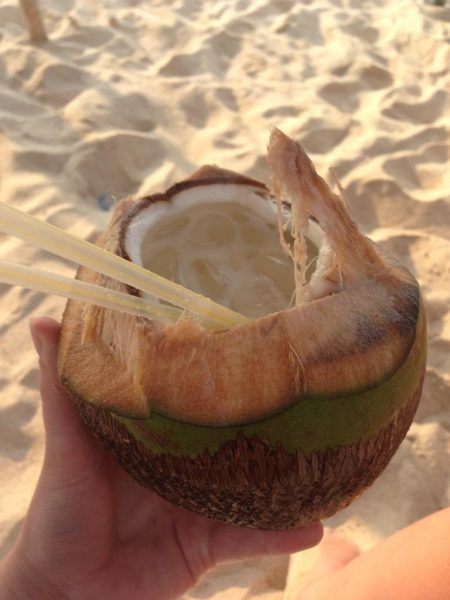
The coco loco man whipped out his machete, lopped the tops off two fresh coconuts, and filled them with a concoction of white rum and creamy liquor, before hacking a few chunks off a huge block of ice, again with the machete, assuring us “you gotta ice da coconut, amigo”.
After one sip, I was in heaven, but we obviously didn’t look impressed enough because Señor Coco Loco insisted on adding more rum – a lot more – to both our coconuts, pouring it from on high so it glistened in the air before hitting the creamy, now incredibly potent, cocktail. All that for just 10,000 COP (about £3)! We sipped our delicious cocktails on the beach as the sun began to set, turning the entire world – sky, sea, sand – a delicate peach and gold, then got back in the sea until the sun, a solid pink disk, slipped beneath the thin blue horizon.
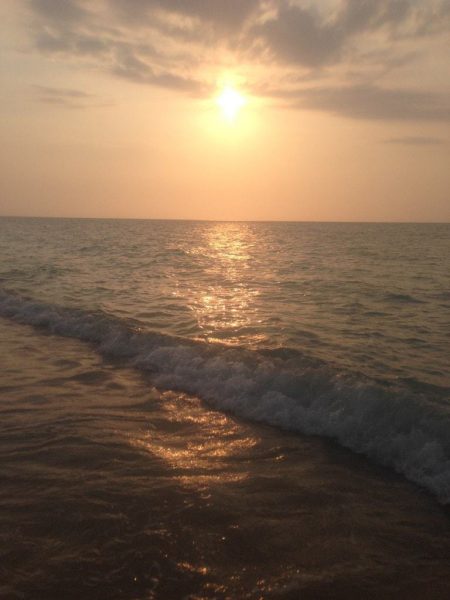
We ate dinner at a restaurant on the beach on a wonky table that was sinking into the sand. I had freshly caught red snapper with the usual carb heavy accompaniments of rice, potato, beans and fried bananas, which was gorgeous.
The tables were all lit by candles in jars, and the sky overhead was a tangle of stars, more stars than I’ve seen in my life, creating shimmering clouds of light in the sky. It was utterly stunning, so beautiful it seemed surreal: even looking back just three weeks later I can hardly believe that it was a genuine place, that it really was so perfect.
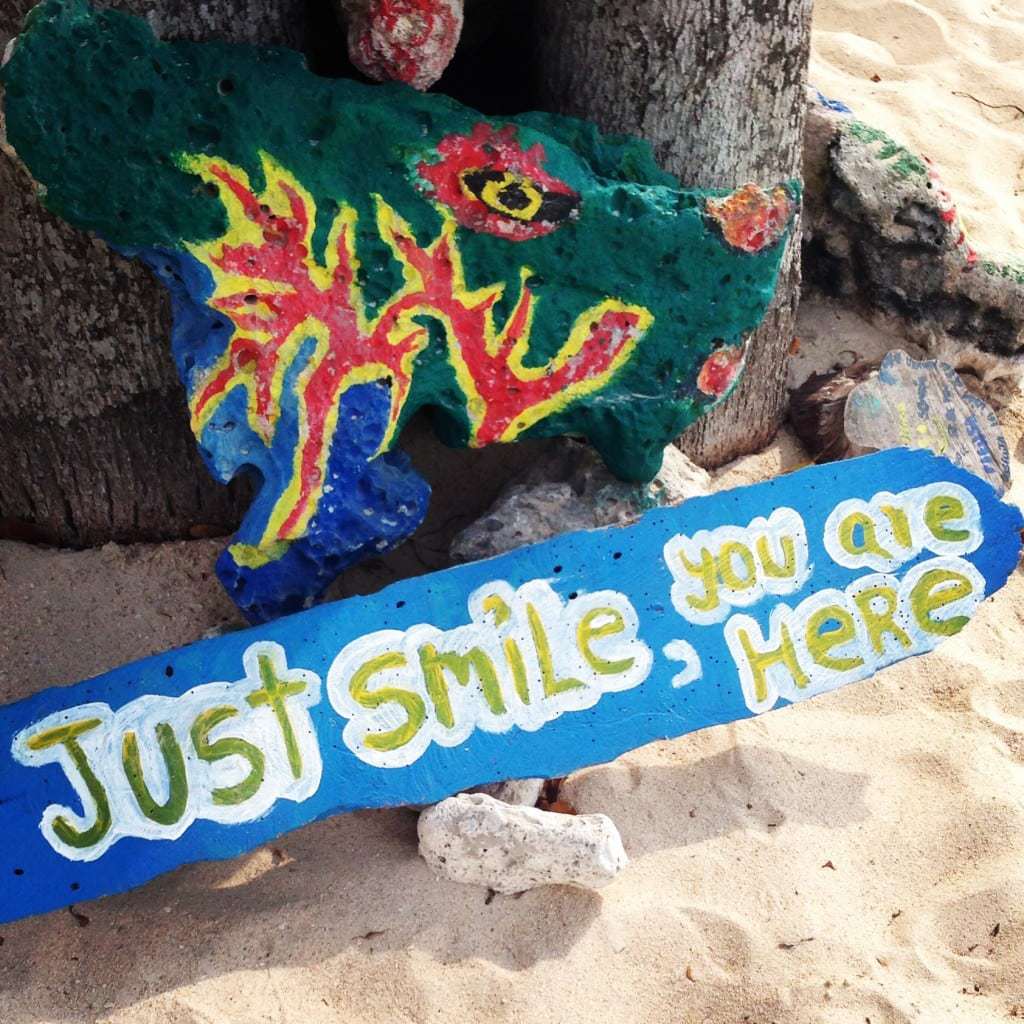
I woke up early the next morning and snoozed until about 9am, listening to the soft crashing of the waves and watching the light grow stronger and brighter through the cracks in our wooden hut, first soft grey, then blue, and finally a brilliant white light. We passed a second day there, until the ferry left at 3:30, swimming and lazing on sun loungers, trying to soak up every available drop of tranquility before we left.
It may have some fierce competition from the likes of Tayrona Park, but the beach at Playa Blanca is up there as one of the most beautiful we’ve found on our trip so far, and is well worth the expense and hassle of getting there.
Volcan de Lodo El Totumo in Cartagena
First Published: 31/03/2014
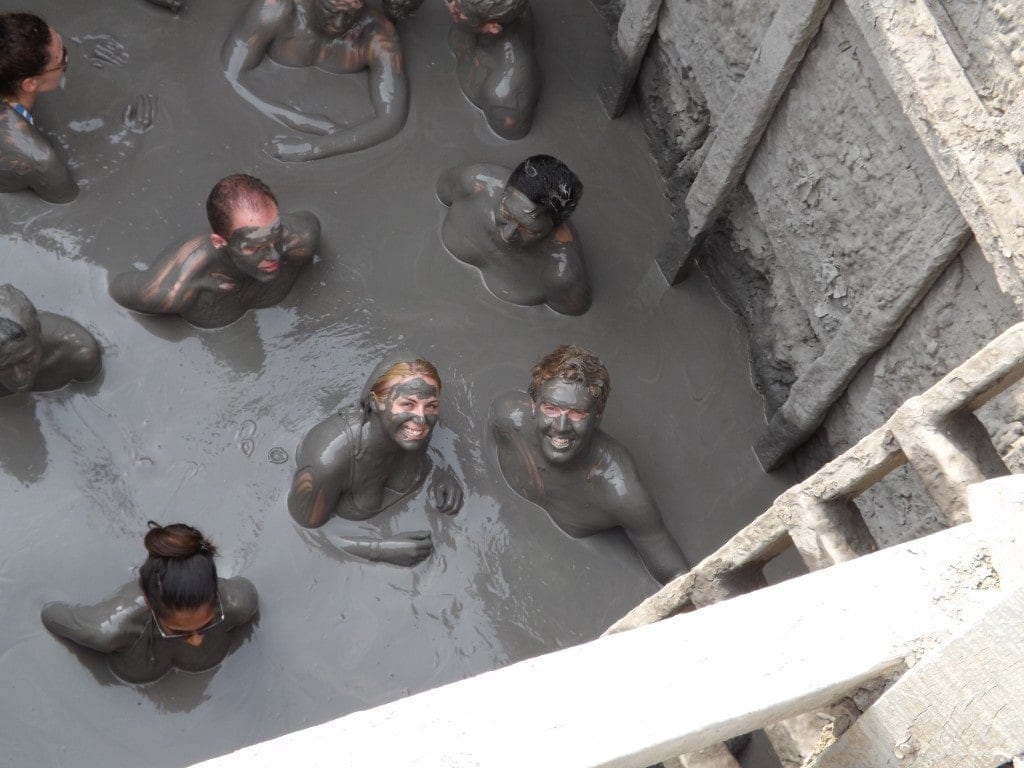
After our two days on Playa Blanca, we were back in colourful Cartagena and in no hurry to leave.
We spent the morning walking around the old town again, taking it more slowly this time and lingering over the details; pretty, flower-clad window boxes, beautiful store window displays, men pushing wooden carts laden with coconuts or sliced fruit, small plazas brimming with vibrant green leaves, groups of men sitting on the pavement or on benches quietly watching the world go by.
The old city walls, with their rusted canons and swaying palm trees, made me think of Pirates of the Caribbean, and the colour and vibrancy of Cartagena felt so removed from the Colombia we’d experienced so far, especially the inland Colombia of rich countryside and modern but bland cities. We swung by my favourite ice cream parlour – Gelateria Paradaiso – where I had the best dulce de leche ice cream I’ve ever tasted, but besides that one stop we didn’t go inside anywhere, preferring just to wander slowly in the baking heat and enjoy the city.
We passed endless groups of elderly tourists, mainly American, shuffling behind a tour guide wiping their foreheads and looking lost, complaining about the heat, shunting blindly from one historical building to the next and missing all the fascinating and beautiful details that make this city such a great place to explore and unwind.
That afternoon, we headed to the mud volcano Volcan de Lodo El Totumo outside Cartagena. Although I prefer to avoid tours, the general consensus online was that this was a trip you can’t undertake yourself unless you fancy a long and uncertain walk down a dirt path in the intense Columbian heat, so we asked the staff at who were able to book us on an afternoon tour with Ruta Ecologica (40,000 COP each).
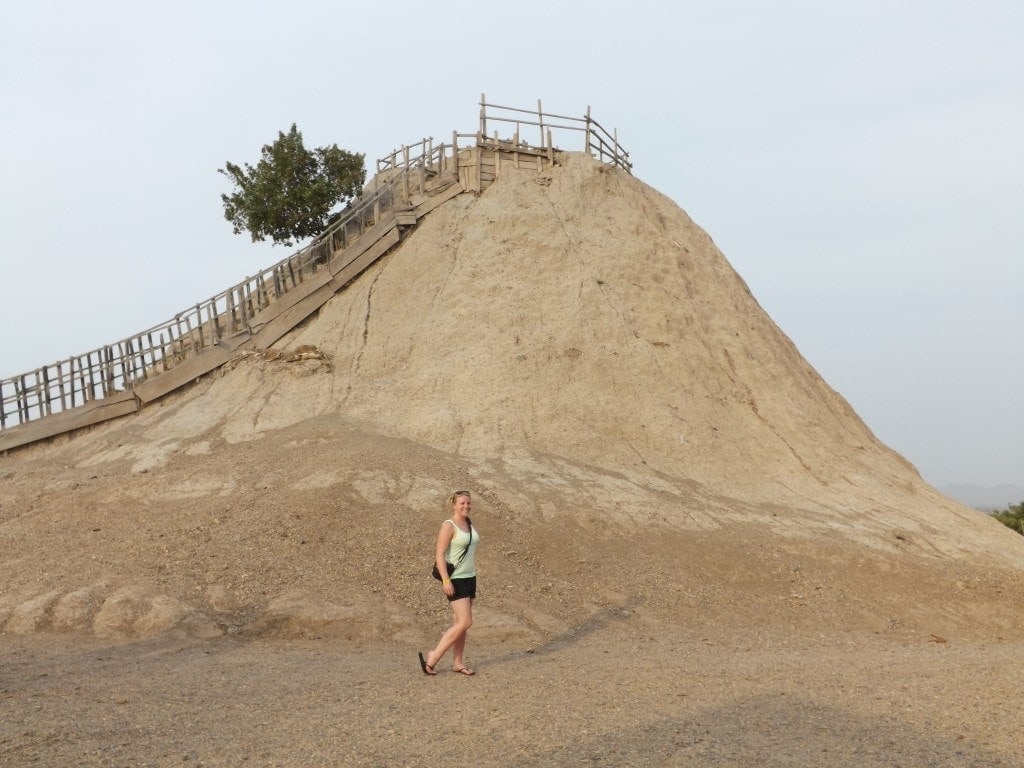
The tour company picked us up around one and, after almost an hour circling the city making pick ups at other hotels, we set off on the drive about an hour north-east of Cartagena on the road to Barranquilla. The tour company were really good, with an English speaking guide who let us know exactly what to expect at the volcano and how much to pay for each service.
On arrival, they had a private set of rooms with a small shop, toilets, showers and a changing area, plus lockers for our valuables. From what I’ve read, the public areas at the volcano lack most of these things, have no toilet roll in the toilets and certainly no lockers, so I was really grateful for having paid the extra for Ruta Ecologica! Once we’d all changed into our swim stuff, we headed up to the top of the volcano via the rickety wooden staircase which was caked in dried grey mud. The mound itself – which according to legend was once a real volcano until a priest banished the devil from it – is about fifty foot high and a steep climb to the top. I felt a bit exposed in my bikini on the side of this beige-brown anthill shaped mound of mud in the middle of nowhere, but fortunately the climb didn’t take too long so I didn’t have to suck in my tummy for long!
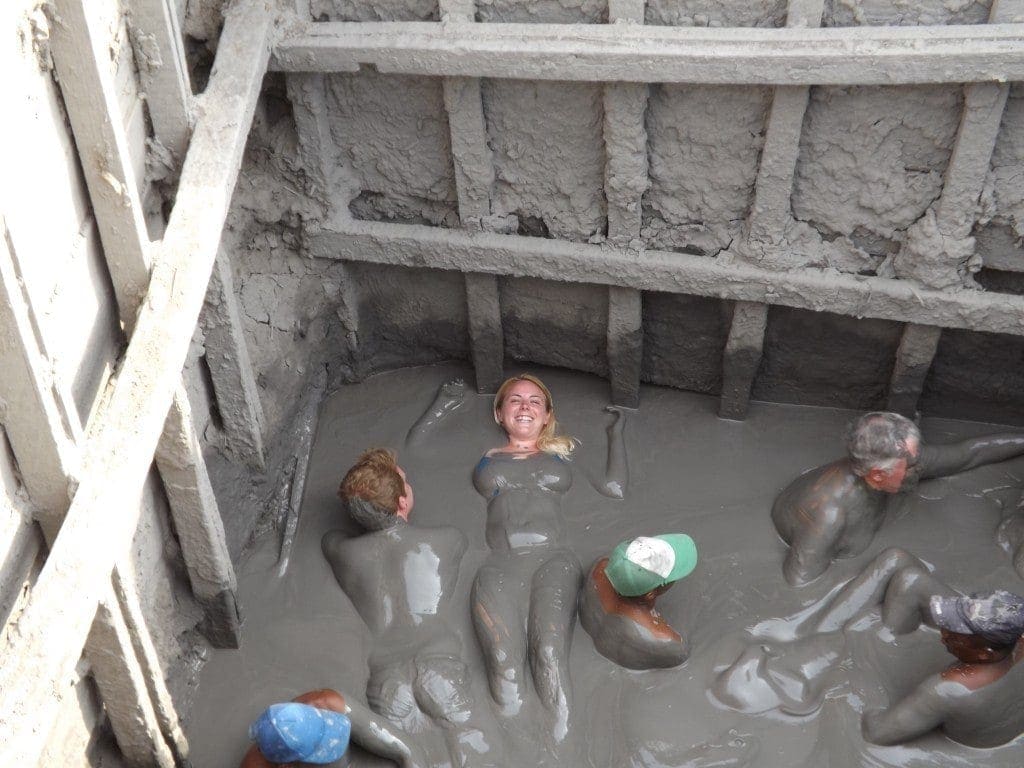
With such a large group and only one ladder, getting into the actual mud was a bit of a problem. The pit is low, maybe ten foot down from the top of the volcano, and accessible by a slippery ladder. According to our tour guide, the mud is about 2000 foot deep, but it’s so thick and dense that it’s impossible to sink. Each person descending the ladder had to be helped in and dragged across the pool by an attendant because it’s so difficult to gain control of your body once you’re half submerged, which really slowed the process down. Eventually, it was my turn, and once I was waist deep in thick, smooth and surprisingly warm molten clay I was just about stuck. I tried to step further down the ladder but my legs had other ideas, trying to float up behind me to the surface. And attendant helped me lean back until I was lying on my back, then, steering me by the ankles, slid me across the pool and slotted me into a line of bodies waiting for massages.
The massage service cost 3,000 COP and was really relaxing – although it’s very unnerving lying on your back on a substance that feels a lot like liquid but which you can’t sink into. We noticed – to the annoyance of some of the gents on our tour – that the younger girls, including me, got much longer massages from the male attendants, but I wasn’t complaining! It felt really good – especially on my legs, sore from so much walking – and the thick layer of slimy mud (imagine a texture halfway between custard and treacle) was a great substitute for oil. It has, according to the guide, hundreds of beneficial vitamins and oils which are meant to be great for your skin, so a massage in the mud should do wonders. I definitely felt noticeably softer afterwards, especially on my arms, but unfortunately it didn’t heal my sunburn.
When the massage was over, I was pushed out across the pool to join the rest of the group, and with no control over my body I basically slid feet first into the nearest body. I tried to right myself, but absolutely couldn’t; with nothing to push my back or arms against and no gravity, I simply could not get my legs underneath me until Sam, already upright, dragged me forwards. Even with help, it was a comically difficult process; my body going first too far forwards so that my legs floated up behind me, then too far backwards so that they floated up in front again. The feeling of having no control over your legs is a bizarre one, and we couldn’t stop giggling as, even once upright, we had to fight to stay that way.
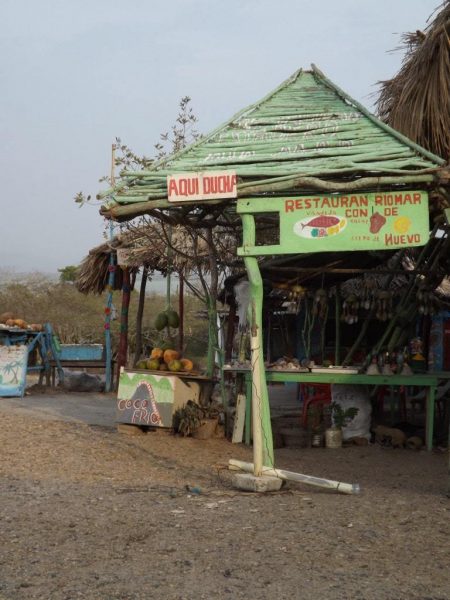
We stayed in the mud for as long as possible, posing for photos (one of the attendants took control of our camera for 3,000 COP) and mucking about trying to sink each other. It really is impossible: even holding your arms beneath the surface takes a conscious effort, and no matter how hard we pushed we couldn’t get each other below the surface. The density of the mud is incredible!
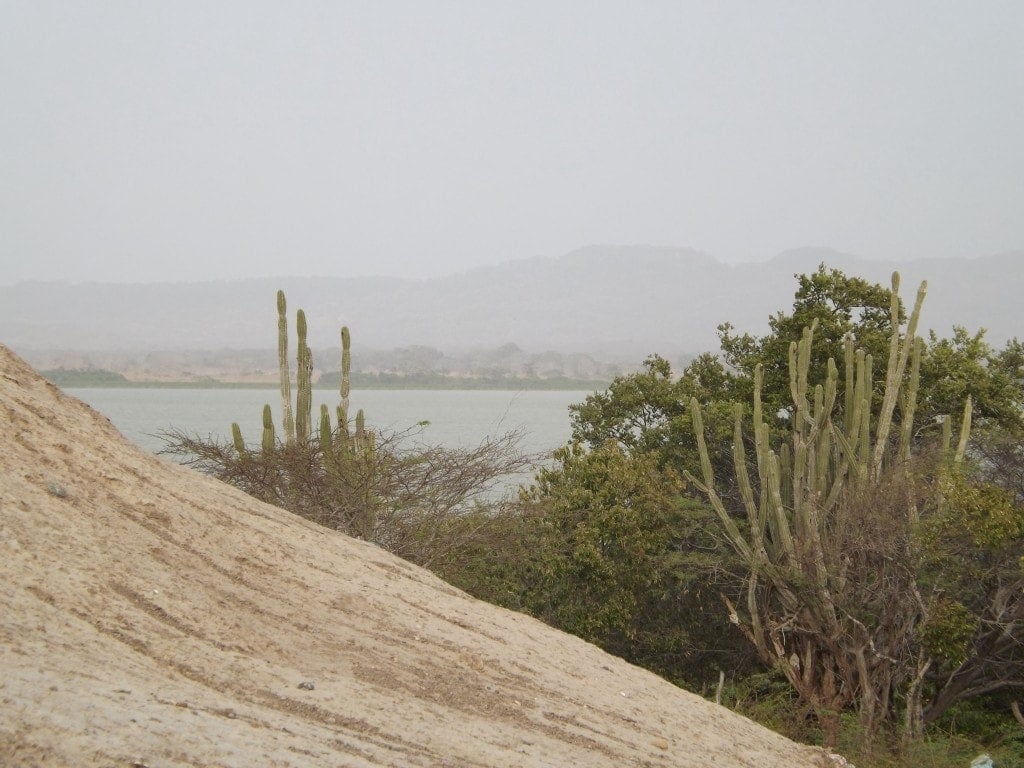
Eventually, it was time to get out and make the arduous journey back down the steps and down to the lake, waking barefoot across gravel. Coated in smooth, grey slime that was starting to dry and harden in wrinkly, cracked patches, we all looked ridiculous, especially walking in such a disjointed, clumsy way because of the mud. I was walking slowly and chatting to one of the girls in our group, so once I reached the shore most people were already in the lagoon, clean and human again. One of the female attendants strode out of the lake, wearing an angry scowl, and grabbed myself and my fellow late-comer by the hand, leading us crossly into the lake. Handing my friend to another attendant, she sat me down in the shallow, warm water and began washing me vigorously and a little crossly, tutting and sighing as she did so. I felt a lot like a little girl in trouble for getting muddy! The woman washed me with unparalleled efficiency, getting into my ears, nostrils, hair and all over my body, even stripping me naked (we were all facing away from each other and completely underwater, so it wasn’t too embarrassing) to wash out my bikini. It was the most thorough bath I’ve had in my life and I could hardly stop giggling all the way through at how angry the woman seemed at having to wash me. It cost another 3,000 COP for the washing, and it’s all part of the fun of the whole experience, plus I guarantee you won’t get as good a clean using the showers.
All cleaned up and back to my normal, white self again – although with much smoother skin – we dried off and changed, and by the time we boarded the bus we were a group of humans again, instead of the slimy mud monsters we’d been as we crawled slipping and sliding down the side of the volcano.
It was a fantastic, hilarious and very fun experience, fitting in with our experience of Colombia in general; strange, sometimes surreal and very, very fun!
Arriving in Salento
First Published: 03/04/2014
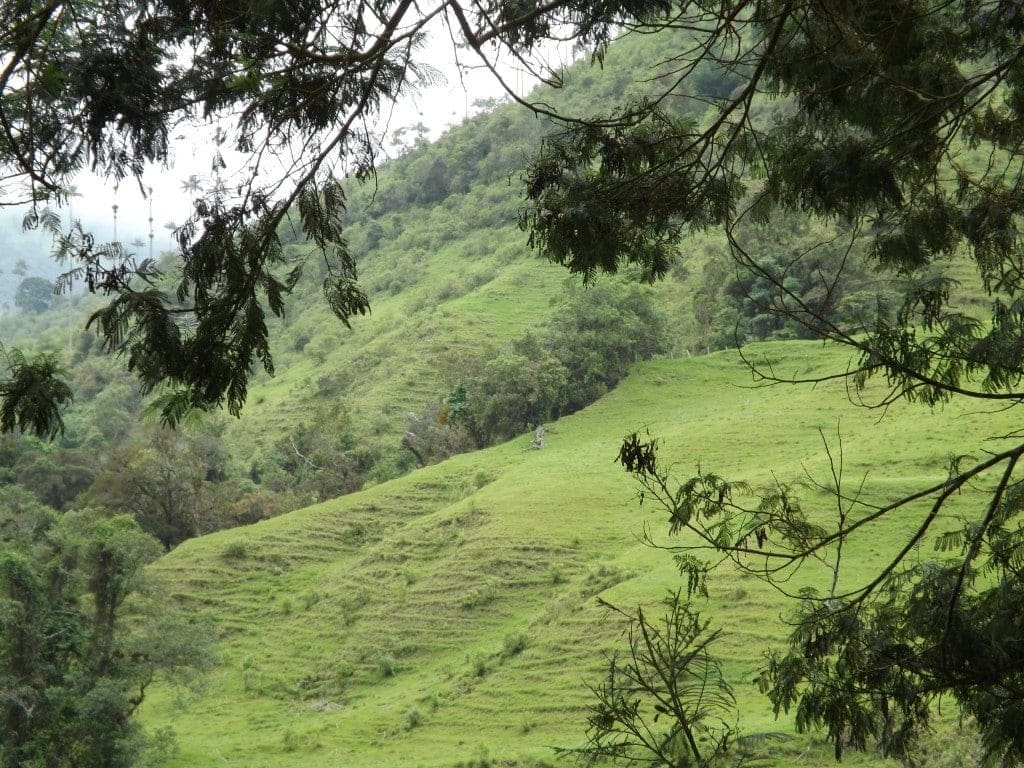
After two disappointing days in Medellin, Sam and I had had enough of cities and were ready to head into more of Colombia’s gorgeous countryside.
We’ve discovered on this trip that it’s impossible to escape good advice when you’re travelling in hostels and meeting other travellers just like yourself – so when an American guy named Stephan told us that Salento had the most beautiful landscapes he’d ever seen, it was easy to decide on that as the next stop.
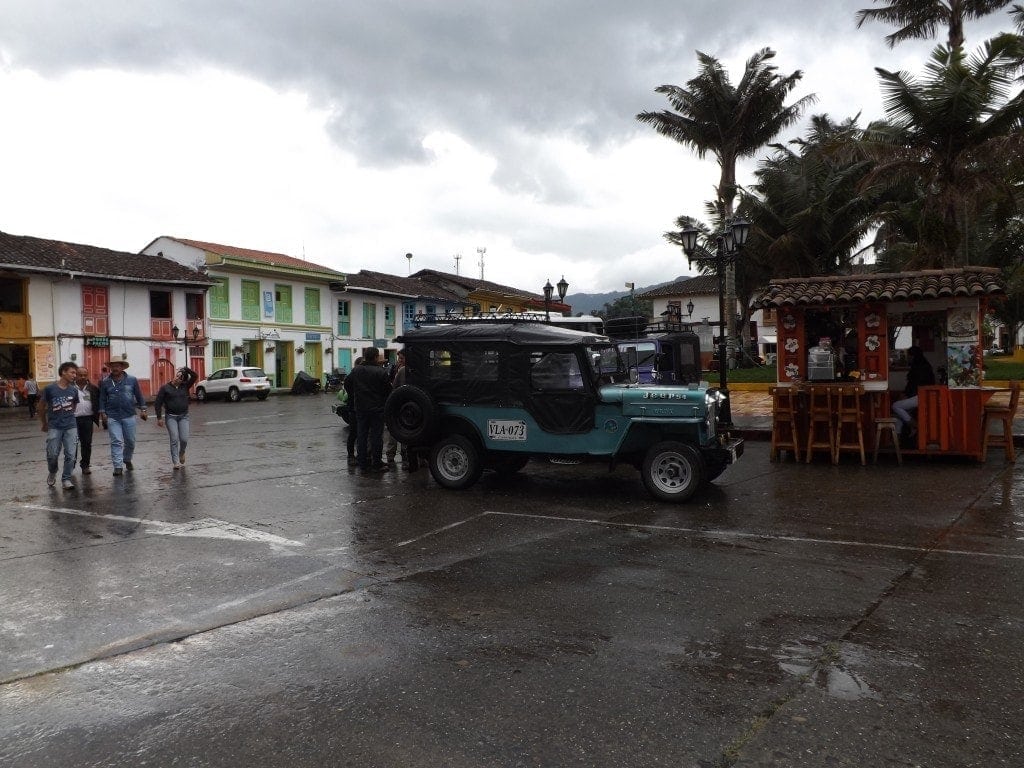
The bus ride quickly plunged us out of the grey, modern dullness of Medellin and into a sweeping landscape of smooth green mountains, surging rivers, sprawling farms and plantations, and low, smoky clouds which crept down the edges of hills as though trying to swallow up the world. The views, constantly changing and ceaselessly beautiful, made the six or seven hour journey go fairly quickly, and soon enough we found ourselves sitting at the side of an empty motorway – three lanes either side – waiting for the colectivo to Salento. When it arrived, we were packed into a rickety mini bus already stuffed with passengers, our big backpacks crammed in wherever they would fit, and Sam tucked in at the back between two schoolgirls who found his presence there somewhat hilarious. They giggled at him for twenty minutes or so as we bounced our way to Salento, a small, hilly town of steep slopes and one storey buildings, until we jumped out at the plaza and found ourselves a jeep to get the rest of the way.
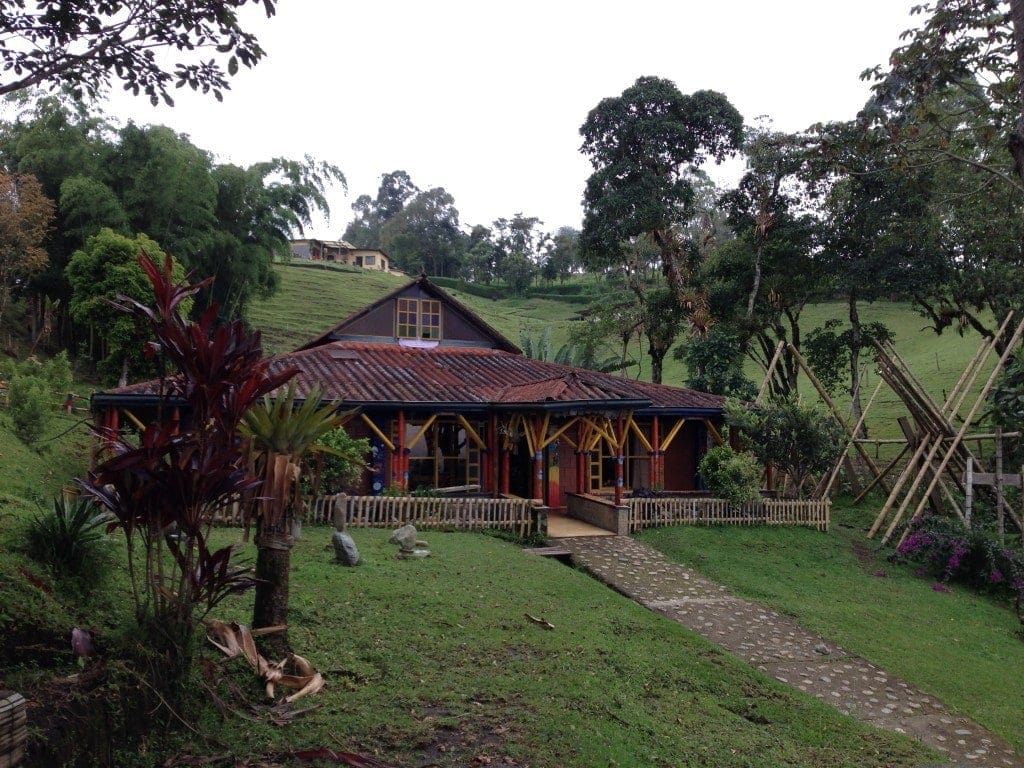
Yambolombia, the hostel we’d booked online the day before, was about a twenty-minute walk outside of town – and heavy rains recently had turned the dirt road into a deep, muddy bog, so that even the jeep struggled to get through it.
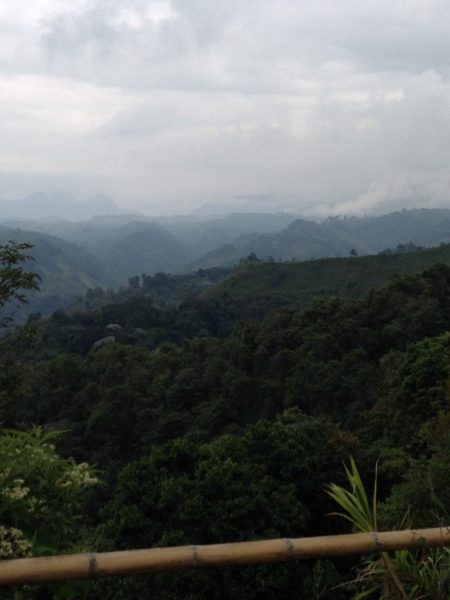
Eventually, though, we made it to a beautiful wooden building perched at the bottom of a small hill, surrounded by nothing but greenery and tall, silent trees. I was in love before we’d even made it through the front gate, and on exploring the hostel it only got better: a converted farmhouse, Yambolombia is a vegetarian eco hostel with amazing food, tons of funky artwork decorating every surface, and incredible views across the surrounding valleys (on a clear day I caught a glimpse of the snow capped peaks in the distance).
It’s pretty small, so there are never too many guests at once, making it really intimate and friendly -perfect for meeting a small group of nice, like-minded people. The owner, Gabriel, described himself as a hippy – but a social one, “not anti-social” – and is one of the most welcoming, friendly and relaxed hosts I’ve come across, plus the staff – especially the warm and lovely Amy – made the environment fantastic.
We spent the evening at the hostel, eating Gabriel’s incredible vegetarian food (in South America any break from the meat-heavy diet is welcome) and chatting with the other guests, playing a game of werewolf which was led by two French guys whose accents made the narration absolutely hilarious and much more atmospheric – “ze werewolves wake up, and zey design someone to kill…”
We spent the evening at the hostel, eating Gabriel’s incredible vegetarian food (in South America any break from the meat-heavy diet is welcome) and chatting with the other guests, playing a game of werewolf which was led by two French guys whose accents made the narration absolutely hilarious and much more atmospheric – “ze werewolves wake up, and zey design someone to kill…”
It was a fantastic evening in one of the most peaceful and pretty places we’ve come across so far, and we both fell asleep eager for the following day and completely in love with Yambolombia, Salento, and Colombia in general.
Hiking the Valle de Cocora in Salento
First Published: 5/4/2014
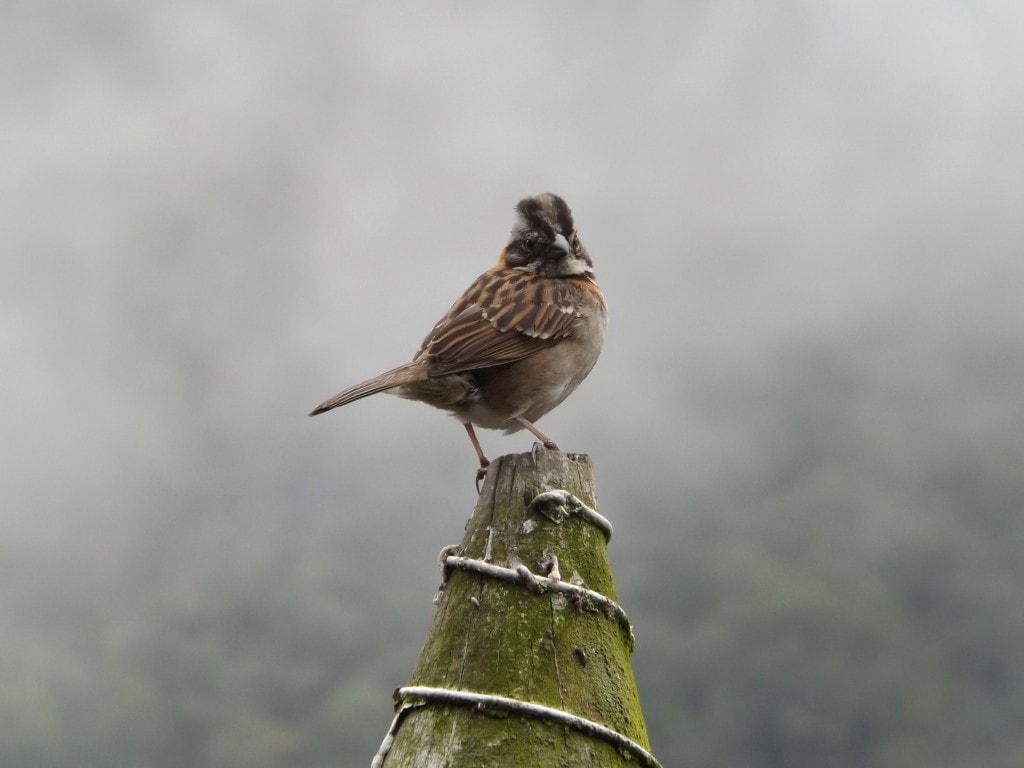
The penultimate chapter of our Colombian adventure was such a contrast to the cities, beaches, colour and vibrancy that we’d experienced so far that it was like being in an entirely different country.
In fact, with it’s cloudy, rainy weather, cool air, greenery and farmyards, Salento did seem slightly more like European countryside than a part of South America – if it wasn’t for the lush coffee plantations, towering mountains, palm trees and multiple waterfalls, that is!
Salento was my favourite part of Colombia – or one of them – and I’ve been putting off writing about it out of fear that I might not do the place justice.
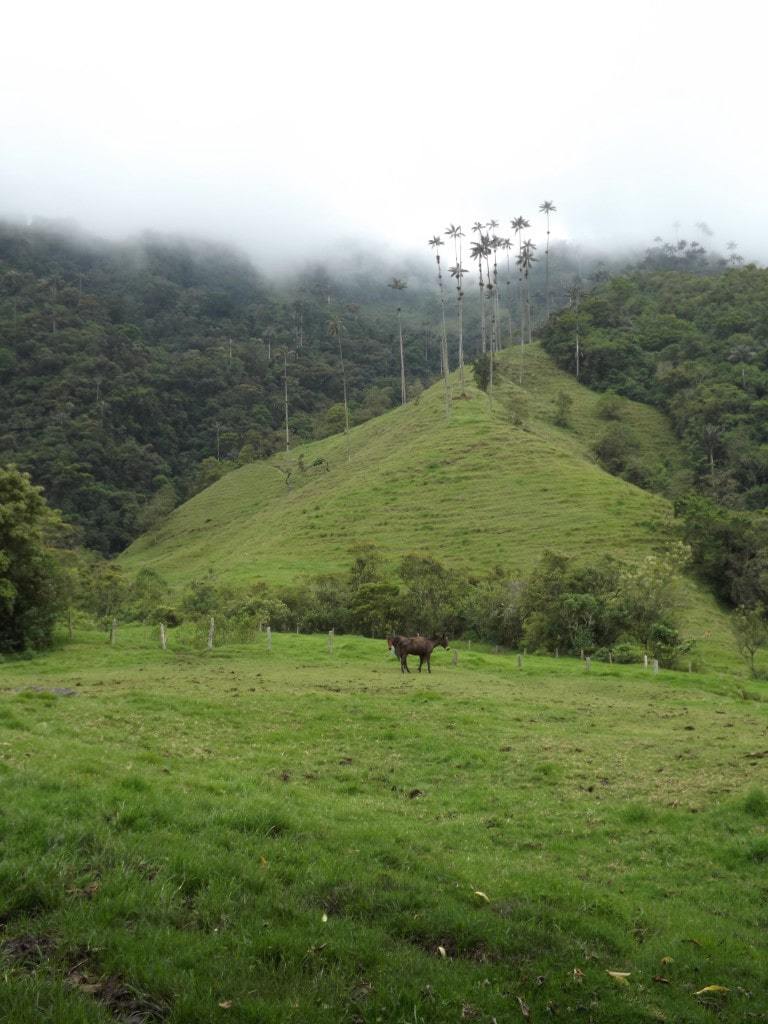
Valle de Cocora Hike in Salento
Our second day, after a fantastic first evening at Yambolombia hostel, took us into the Valle de Cocora for a five-hour hike through some of the most dramatic and beautiful landscapes I’ve ever seen. There’s a reason this is one of the best things to do in Colombia.
After a ridiculously filling, but delicious, breakfast (Gabriel seems very intent on fattening his guests up) we donned our hiking boots and headed up the road to Salento’s main plaza, where we hopped into a jeep headed for the valley. Actually, we didn’t exactly hop in since all the jeeps were full: we had to stand on the back plate of the jeep and hold onto the bar as we sped along winding roads through a valley lined with thickly forested cliffs, glimpsing two thundering waterfalls amongst the trees – feeling the thrill of adventure and the wind in my hair as we sped along.
Starting the Hike
We reached the main entrance to the Valle de Cocora, a national park, and started the hike along with Nathan – one of the French guys from Yambolombia – and Sandra, a retired maths teacher from New York. Nathan – a well practised hiker who had earlier mentioned that the five day Lost City trek had been too tame for him – quickly left us behind, while Sandra, who was going it slow and seemed happy to make her own way, soon fell behind, leaving the two of us to hike alone.
There are loads of routes through the valley, but we’d chosen one of the shortest because Salento was due yet more heavy rain that afternoon, and we didn’t want to be caught out in it for too long. The circuit took us through farmland, first of all, along an easy dirt path that just barely sloped upwards, past fields of cows and flat empty plains studded with occasional spindly palm trees. All around us were tall, silent hills laced with smoky clouds, and with the overcast sky it was beginning to feel that the only colour left in the world was green.
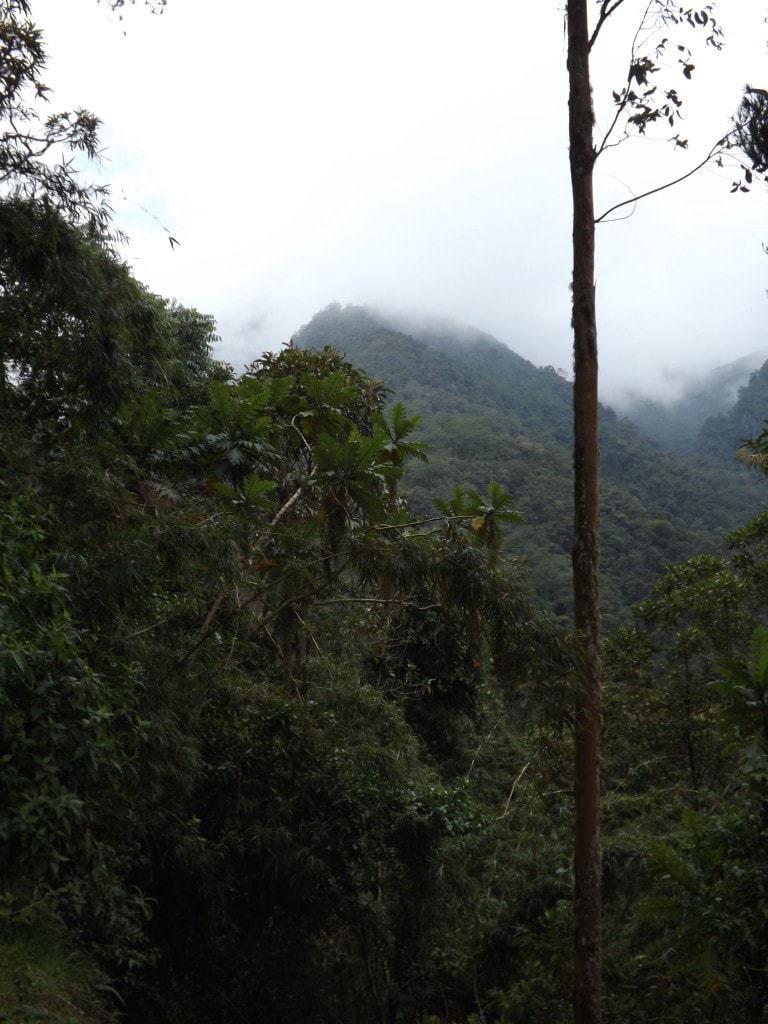
Indiana Jones Bridges
Within less than an hour, we had reached the forest and begun following a small, rushing river along a rocky path. The trees grew thickly all around and in many places bent over the river so fully that we were almost in darkness, but every now and then the sun – finally out from behind the heavy clouds – broke through and caught the river in a beautiful, golden light, making the place seem almost magical. The path was winding, and frequently crossed over the river on long, thin bridges made from wooden slats and thick copper ropes, which bounced as we walked across them and only supported one person at a time. Obviously, you can’t cross a bridge like that without humming the Indiana Jones theme!
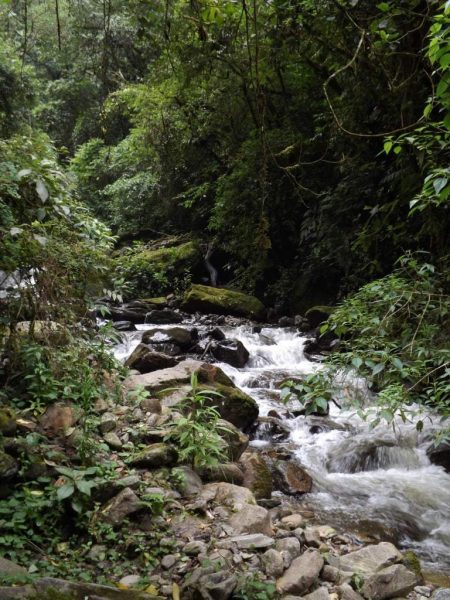
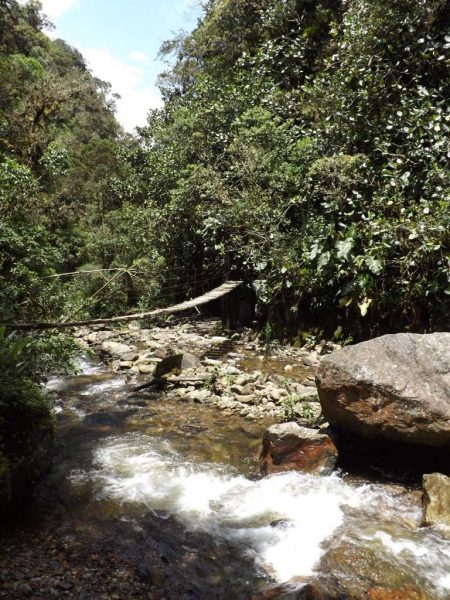
Acaime Hummingbird Point Salento
From the forest, we veered off the main path and took a detour to Acaime, also known as hummingbird point. This was at the top of a pretty steep hill, but was worth the extra walk and the 4,000 COP entrance fee (which included a drink) because it’s the best place to see the huge numbers of hummingbirds which live in the Valle de Cocora.
There are at least six species which make a home there, and we caught a glimpse of all of them at Acaime, a lovely, rustic coffee shop – where we dried the delicious, super-sweet hot drink Aguardiente – thanks to the feeding stations they have hanging around the building.
The birds hovered and darted, making the most incredible, unexpected vibrating noise with their wings and moving much faster than I could move my camera, seeming to move almost in stop motion; sometimes one would move so quickly from one point to another that I couldn’t be sure it was the same bird I was looking at. I was so close, I could see their tongues dart in and out of their long, pointed beaks as they slurped up their drink. It was incredible!
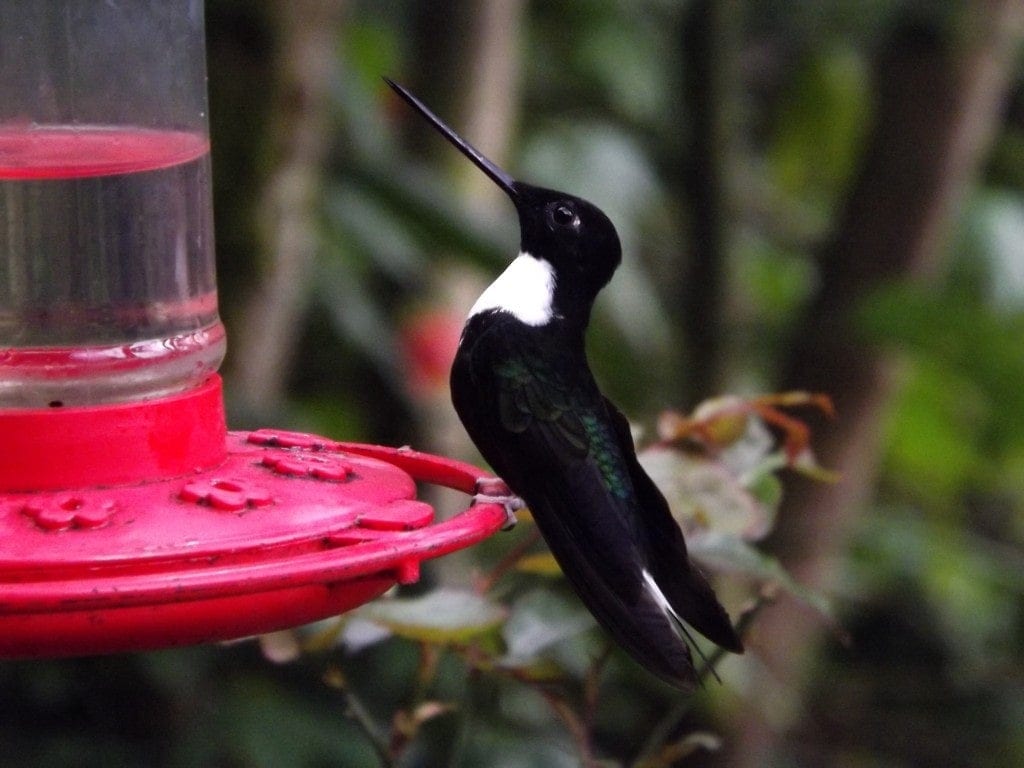
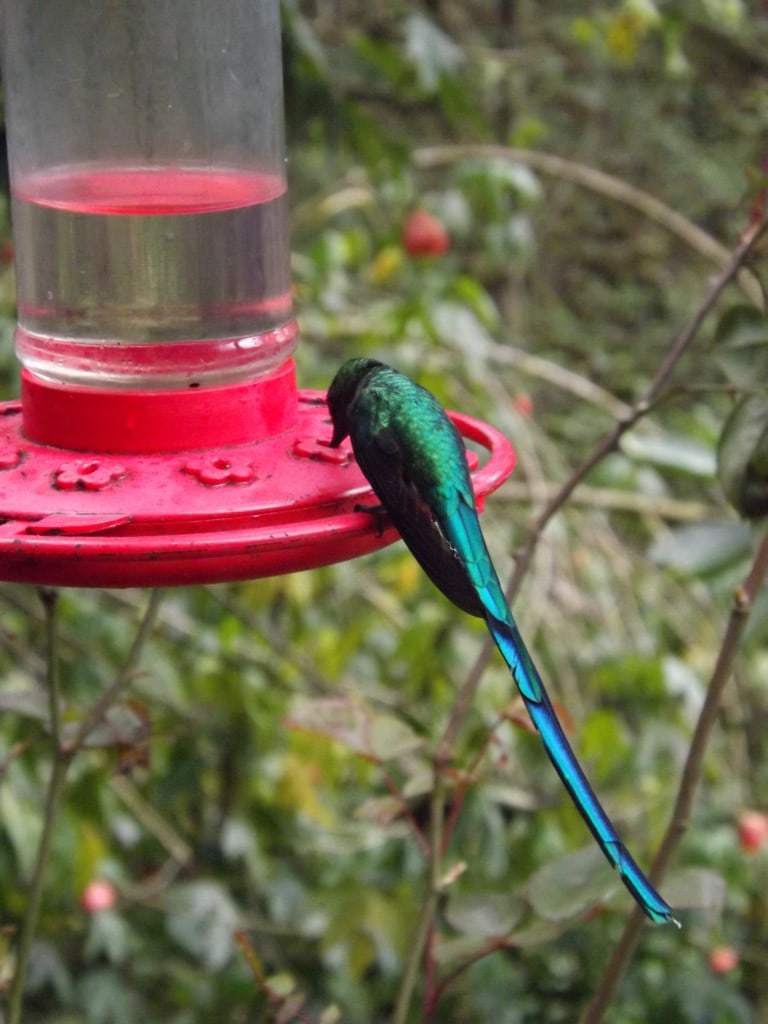
Hitting the Peaks
After Acaime, the walk became more difficult as we headed out of the valley and upwards, climbing an increasingly steep path as it zig-zagged along the side of a mountain. My legs, stronger now than theywere at the start of our trip but still unfit, protested at every step, and we took frequent stops to catch our breath as we moved out of the forest and up into the damp air of clouds.
Reaching the top, where we discovered a beautiful farmhouse that seemed to be wrapped in colourful flowers, I felt so relieved (and so proud) that I could have sunk to my knees – but I didn’t want to miss the view! Now that we were out of the forest, and at 2860m above sea level, we found ourselves at eye level with thick, white clouds as they moved between the mountains around us, blocking the view of the thickly forested, emerald green slopes opposite.
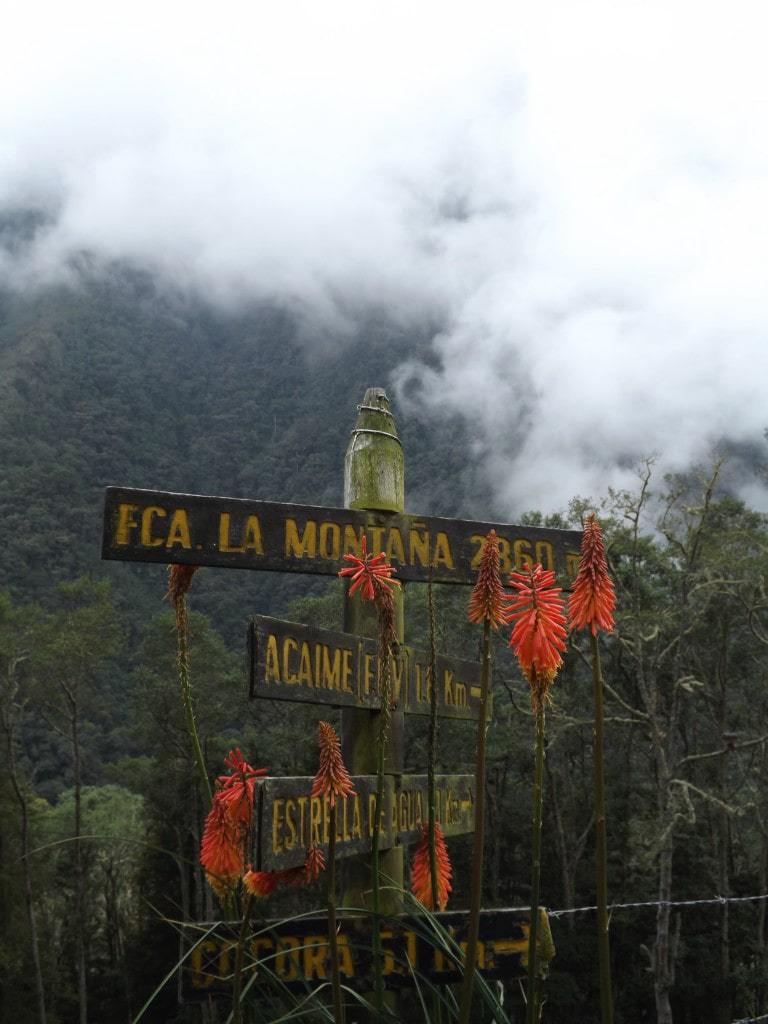
Cows and Palm Trees
The last section of the walk was all downhill, following a wide path with a sharp cliff on one side and a wide, sloping valley on the other. We were walking with a group, now; Sandra the maths teacher, British couple Henry and Zara, and a French woman who barely spoke and whose name I never caught.
The fields we passed were vividly green and home to moody cows alongside towering palm trees, which is a strange contrast; as Henry said, it was like someone had transported the British countryside to the Caribbean. For the last hour or so of the walk, we were caught in heavy rain – the tropical kind with fat, battering drops that soak everything but still feel warm – and surrounded by clouds which by now had descended so low into the valley that they skirted the ground in places, but although it was uncomfortable the surreal and beautiful landscape was well worth it.
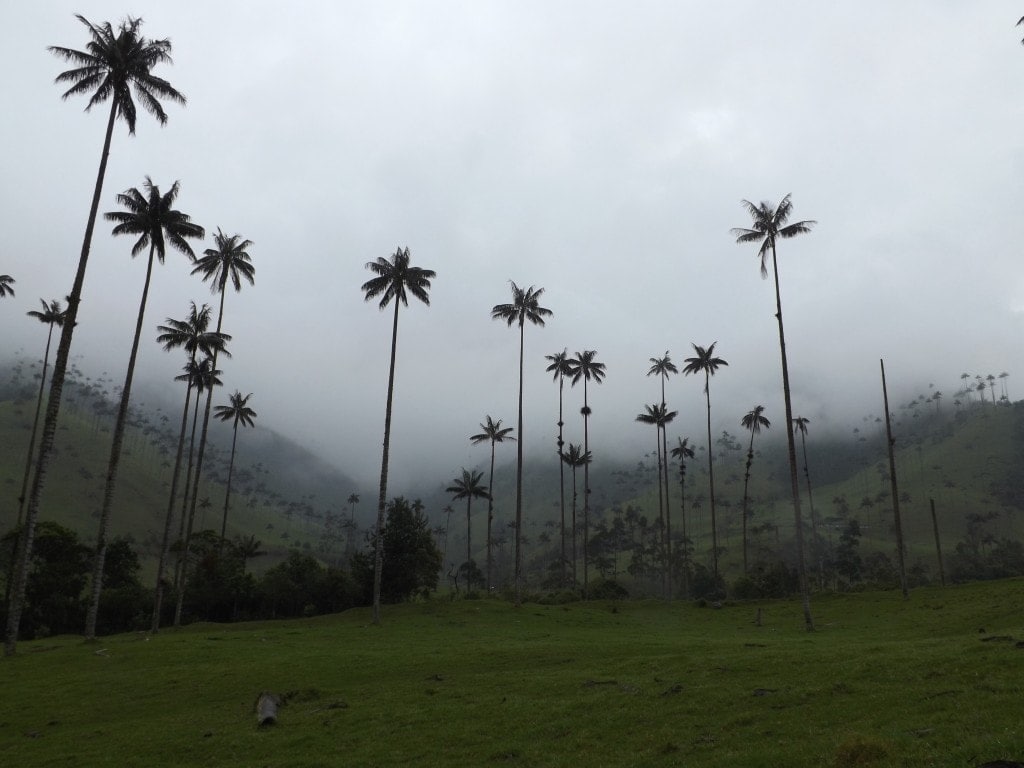
Finally, wet through and exhausted, we made it back to the entrance of the park and hopped into jeeps back to Salento, where we whiled away a very enjoyable evening with our new friends, a lot of drinks, and many variations of Salento’s best dish – fresh trout.
Horserides and Waterfalls in Salento
First Published: 6/4/2014
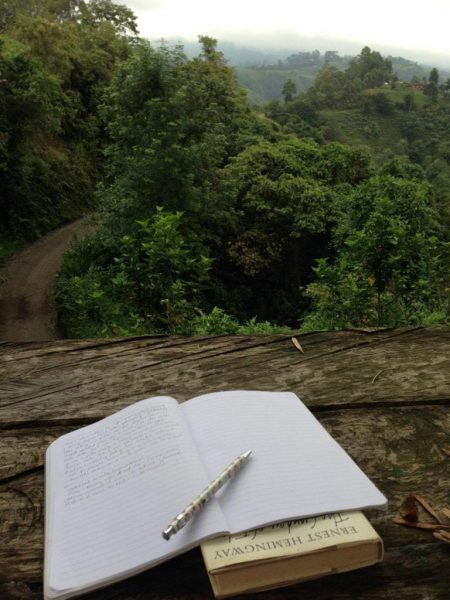
I spent the morning of our second full day in Salento, a small Andean town in southern Colombia, writing and catching up on my diary.
My writing desk was a big wooden bench, damp with mist, at the end of the front garden, which looked out across the valley that falls away in front of Yambolombia, our hostel in Salento.
The landscape, thick emerald forest and green slopes with purple-blue mountains in the distance, was covered by low clouds that crept like smoke over everything.
Shrouded in mist, the world was silent; nothing but the sounds of birds, a slight breeze, the barely moving trees, and insects. The conditions were perfect for writing, and I found myself wishing I could stay in this place forever, with nothing to distract me from my work but the landscape, a daily walk, a pet dog. I understood why Amy, an Australian girl who’d been working at Yambolombia for a year or so, said she was unable to leave even to visit home. It’s the kind of place that draws you in.
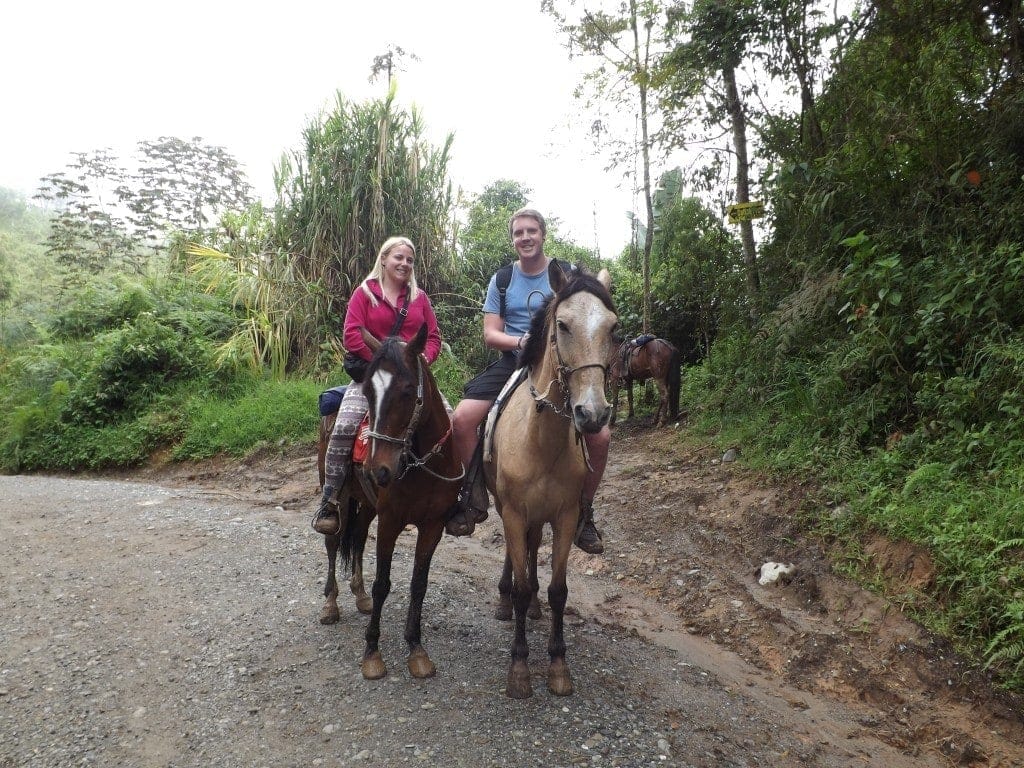
After a slow morning quietly working, we headed out for a horse ride with a local guide. I’ve been before a few times when I was younger and enjoyed it, but Sam had never been on a horse before. Our guide, a guy called Oscar who wore double denim and a coloured poncho and looked just like a cowboy, turned up with three horses and helped us hop up. Sam was on a taller, beige-yellow horse named Mantequilla (Butter), while I got lumped with Principe (Prince), an aggressive, strong-minded horse with a hatred of walking anywhere but first place. He never obeyed me and constantly tried to overtake, often squeezing past Mantequilla on cliff edges or in very narrow pathways, making sure I got slapped in the face by low branches or wet leaves as much as possible.
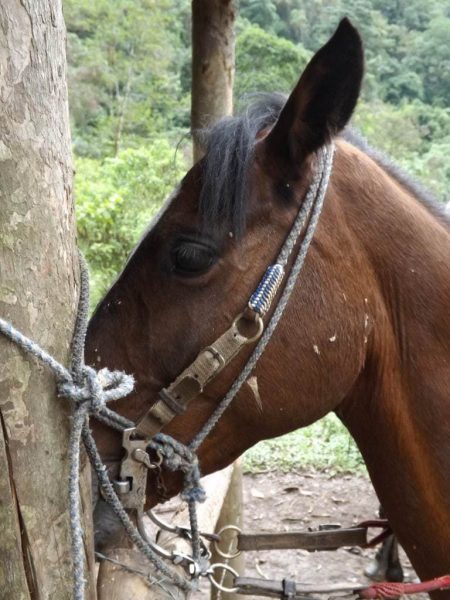
We set off at a gentle pace, but quite quickly both horses were ignoring our instructions on the reigns and had broken into trots which they kept up for most of the journey. Oscar led from behind, on his well behaved horse, probably laughing inwardly at our incompetence. Although he spoke no English and my Spanish is pretty rubbish, he was really friendly and we managed to have a bit of a conversation. He clearly loves his home town and its gorgeous surroundings; as we headed down the winding mountain road leading to the River Quindío he pointed out birds (telling us the Spanish names, which of course I instantly forgot), the river glinting white below us, and the view in general, smiling approvingly every time I gushed “que lindo, que bonito”.
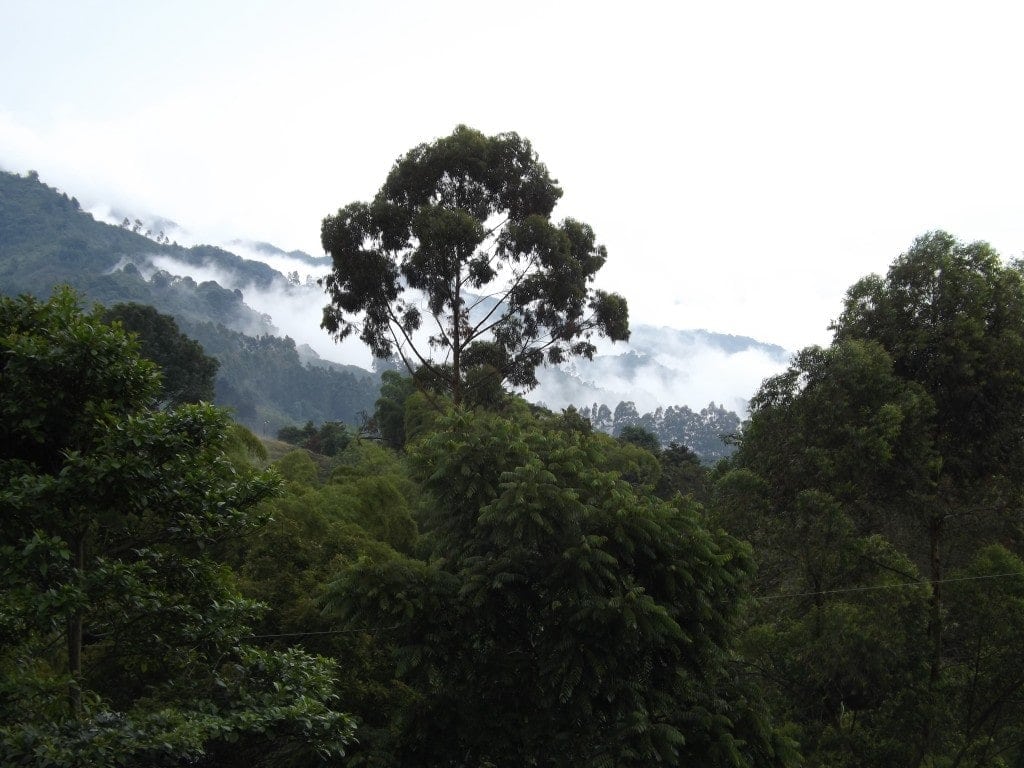
Halfway down the mountain, Oscar pointed at a bush next to the road and said “aqui”. We looked at the bush, then looked at him quizzically, and Oscar said some more things in Spanish, then pointed again and insisted “aqui aqui”. Sam’s horse seemed to know better than we did, and plunged into a small gap between the bushes with Principe right at his heels, and we found ourselves on a very steep, very wet and very rocky mountain path which the horses basically slid down with us on their backs, gripping the reigns for dear life and leaning back to avoid falling straight over their heads.
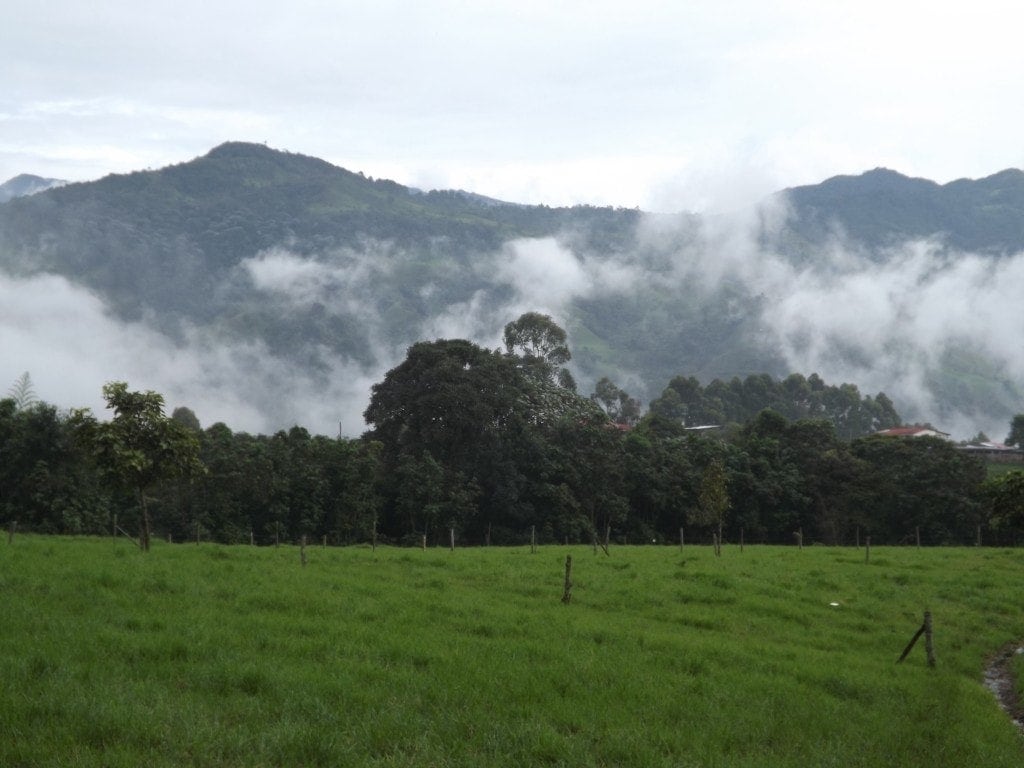
With that slightly nerve-racking off road experience behind us, I hoped the rest of the way would be fairly simply, and once we were in the valley making our way along the river I thought I might be right. But, it wasn’t long before we reached a large bend in the river which curled to block our path, and Oscar pointed straight at the water, gesturing that we should cross. Before I had time to say “but there’s no bridge”, Principe had plunged into the river and was waist deep, splashing the rushing water with his legs so that it sprayed right up my back and even into my hair. The “off-roading” continued with several more river crossings, in spite of the strong current and deep water caused by the heavy rains, but although it was a bit of a shock at first it made the horse riding experience really fun and we were having a great time (even if we were damp and slightly uncomfortable).
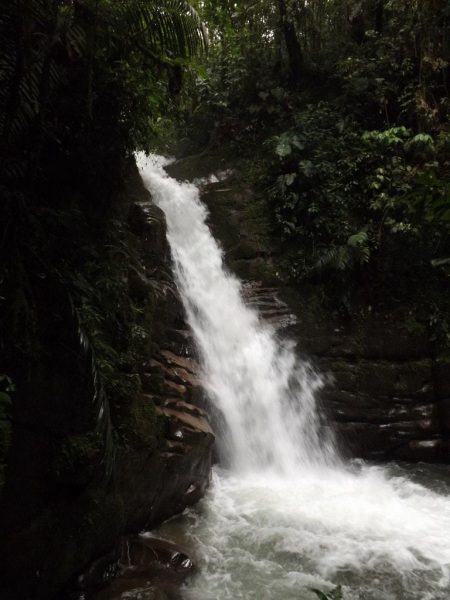
Eventually, we made it to a point where the river entered a forest, and dismounted our not-so-trusty steeds. We entered the forest on foot, finding ourselves plunged in darkness thanks to the thick foliage, and walked a short distance down a path and across a wooden bridge just like the ones from the Valle de Cocora. The smell of wet leaves and damp mud filled the air, rich and earthy. In a small clearing, surrounded by shiny wet rocks and trees coated in dark green moss,we came upon Quindío’s waterfall; a white, gushing shoot of water which seemed to fling itself off the cliff edge about 45ft up and come tumbling down to a shallow pool of crystal clear water. Apparently, you can swim there, but the day was much too cold for that, especially in the darkness of the forest clearing, so we remained fully clothed and instead enjoyed the waterfall from a safe and dry distance.
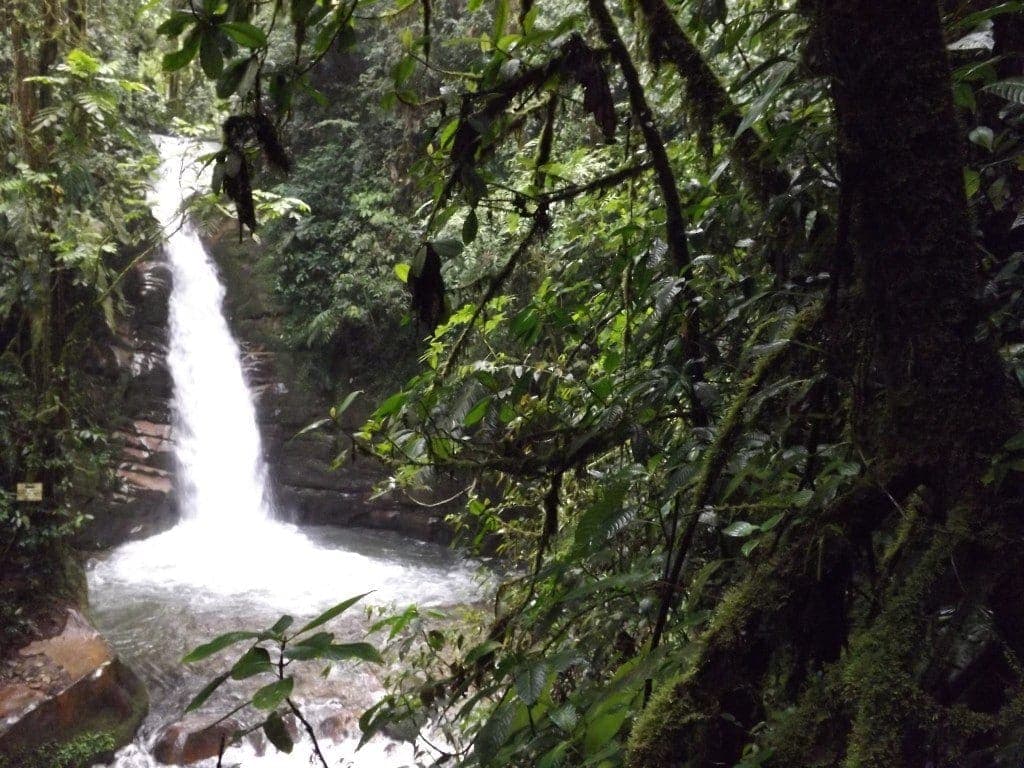
We came out of the forest to discover that it was raining, just as thick and heavy as the day before. The horses looked unfazed by the rain, but we wanted to avoid another soaking so Oscar helped us into thick ponchos made from a tent-like fabric, and we returned by the same route we’d come, shrouded in heavy tarpaulin with our vision blocked by cavernous hoods. On the return journey, we avoided the mountain road altogether and instead clambered up through a narrow, muddy chute-like path which was channelling so much rain water it might as well have been a river. The going was slippery and very steep, but Principe took it all in his stride, and we made it to the top in once piece.
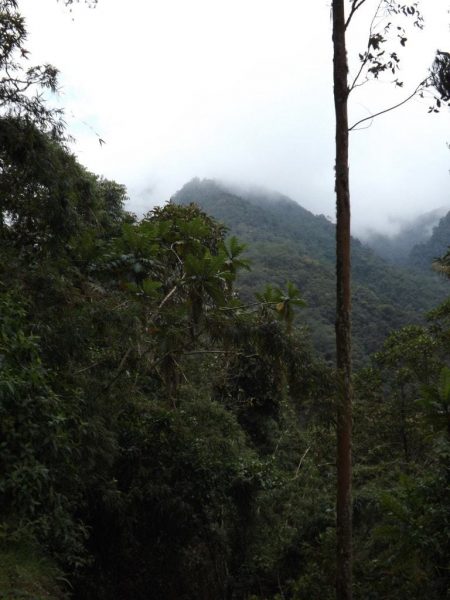
From here, in spite of the heavy grey skies and battering rain, we had a fantastic view of the valley on the other side of Salento, which was so full of clouds it seemed to be filling up. We headed back into the town, and Oscar invited us to sit in his house with his family for a cup of coffee while he sorted out the horses. The coffee was black, which I normally hate, but was also delicious – probably from one of the local plantations and very, very sweet.
After coffee, we had lunch in town while we waited for the rain to stop, before heading back to Yambolombia to dry off and spend the rest of the evening relaxing in the total peace of the gorgeous hostel, chatting to the other guests and to the owner Gabriel, a lovely man who has been my favourite host so far.
When we checked out the next morning, on a sunny day with blue skies that seemed to beg us to stay in beautiful Salento, we left with heavy hearts. The pain of travelling with a deadline is having to leave everywhere we fall in love with, but I’m adamant that we’ll be back in Salento one day soon. Gabriel gave us both bracelets woven with yellow, red and blue thread (the Colombia flag colours) to remember the hostel by, but we don’t need them. Our trip to Salento was a very special one that will stay in our hearts for the rest of our lives – until we get back there.
Sailing the Amazon River – Colombia to Peru by Boat
First Published: 11/4/2014
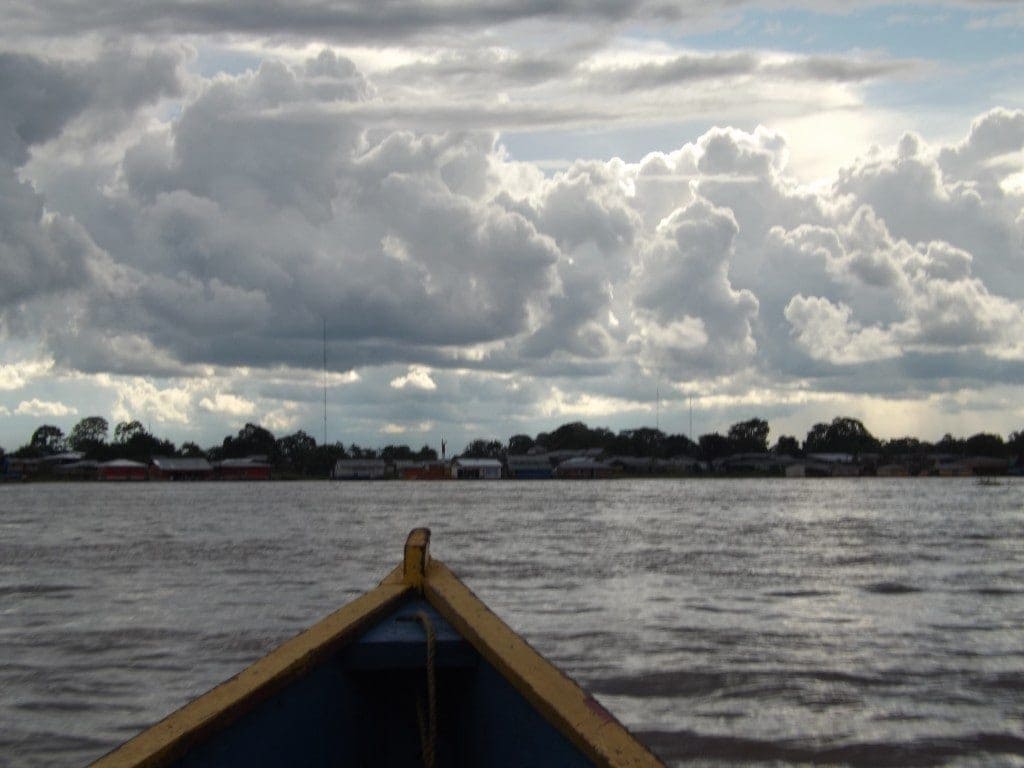
After leaving the gorgeous countryside surrounding the sleepy town in Salento, we had only a very brief stopover in Cali (which wasn’t long enough to see anything particularly exciting) before catching a flight early the next morning to the border town of Leticia, way down in the bottom right corner of Colombia: in the heart of the Amazon rainforest.
We had wanted to travel completely overland, with no internal flights, but there are no roads in the jungle and there was no other way to get to Leticia.
The two overland options we had for leaving Colombia were by bus through Ecuador, which would have been such a rushed trip that it seemed a little wasteful, or by boat down the Amazon river into Peru.
The second option sounded far too romantic to miss, so we opted for a short flight from Cali to Leticia via Bogota, and hopped straight from the green, cloudy countryside of the Andes into the vibrant and dazzlingly bright Amazon rainforest.
Sailing the Amazon River: Day One
I could smell it as soon as we stepped out of the plane at Leticia’s tiny airport; under the oil and engines were the scents of hot, wet leaves and damp earth, rich and woody.
The sun was blindingly bright and wickedly hot, the air was thick and humid, and the small airport was surrounded by a wall of green and brown: the edges of the endless, continent-sized blanket of emerald green we had glimpsed from the plane window.
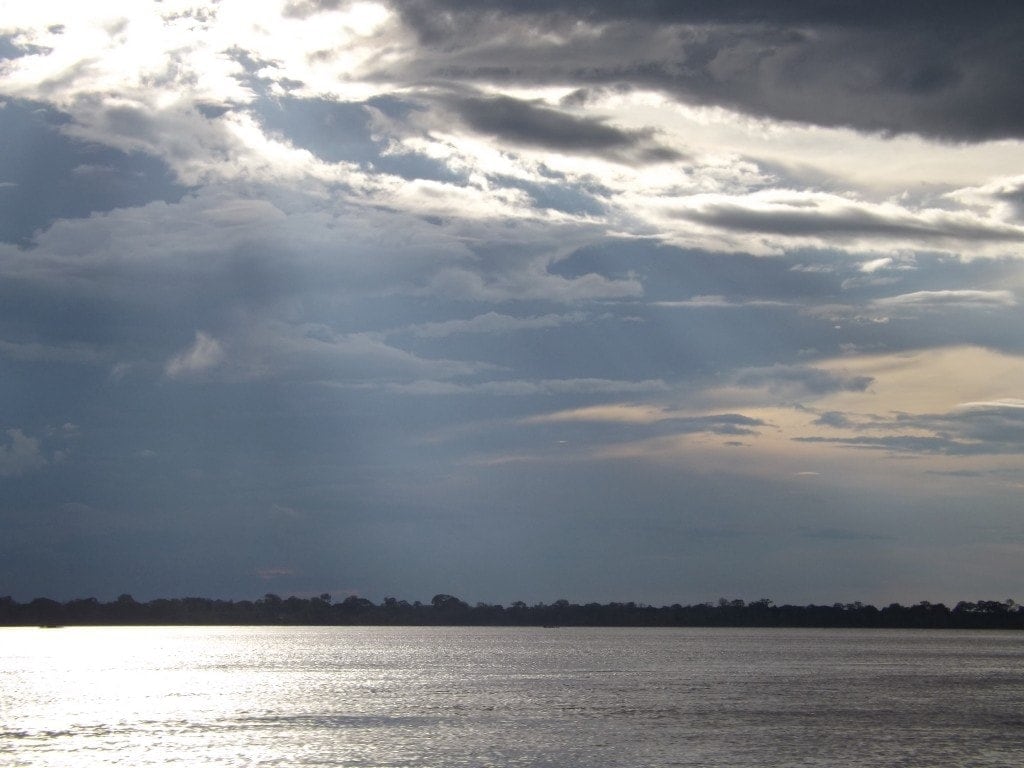
Where’s the Ticket Office?!
At the airport, we asked a taxi driver to take us to the ticket office for the ‘rapido’ – fast boat – to Iquitos in Peru, but when he said that the office was in Brazil we decided he must be completely insane and instead got out in Leticia’s town centre.
After an hour or so trying unsuccessfully to locate a ticket office, or an English speaker to give us some advice, we finally asked another taxi driver who confirmed what the first guy had told us. The ticket offices to buy tickets from Colombia to Peru are, of course, in Tabatinga, Brazil. As it turns out, this is less than a five-minute drive from Leticia’s centre, with no border control. Halfway down a normal-looking road, the driver said “we’re in Brazil now”, and that was that.
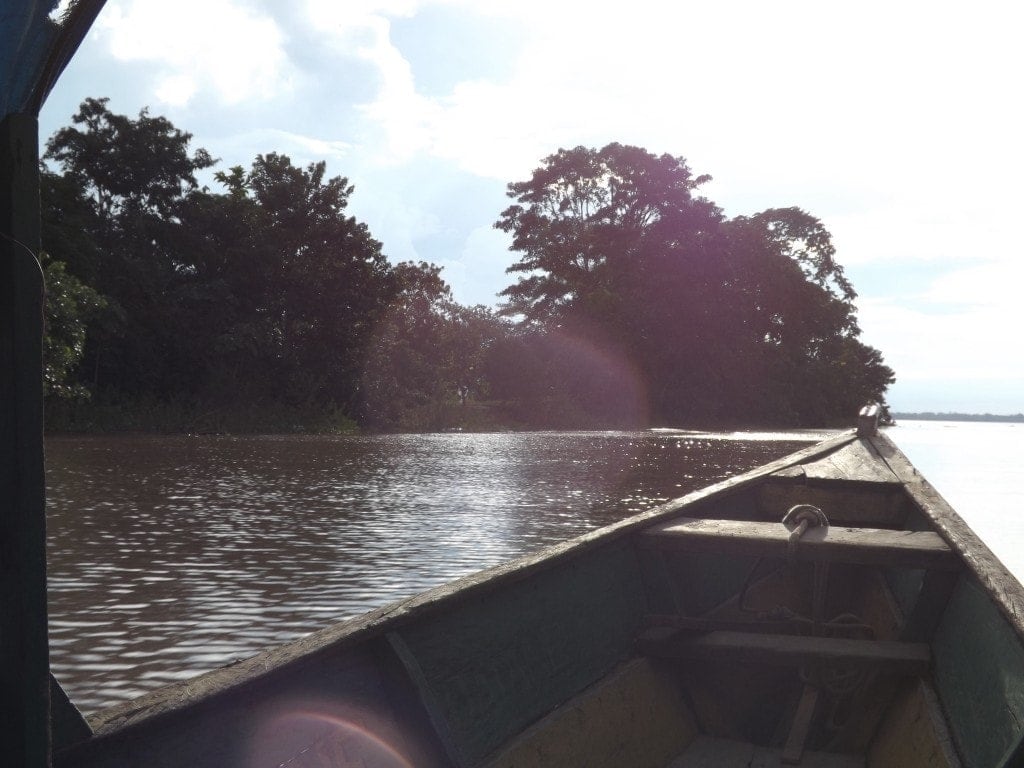
Having bought our tickets and moved from Colombia to Brazil and back again in less than twenty minutes, our taxi driver dropped us at the edge of the river and pointed out the ferry boat to Santa Rosa.
This is Peru’s border town and the boats to Iquitos set off from here. We sailed across the river in a small motorboat – wowed by an incredible scenery of coffee-coloured river lined with a belt of green and suddenly struck by the thrilling notion that we were in the Amazon – to grab a Peruvian entry stamp at the tiny immigration office, where we had to step over a sleeping dog to reach the desk. At some unclear point before or during the river crossing, we had entered Peru, so that in the space of one hour we had been in three different countries.
Amazon Wildlife Tour
Once we were completely organised, and the stress of not having a clue what we were doing had died down, we felt much better and decided to enjoy our first evening in the Amazon. We met a local tour guide who offered us an evening tour to spot wildlife, so we decided to do that (only realising later that the 100,000 COP pp – about £30 each – he charged us was a huge rip off).
He commissioned a local boy with a motor boat and we hopped in, setting off down the Amazon river as the sun was beginning to slip down the enormous expanse of sky that stretched over the low, flat landscape, lighting the sculpted clouds in red, gold, purple, pink.
The river was unbelievably wide, more like a lake, the colour of milky tea, and skirted by thin bands of green on either side that were thick and broodingly, silently alive, so rich with mysterious life they seemed to pulse with it even as they stretched, still and silent, into the distance.
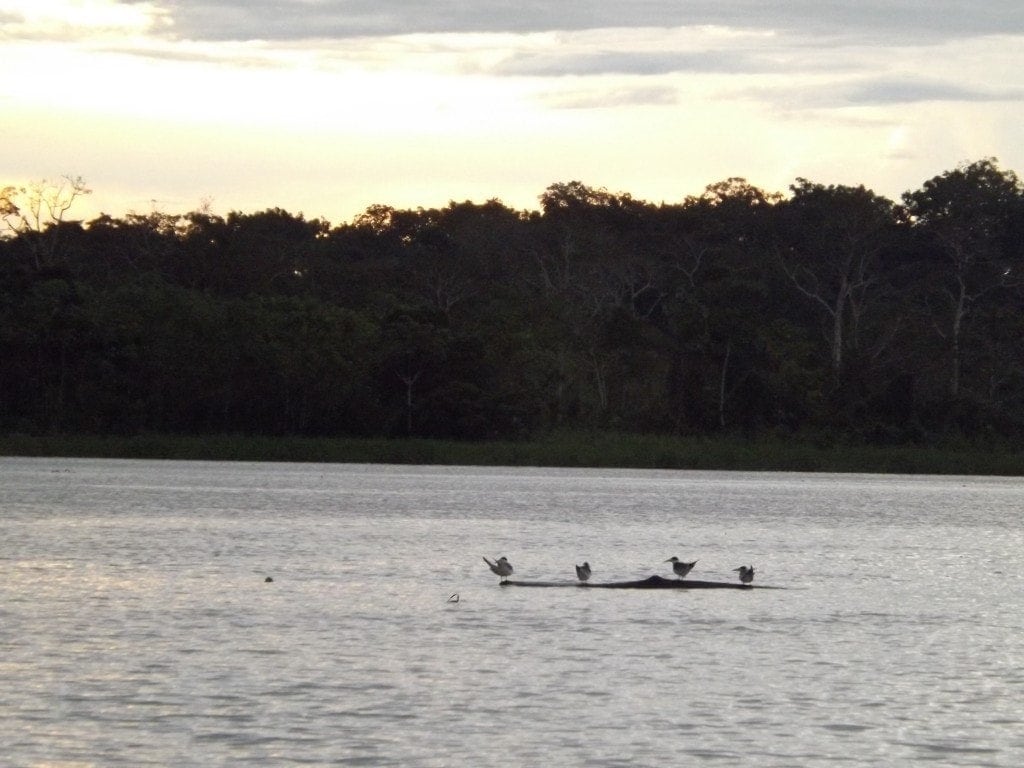
Suddenly, breaking the water and curling over in the golden light of the sunset, the dark shadow of a dolphin appeared, slow and graceful, quite close to our boat.
Too dark and too quick to tell if it was pink or grey, but smooth and beautiful in the dying light. We sailed upriver for an hour or more, and spotted more dolphins, only occasionally and always too quick for my camera, breaking the surface in tightly curled dives.
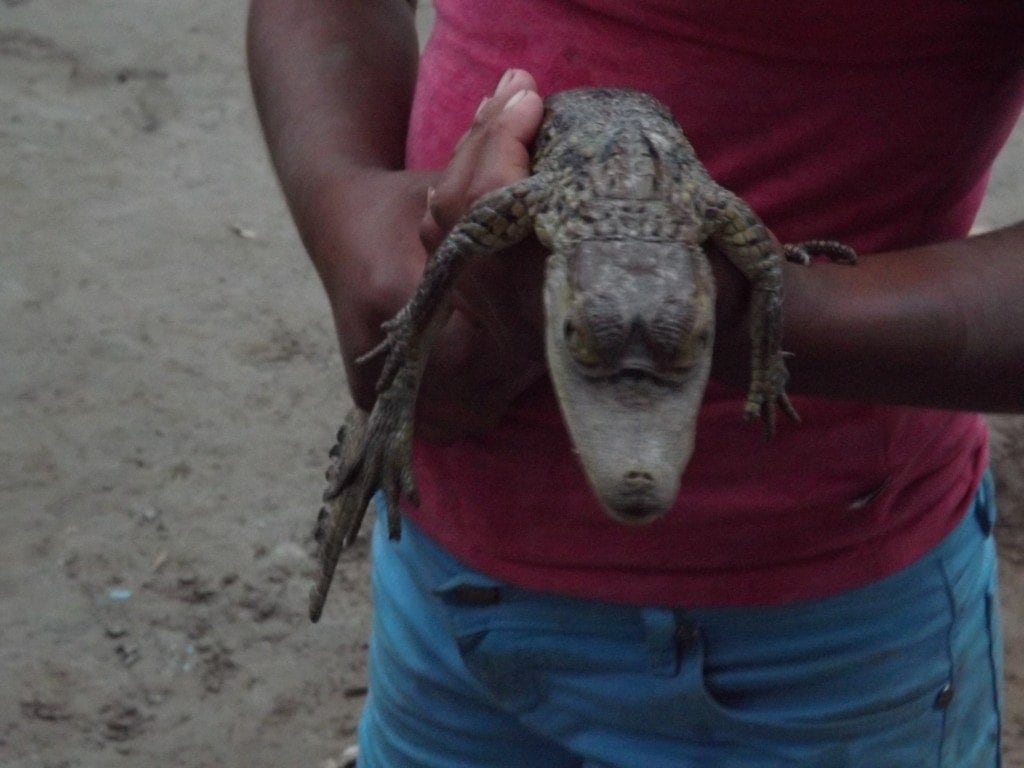
Animals in Captivity
Eventually, we stopped at a small village of wooden, stilted huts – many of which had only three walls – just as darkness was beginning to settle. The forest had become an impenetrable shadow and the sky was a dark bruise of blue clouds.
The villagers quickly surrounded us, a group of women and children holding animals for us to pet, hold, or stagger back from. A pig-nosed prehistoric turtle, warty and weird with a flat, spade-shaped head. Baby caimans with their calm smiles and cold, intelligent eyes that seemed to watch us knowingly.
A little boy with huge dark eyes held a baby monkey on his shoulder, but when Sam held it the monkey wriggled and raced over him, trying to bite. A big sloth that sat still like a teddy bear and let us hold him without moving, smiling like a stoned teenager, a scruffy porcupine coated with needles, two anacondas whose strength I could feel as I held them on my shoulders.
Now it was night fully, and we walked with the guide first to a lake filled with huge lilypads, then to a big paddling pool home to a baby manatee, which looked like a swimming pig with thick, spiny hairs dotted across its head.
It circled the pool restlessly and poked its strange, slippery face up to look at us, and I hated to see it away from its mother in a too-small pool, wondering if it was properly cared for. Although it was cool to see so many animals up close, I hadn’t been expecting to see them in captivity, domesticated and docile, and it wasn’t quite the tour we’d hoped for.
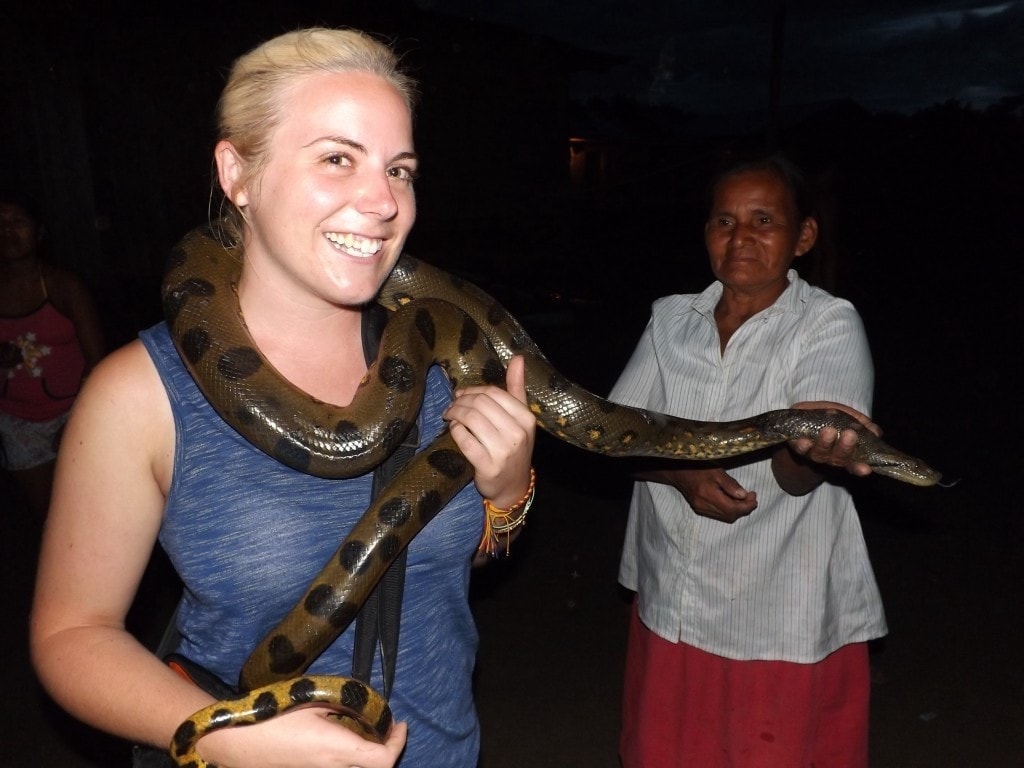
We sailed back to Santa Rosa down a dark river, watching flashes of lightning tear across the sky in the distance, lighting the horizon in every direction as though we were surrounded by storm.
The trip was beginning to feel like a true adventure; everything since stepping off the plane had been as surreal and as strange as you’d expect a day in the Amazon to be.
Day Two: Colombia to Peru by Boat
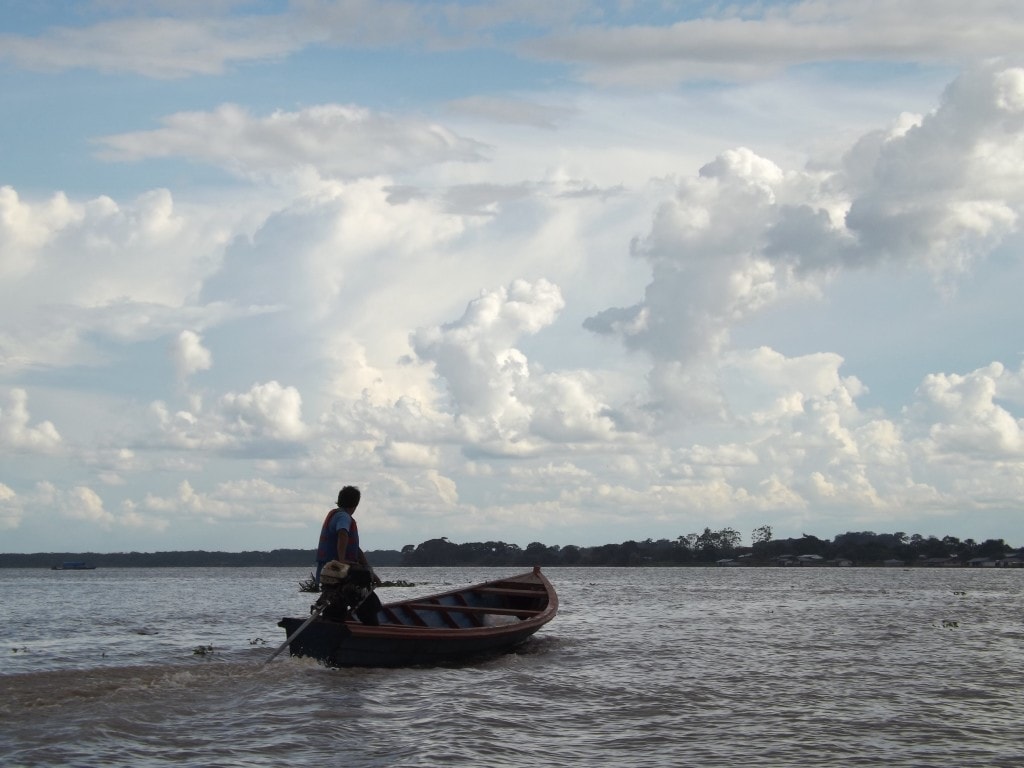
We were in the rainforest, and although the Amazon was exciting and mysterious it was also humid, uncomfortable, and strange.
The overland route from Colombia to Peru, down the Amazon River from Leticia on the Colombian border to Iquitos in the heart of the Peruvian Amazon, sounded so romantic and adventurous that it was impossible to resist, but the realities of it were difficult – adding to the adventure but also causing a bit of stress and taking some of the thrill out.
After a few hours sleep in a horrible – but very cheap – hotel room, where the electricity cut out in the night leaving us with no fan, so that we slept fitfully and drenched in sweat, we were woken by a loud knocking at the door. The hotel staff insisted that we had to leave for the boat at 2am, although our tickets confirmed it left at 3:30am and that we needed to be at the port (directly opposite our hotel) for 3am. Even when we showed them the tickets, the staff still insisted we leave, with such concern and urgency that we assumed the boat times must have changed.
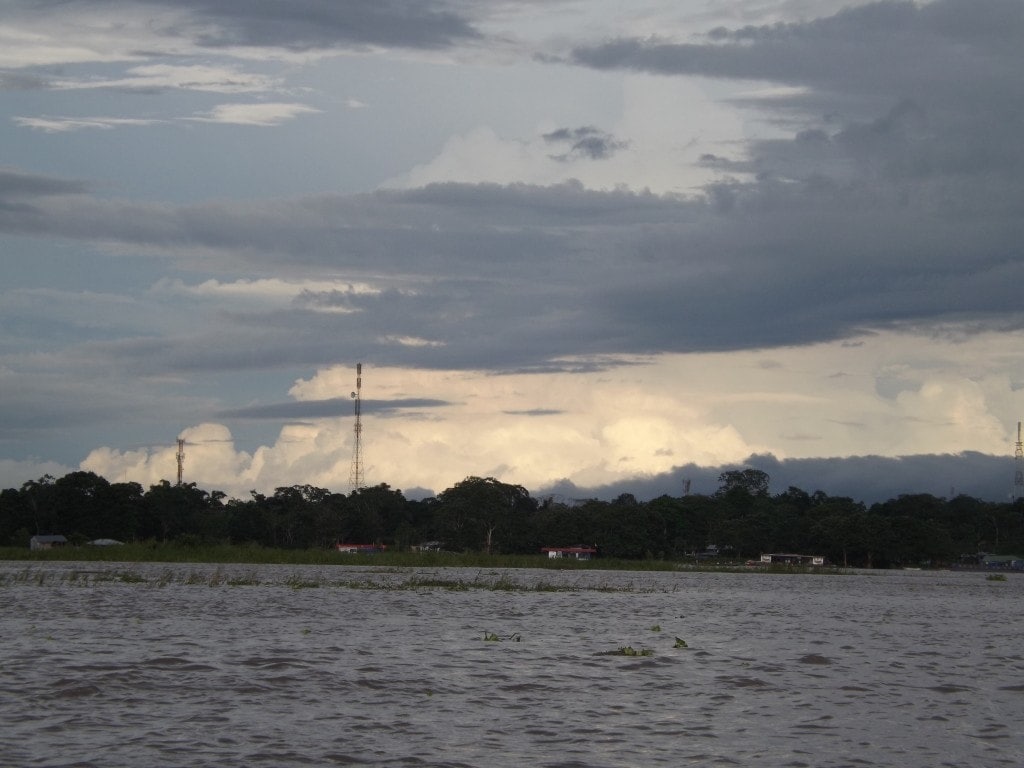
So, we stumbled out into the darkness with our heavy bags, bleary-eyed and sick from lack of sleep, and onto a small wooden deck with about thirty other passengers, most of whom were asleep, beside a silent and unstaffed Transtur boat. Of course, it wasn’t leaving until 3:30am, and they didn’t start boarding until 3:25, so we sat for over an hour in the stifled, humid darkness, confused and very, very overtired.
Sailing from Colombia to Peru
Eventually, though, we were on the boat – a narrow, bus-like motorboat with too many seats crammed in close together. We were too tired to be uncomfortable, and fell asleep before the boat had even started moving. I woke up around 7am to a cup of coffee and a chicken sandwich, and found that we were flying along the Amazon river, which through the dirty window was a grey brown under an oppressive white sky.
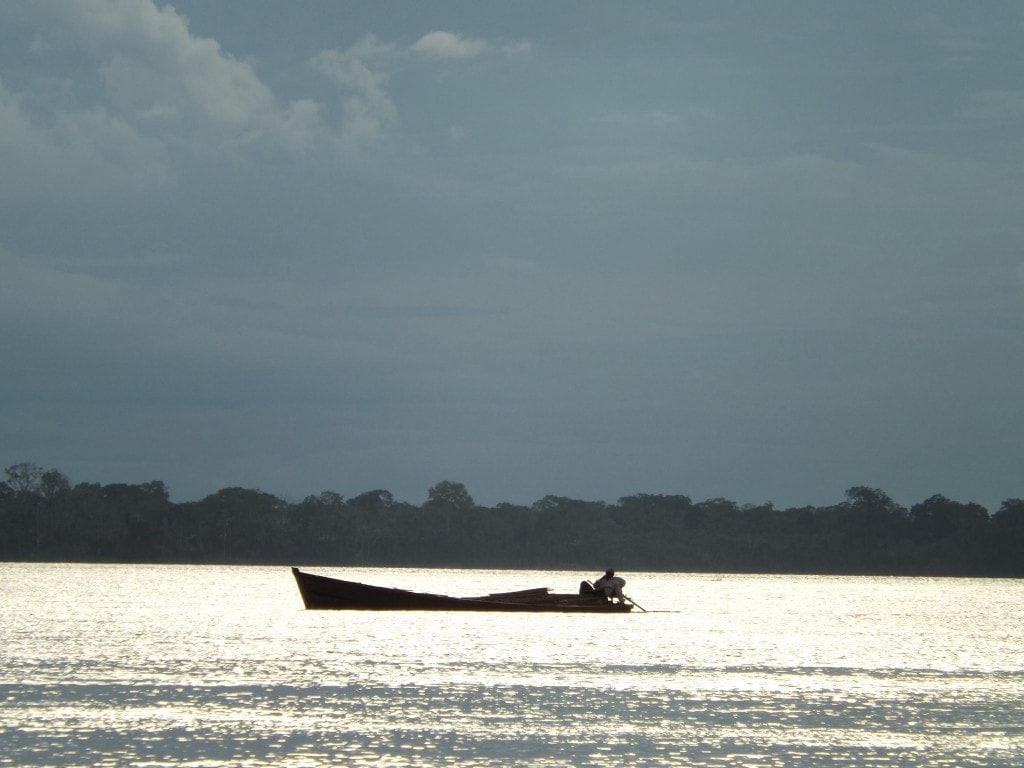
Far on the other side of the wide river, the unbroken green of the rainforest raced by in a blur, steady and unchanging. I scanned the choppy water for dolphins, but had no luck, and for hours alternated between reading and watching the landscape sweep by, always the same view, like the background in a Tom and Jerry chase scene. Strangely, it didn’t become boring; although it never seemed to change the landscape was always different, the surface of the river changed as the light did, getting lighter and sparkling as the day grew brighter. The forest in the distance seemed ever brooding and mysterious; not just a band of green but something dark and full of life, of secrets.
Into the Amazon

By late afternoon, stiff from travel, uncomfortable, and slightly motion sick, I still hadn’t had my fill of the landscape, but I was bored of sitting down. The ugly, grey port of Iquitos looked beautiful to me, the smoke and boats and concrete buildings meant land, roads, movement from the position I’d been stuck in for twelve hours. It was a strange contrast, one of the worst journeys of my life and at the same time one of the best. Adventure is like that – romantic but also uncomfortable, exciting but difficult – and I suppose it’s the hardships that make the journey worth it, in the end.
READ MORE: How to Sail the Amazon from Colombia to Peru




Emily! This is great news! Welcome to Bogotá! How long are you guys planning on living/visiting the city…the country? I and several friends have lived in Bogotá for almost 3.5 years and I think we’re pretty much planning to stay. Granted, a really great friend of mine is actually leaving to study linguistics in London. If you’ve got any inquiries on shit drop me an email or something. Also, I’m Kofi Adoko on Facebook! Que te disfrutas la experiencia, los sueños y alcances a descubrir lo mejor de la ciudad y del país. Un abrazo.
Thank you! We’re here in Colombia about a month before we head off around the rest of South America – in Bogota till Monday and then heading to the coast by way of Bucaramanga.
If you have any recommendations for a cool/cheap bar in the La Candelaria neighbourhood tonight that would be great – we’re trying to find something to do!
Ooopsies! I got this message late! :( Ahh, well I hope you found a great place regardless. I’ll definitely continue following your blog and living vicariously through you and your experiences. Godspeed and safe travels.
great town used to go often, stay by shopping santa barbara at aparthotel. Enjoy it and do see the gold museum and the little train to boyaca